Physical and Emotional Wellbeing
VerifiedAdded on 2023/06/06
|49
|10110
|158
AI Summary
This assessment addresses the following unit of competency: CHCECE003 – Provide care for children and CHCECE005 – Provide care for babies and toddlers. The questions in this workbook are divided into two (2) categories: Knowledge Assessment and Case Study.
Contribute Materials
Your contribution can guide someone’s learning journey. Share your
documents today.
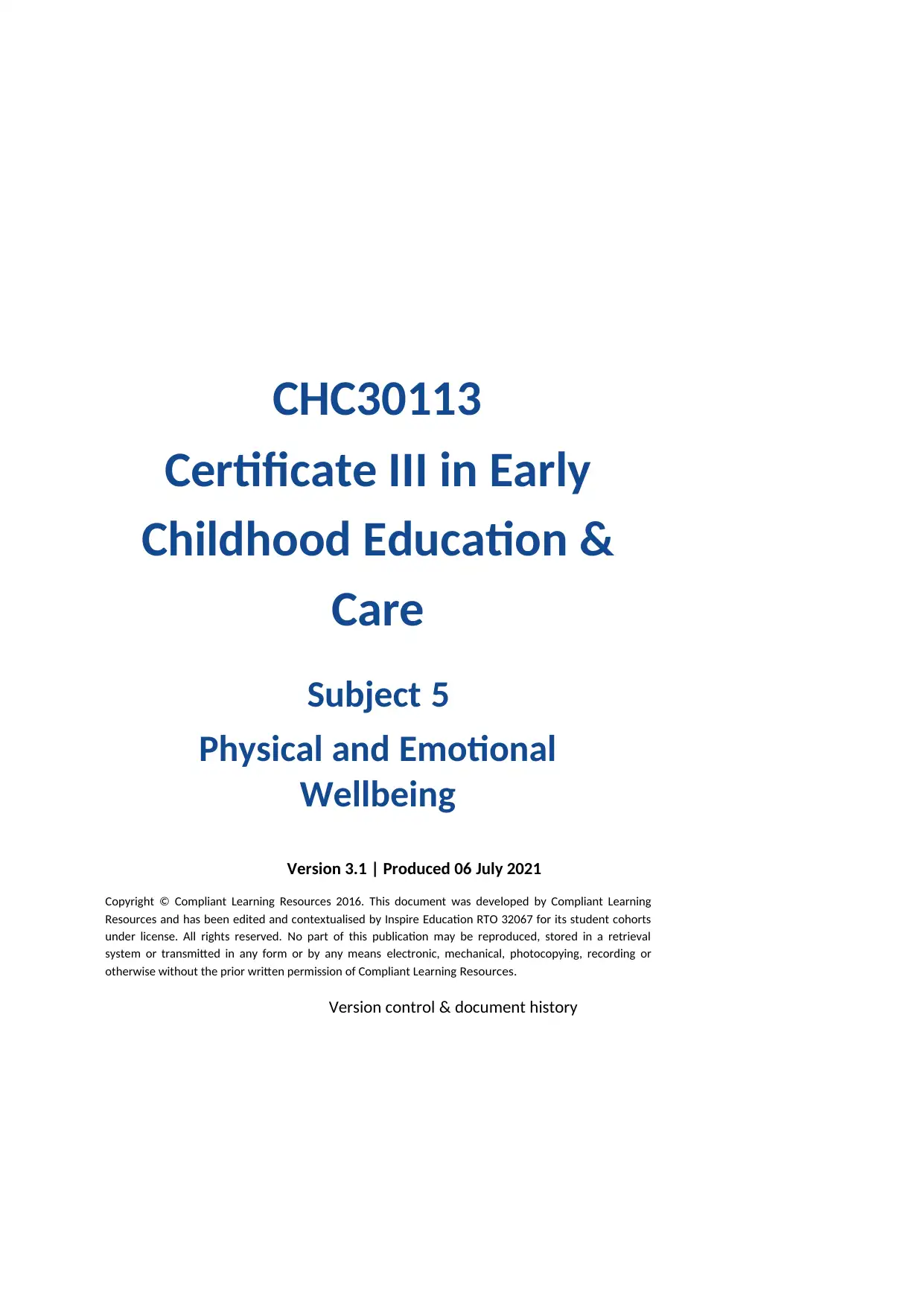
CHC30113
Certificate III in Early
Childhood Education &
Care
Subject 5
Physical and Emotional
Wellbeing
Version 3.1 | Produced 06 July 2021
Copyright © Compliant Learning Resources 2016. This document was developed by Compliant Learning
Resources and has been edited and contextualised by Inspire Education RTO 32067 for its student cohorts
under license. All rights reserved. No part of this publication may be reproduced, stored in a retrieval
system or transmitted in any form or by any means electronic, mechanical, photocopying, recording or
otherwise without the prior written permission of Compliant Learning Resources.
Version control & document history
Certificate III in Early
Childhood Education &
Care
Subject 5
Physical and Emotional
Wellbeing
Version 3.1 | Produced 06 July 2021
Copyright © Compliant Learning Resources 2016. This document was developed by Compliant Learning
Resources and has been edited and contextualised by Inspire Education RTO 32067 for its student cohorts
under license. All rights reserved. No part of this publication may be reproduced, stored in a retrieval
system or transmitted in any form or by any means electronic, mechanical, photocopying, recording or
otherwise without the prior written permission of Compliant Learning Resources.
Version control & document history
Secure Best Marks with AI Grader
Need help grading? Try our AI Grader for instant feedback on your assignments.
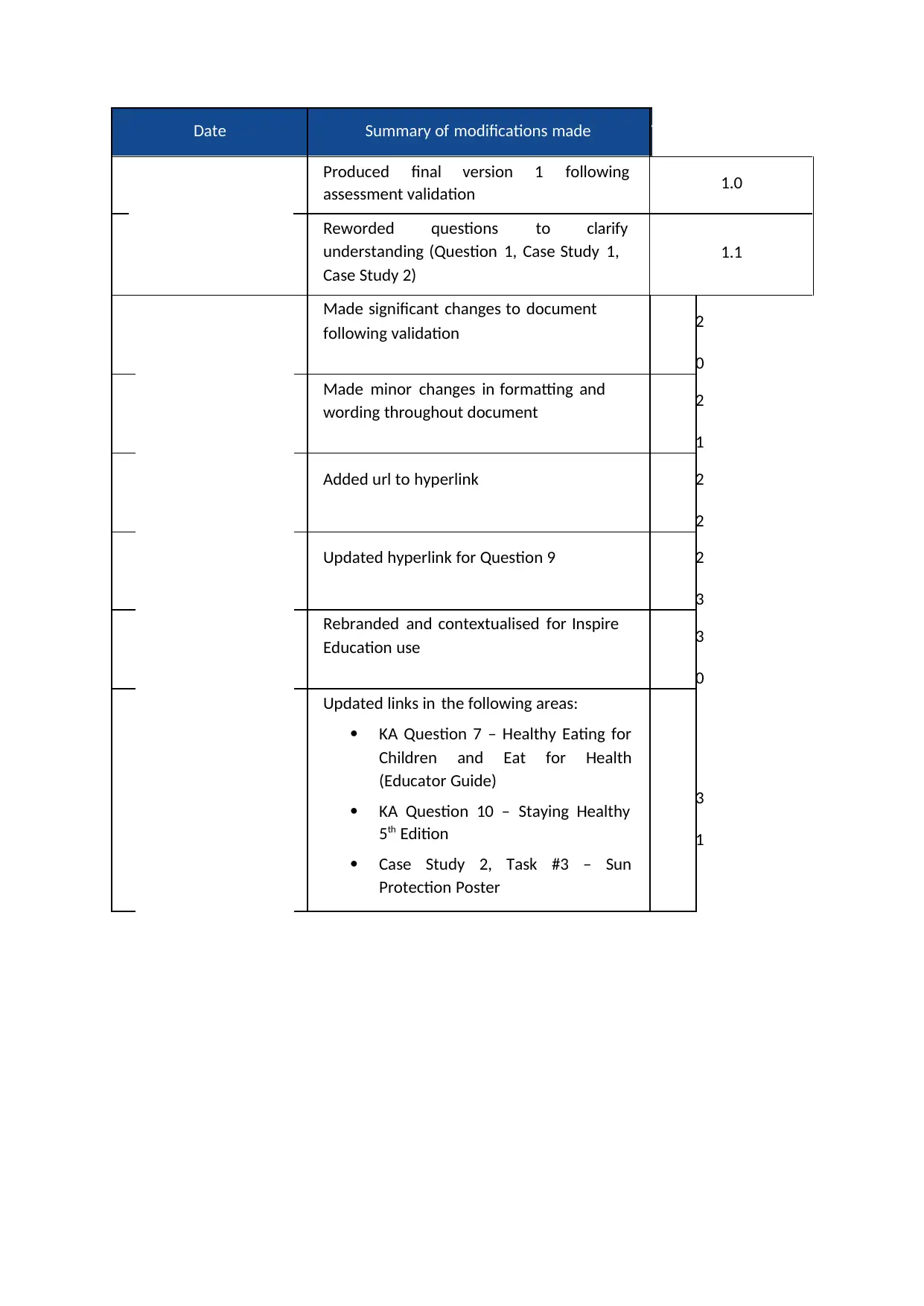
Date Summary of modifications made Version
Produced final version 1 following
assessment validation 1.0
Reworded questions to clarify
understanding (Question 1, Case Study 1,
Case Study 2)
1.1
Made significant changes to document
following validation 2
0
Made minor changes in formatting and
wording throughout document 2
1
Added url to hyperlink 2
2
Updated hyperlink for Question 9 2
3
Rebranded and contextualised for Inspire
Education use 3
0
Updated links in the following areas:
KA Question 7 – Healthy Eating for
Children and Eat for Health
(Educator Guide)
KA Question 10 – Staying Healthy
5th Edition
Case Study 2, Task #3 – Sun
Protection Poster
3
1
Produced final version 1 following
assessment validation 1.0
Reworded questions to clarify
understanding (Question 1, Case Study 1,
Case Study 2)
1.1
Made significant changes to document
following validation 2
0
Made minor changes in formatting and
wording throughout document 2
1
Added url to hyperlink 2
2
Updated hyperlink for Question 9 2
3
Rebranded and contextualised for Inspire
Education use 3
0
Updated links in the following areas:
KA Question 7 – Healthy Eating for
Children and Eat for Health
(Educator Guide)
KA Question 10 – Staying Healthy
5th Edition
Case Study 2, Task #3 – Sun
Protection Poster
3
1
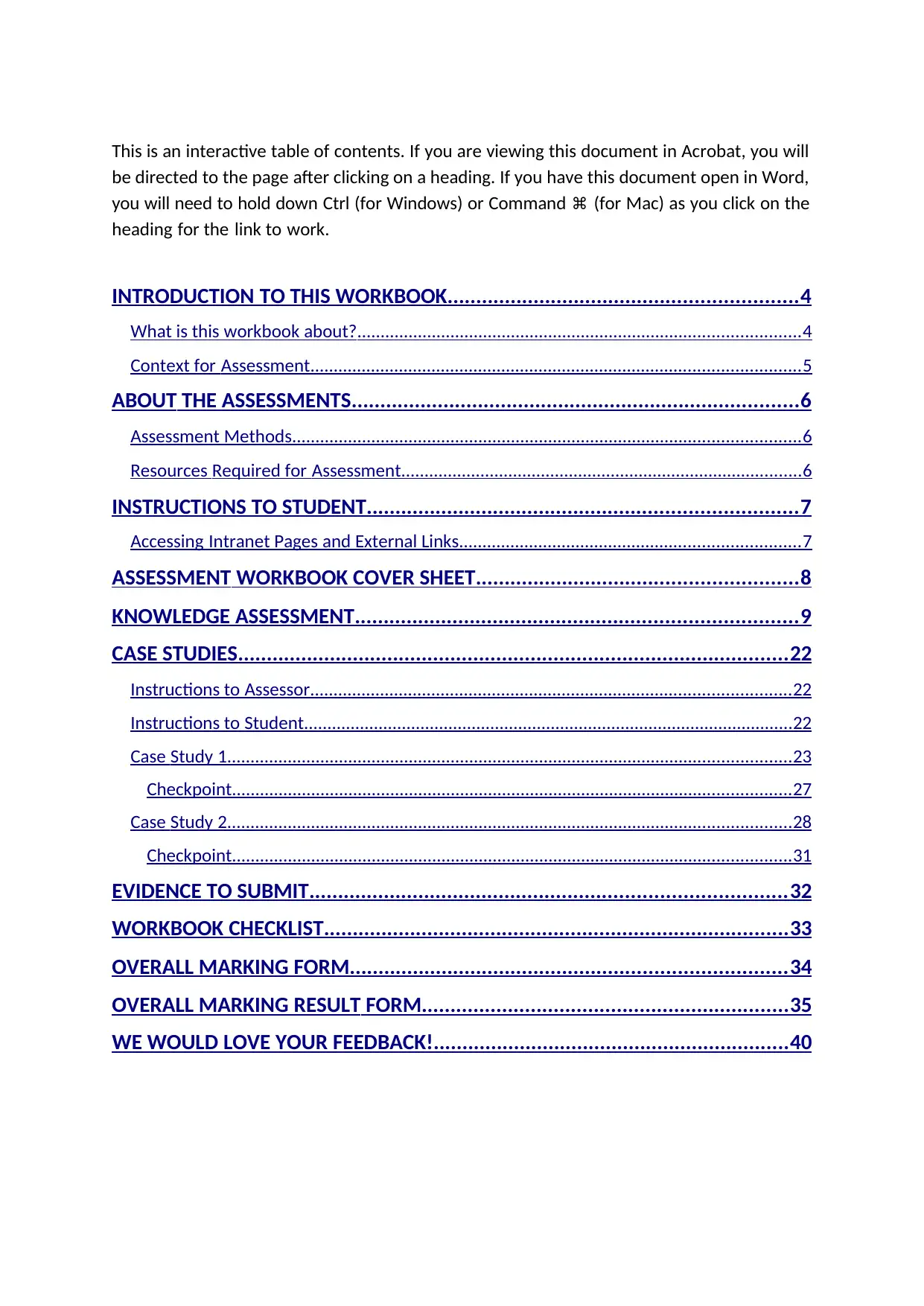
This is an interactive table of contents. If you are viewing this document in Acrobat, you will
be directed to the page after clicking on a heading. If you have this document open in Word,
you will need to hold down Ctrl (for Windows) or Command ⌘ (for Mac) as you click on the
heading for the link to work.
INTRODUCTION TO THIS WORKBOOK.............................................................4
What is this workbook about?...............................................................................................4
Context for Assessment.........................................................................................................5
ABOUT THE ASSESSMENTS..............................................................................6
Assessment Methods.............................................................................................................6
Resources Required for Assessment......................................................................................6
INSTRUCTIONS TO STUDENT...........................................................................7
Accessing Intranet Pages and External Links.........................................................................7
ASSESSMENT WORKBOOK COVER SHEET........................................................8
KNOWLEDGE ASSESSMENT.............................................................................9
CASE STUDIES................................................................................................22
Instructions to Assessor.......................................................................................................22
Instructions to Student.........................................................................................................22
Case Study 1.........................................................................................................................23
Checkpoint........................................................................................................................27
Case Study 2.........................................................................................................................28
Checkpoint........................................................................................................................31
EVIDENCE TO SUBMIT...................................................................................32
WORKBOOK CHECKLIST.................................................................................33
OVERALL MARKING FORM............................................................................34
OVERALL MARKING RESULT FORM................................................................35
WE WOULD LOVE YOUR FEEDBACK!..............................................................40
be directed to the page after clicking on a heading. If you have this document open in Word,
you will need to hold down Ctrl (for Windows) or Command ⌘ (for Mac) as you click on the
heading for the link to work.
INTRODUCTION TO THIS WORKBOOK.............................................................4
What is this workbook about?...............................................................................................4
Context for Assessment.........................................................................................................5
ABOUT THE ASSESSMENTS..............................................................................6
Assessment Methods.............................................................................................................6
Resources Required for Assessment......................................................................................6
INSTRUCTIONS TO STUDENT...........................................................................7
Accessing Intranet Pages and External Links.........................................................................7
ASSESSMENT WORKBOOK COVER SHEET........................................................8
KNOWLEDGE ASSESSMENT.............................................................................9
CASE STUDIES................................................................................................22
Instructions to Assessor.......................................................................................................22
Instructions to Student.........................................................................................................22
Case Study 1.........................................................................................................................23
Checkpoint........................................................................................................................27
Case Study 2.........................................................................................................................28
Checkpoint........................................................................................................................31
EVIDENCE TO SUBMIT...................................................................................32
WORKBOOK CHECKLIST.................................................................................33
OVERALL MARKING FORM............................................................................34
OVERALL MARKING RESULT FORM................................................................35
WE WOULD LOVE YOUR FEEDBACK!..............................................................40
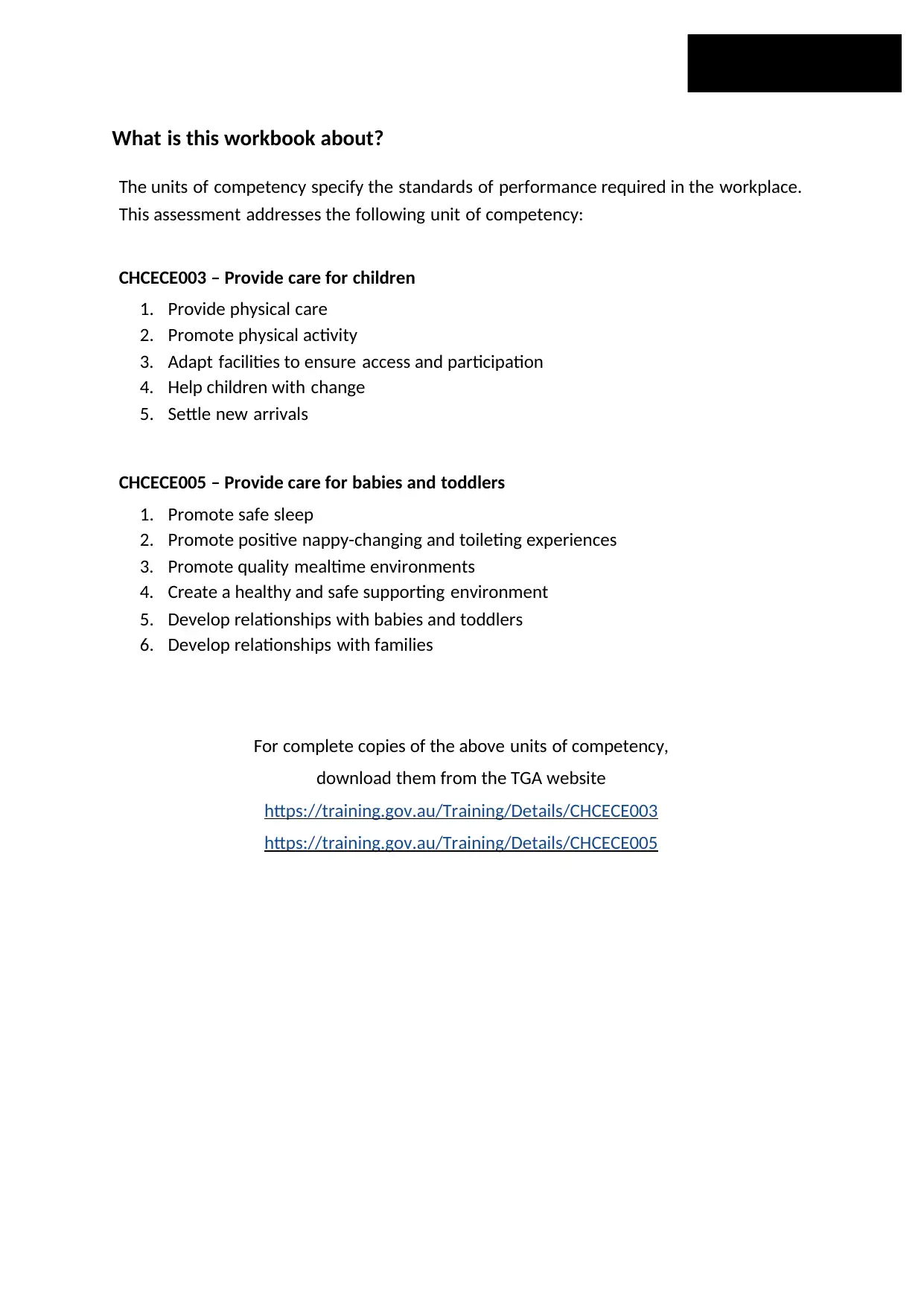
What is this workbook about?
The units of competency specify the standards of performance required in the workplace.
This assessment addresses the following unit of competency:
CHCECE003 – Provide care for children
1. Provide physical care
2. Promote physical activity
3. Adapt facilities to ensure access and participation
4. Help children with change
5. Settle new arrivals
CHCECE005 – Provide care for babies and toddlers
1. Promote safe sleep
2. Promote positive nappy-changing and toileting experiences
3. Promote quality mealtime environments
4. Create a healthy and safe supporting environment
5. Develop relationships with babies and toddlers
6. Develop relationships with families
For complete copies of the above units of competency,
download them from the TGA website
https://training.gov.au/Training/Details/CHCECE003
https://training.gov.au/Training/Details/CHCECE005
The units of competency specify the standards of performance required in the workplace.
This assessment addresses the following unit of competency:
CHCECE003 – Provide care for children
1. Provide physical care
2. Promote physical activity
3. Adapt facilities to ensure access and participation
4. Help children with change
5. Settle new arrivals
CHCECE005 – Provide care for babies and toddlers
1. Promote safe sleep
2. Promote positive nappy-changing and toileting experiences
3. Promote quality mealtime environments
4. Create a healthy and safe supporting environment
5. Develop relationships with babies and toddlers
6. Develop relationships with families
For complete copies of the above units of competency,
download them from the TGA website
https://training.gov.au/Training/Details/CHCECE003
https://training.gov.au/Training/Details/CHCECE005
Secure Best Marks with AI Grader
Need help grading? Try our AI Grader for instant feedback on your assignments.
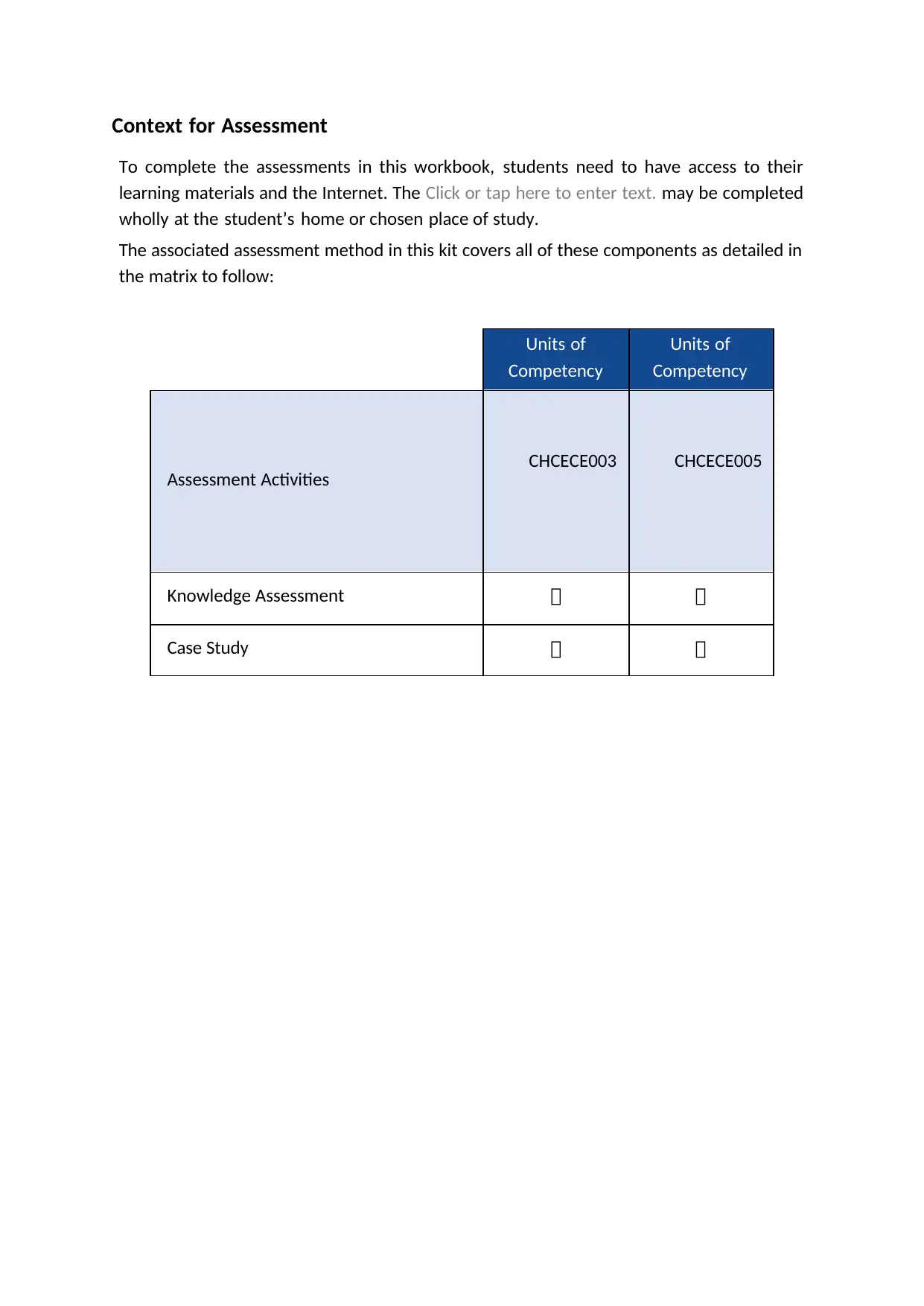
Context for Assessment
To complete the assessments in this workbook, students need to have access to their
learning materials and the Internet. The Click or tap here to enter text. may be completed
wholly at the student’s home or chosen place of study.
The associated assessment method in this kit covers all of these components as detailed in
the matrix to follow:
Units of
Competency
Units of
Competency
Assessment Activities CHCECE003 CHCECE005
Knowledge Assessment
Case Study
To complete the assessments in this workbook, students need to have access to their
learning materials and the Internet. The Click or tap here to enter text. may be completed
wholly at the student’s home or chosen place of study.
The associated assessment method in this kit covers all of these components as detailed in
the matrix to follow:
Units of
Competency
Units of
Competency
Assessment Activities CHCECE003 CHCECE005
Knowledge Assessment
Case Study
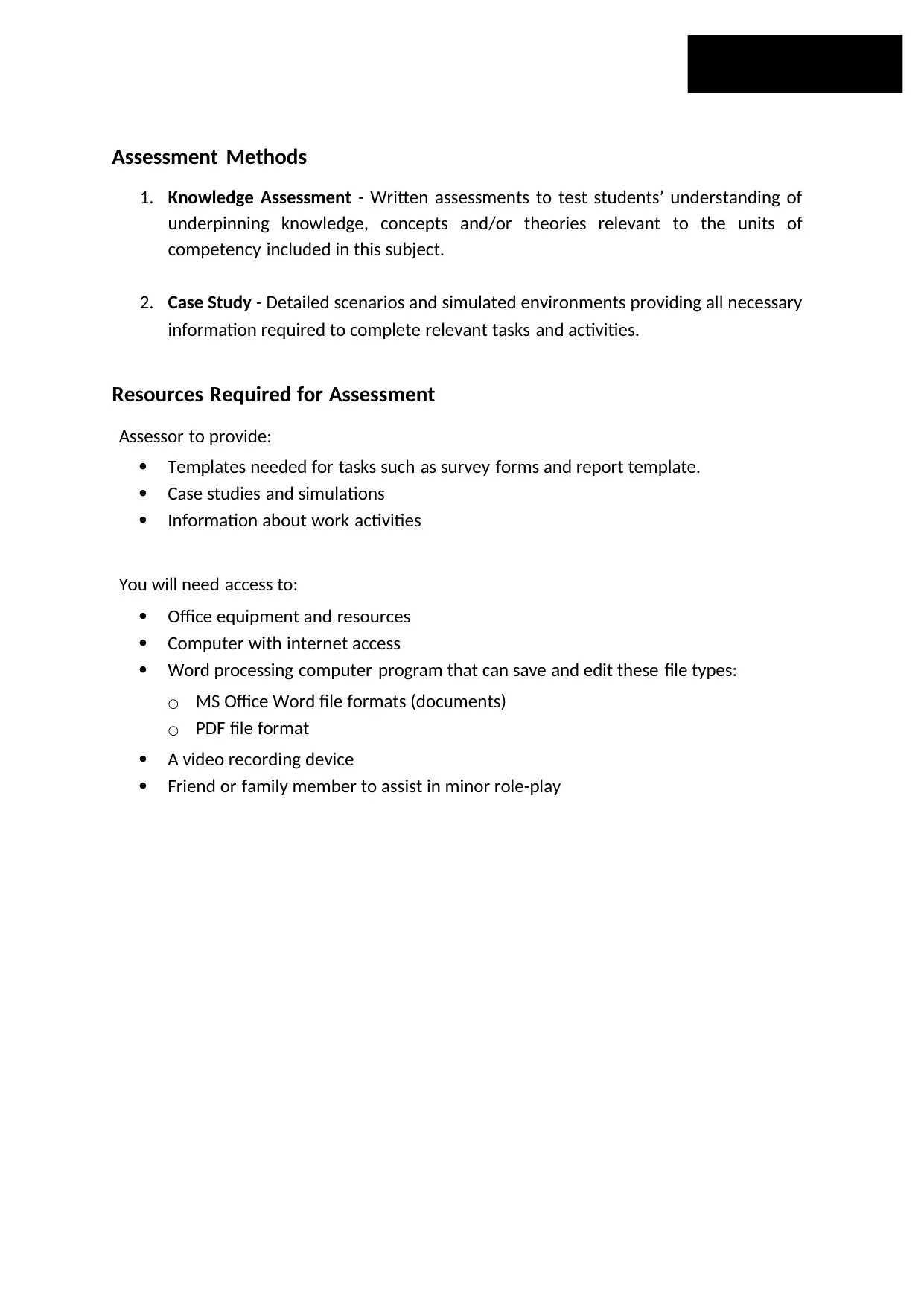
Assessment Methods
1. Knowledge Assessment - Written assessments to test students’ understanding of
underpinning knowledge, concepts and/or theories relevant to the units of
competency included in this subject.
2. Case Study - Detailed scenarios and simulated environments providing all necessary
information required to complete relevant tasks and activities.
Resources Required for Assessment
Assessor to provide:
Templates needed for tasks such as survey forms and report template.
Case studies and simulations
Information about work activities
You will need access to:
Office equipment and resources
Computer with internet access
Word processing computer program that can save and edit these file types:
○ MS Office Word file formats (documents)
○ PDF file format
A video recording device
Friend or family member to assist in minor role-play
1. Knowledge Assessment - Written assessments to test students’ understanding of
underpinning knowledge, concepts and/or theories relevant to the units of
competency included in this subject.
2. Case Study - Detailed scenarios and simulated environments providing all necessary
information required to complete relevant tasks and activities.
Resources Required for Assessment
Assessor to provide:
Templates needed for tasks such as survey forms and report template.
Case studies and simulations
Information about work activities
You will need access to:
Office equipment and resources
Computer with internet access
Word processing computer program that can save and edit these file types:
○ MS Office Word file formats (documents)
○ PDF file format
A video recording device
Friend or family member to assist in minor role-play
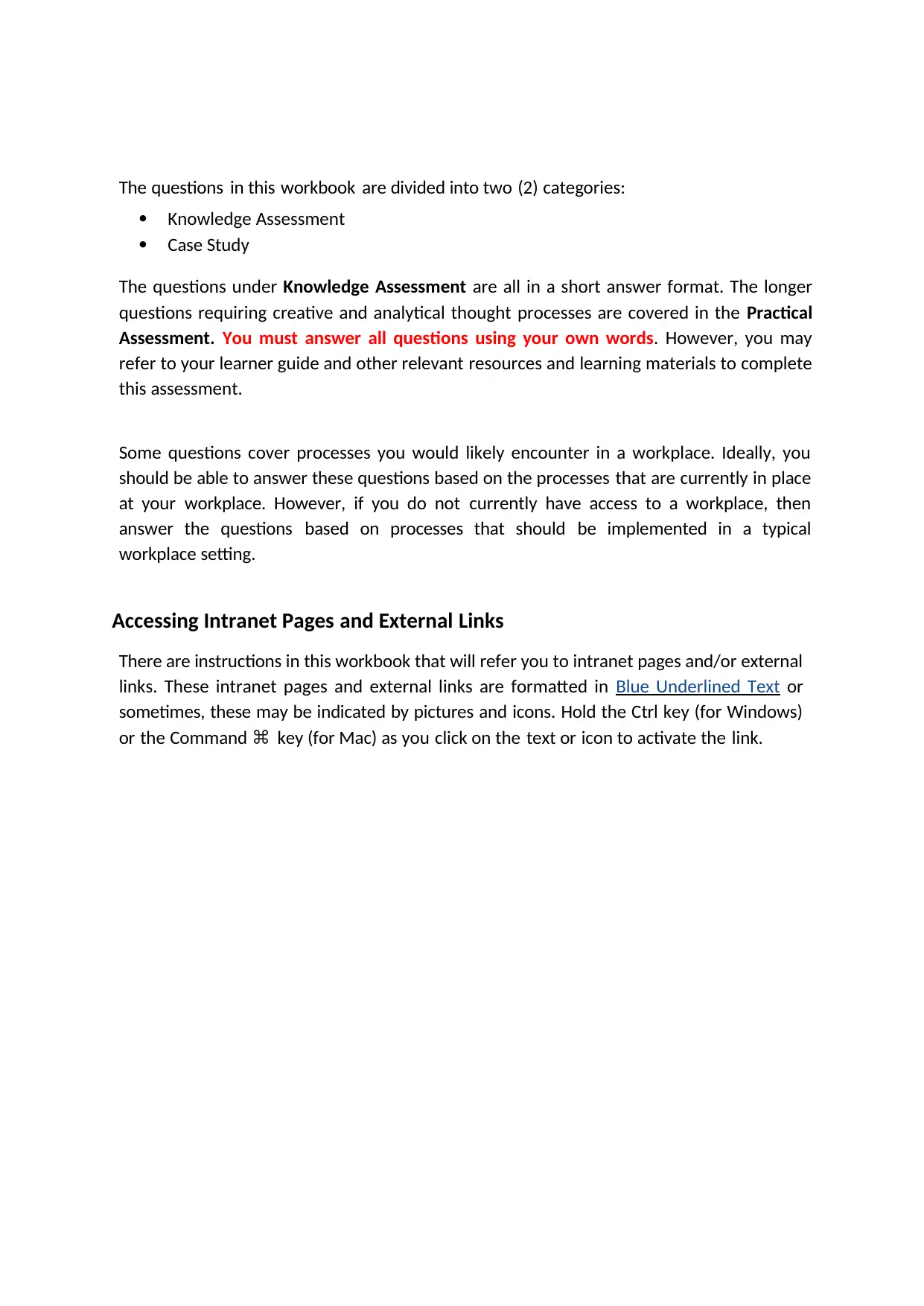
The questions in this workbook are divided into two (2) categories:
Knowledge Assessment
Case Study
The questions under Knowledge Assessment are all in a short answer format. The longer
questions requiring creative and analytical thought processes are covered in the Practical
Assessment. You must answer all questions using your own words. However, you may
refer to your learner guide and other relevant resources and learning materials to complete
this assessment.
Some questions cover processes you would likely encounter in a workplace. Ideally, you
should be able to answer these questions based on the processes that are currently in place
at your workplace. However, if you do not currently have access to a workplace, then
answer the questions based on processes that should be implemented in a typical
workplace setting.
Accessing Intranet Pages and External Links
There are instructions in this workbook that will refer you to intranet pages and/or external
links. These intranet pages and external links are formatted in Blue Underlined Text or
sometimes, these may be indicated by pictures and icons. Hold the Ctrl key (for Windows)
or the Command ⌘ key (for Mac) as you click on the text or icon to activate the link.
Knowledge Assessment
Case Study
The questions under Knowledge Assessment are all in a short answer format. The longer
questions requiring creative and analytical thought processes are covered in the Practical
Assessment. You must answer all questions using your own words. However, you may
refer to your learner guide and other relevant resources and learning materials to complete
this assessment.
Some questions cover processes you would likely encounter in a workplace. Ideally, you
should be able to answer these questions based on the processes that are currently in place
at your workplace. However, if you do not currently have access to a workplace, then
answer the questions based on processes that should be implemented in a typical
workplace setting.
Accessing Intranet Pages and External Links
There are instructions in this workbook that will refer you to intranet pages and/or external
links. These intranet pages and external links are formatted in Blue Underlined Text or
sometimes, these may be indicated by pictures and icons. Hold the Ctrl key (for Windows)
or the Command ⌘ key (for Mac) as you click on the text or icon to activate the link.
Paraphrase This Document
Need a fresh take? Get an instant paraphrase of this document with our AI Paraphraser
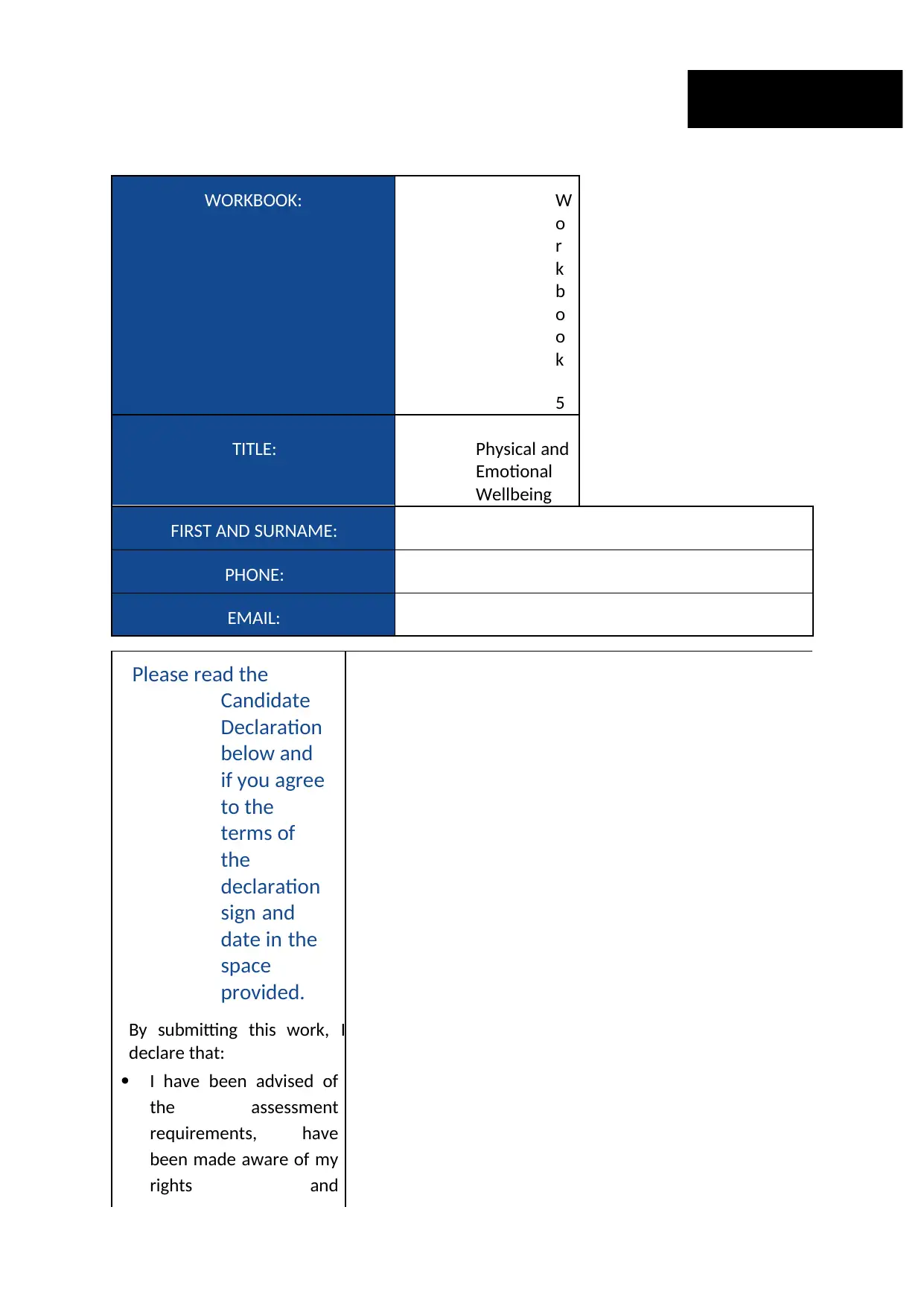
WORKBOOK: W
o
r
k
b
o
o
k
5
TITLE: Physical and
Emotional
Wellbeing
FIRST AND SURNAME:
PHONE:
EMAIL:
Please read the
Candidate
Declaration
below and
if you agree
to the
terms of
the
declaration
sign and
date in the
space
provided.
By submitting this work, I
declare that:
I have been advised of
the assessment
requirements, have
been made aware of my
rights and
o
r
k
b
o
o
k
5
TITLE: Physical and
Emotional
Wellbeing
FIRST AND SURNAME:
PHONE:
EMAIL:
Please read the
Candidate
Declaration
below and
if you agree
to the
terms of
the
declaration
sign and
date in the
space
provided.
By submitting this work, I
declare that:
I have been advised of
the assessment
requirements, have
been made aware of my
rights and
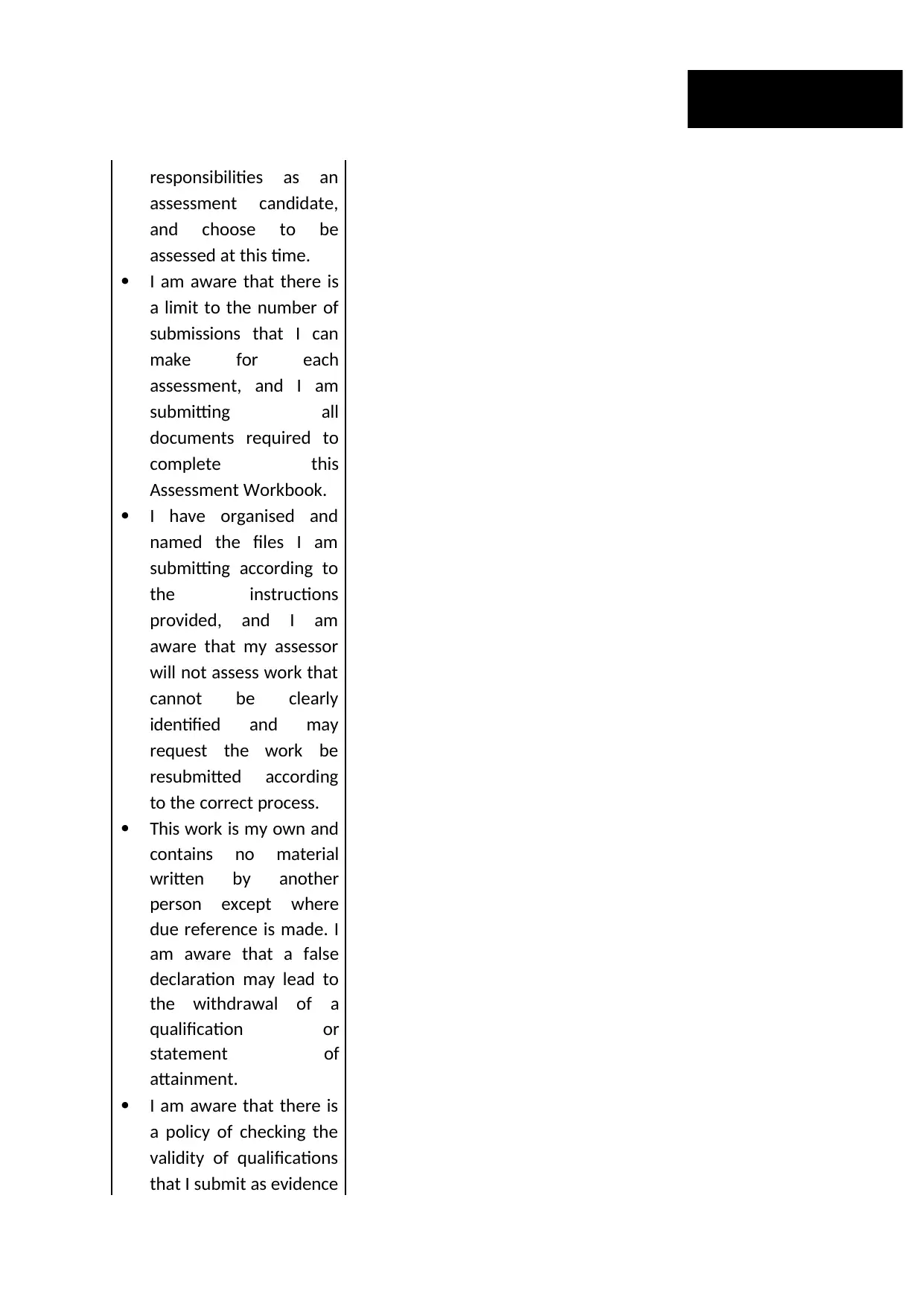
responsibilities as an
assessment candidate,
and choose to be
assessed at this time.
I am aware that there is
a limit to the number of
submissions that I can
make for each
assessment, and I am
submitting all
documents required to
complete this
Assessment Workbook.
I have organised and
named the files I am
submitting according to
the instructions
provided, and I am
aware that my assessor
will not assess work that
cannot be clearly
identified and may
request the work be
resubmitted according
to the correct process.
This work is my own and
contains no material
written by another
person except where
due reference is made. I
am aware that a false
declaration may lead to
the withdrawal of a
qualification or
statement of
attainment.
I am aware that there is
a policy of checking the
validity of qualifications
that I submit as evidence
assessment candidate,
and choose to be
assessed at this time.
I am aware that there is
a limit to the number of
submissions that I can
make for each
assessment, and I am
submitting all
documents required to
complete this
Assessment Workbook.
I have organised and
named the files I am
submitting according to
the instructions
provided, and I am
aware that my assessor
will not assess work that
cannot be clearly
identified and may
request the work be
resubmitted according
to the correct process.
This work is my own and
contains no material
written by another
person except where
due reference is made. I
am aware that a false
declaration may lead to
the withdrawal of a
qualification or
statement of
attainment.
I am aware that there is
a policy of checking the
validity of qualifications
that I submit as evidence
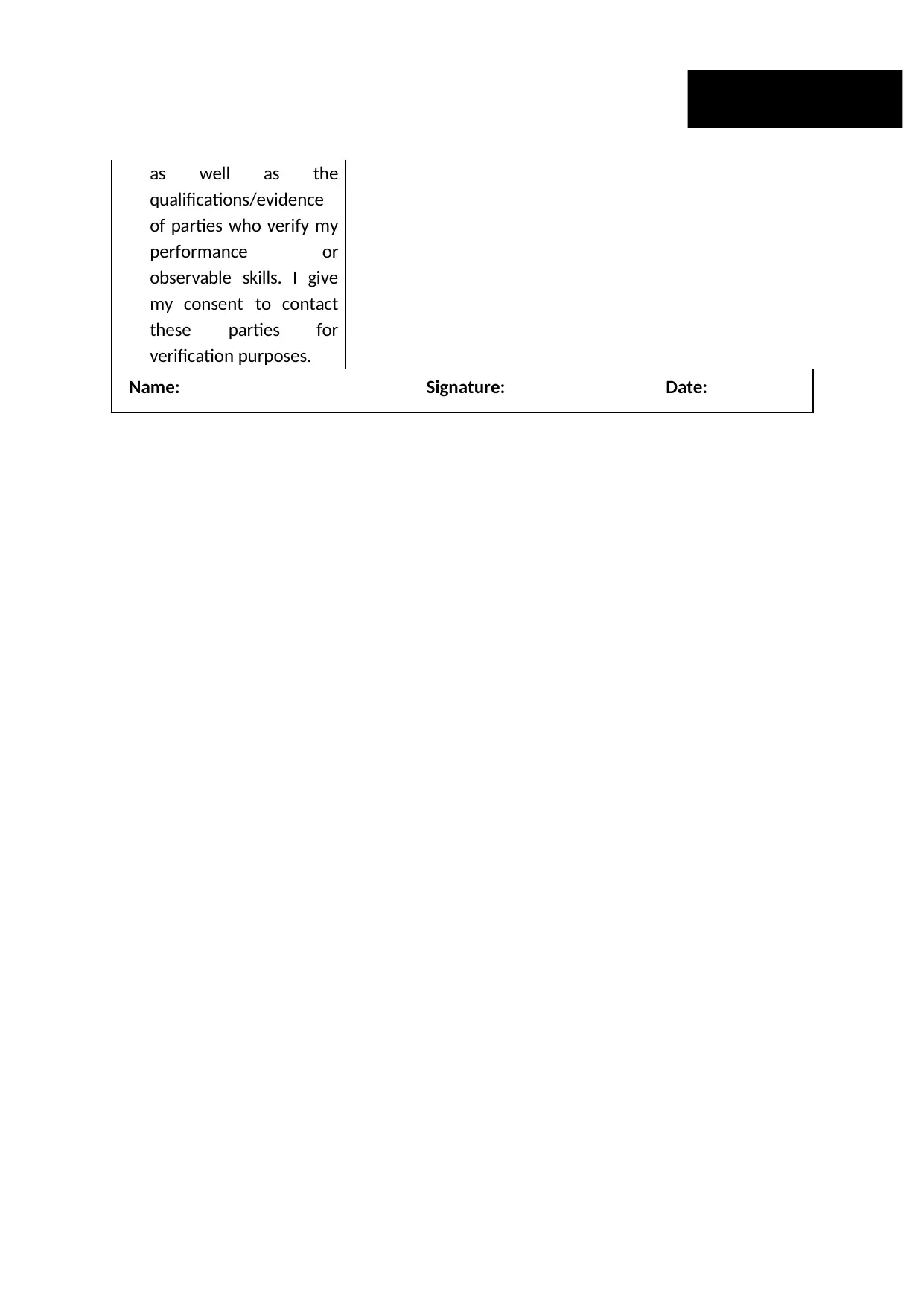
as well as the
qualifications/evidence
of parties who verify my
performance or
observable skills. I give
my consent to contact
these parties for
verification purposes.
Name: Signature: Date:
qualifications/evidence
of parties who verify my
performance or
observable skills. I give
my consent to contact
these parties for
verification purposes.
Name: Signature: Date:
Secure Best Marks with AI Grader
Need help grading? Try our AI Grader for instant feedback on your assignments.
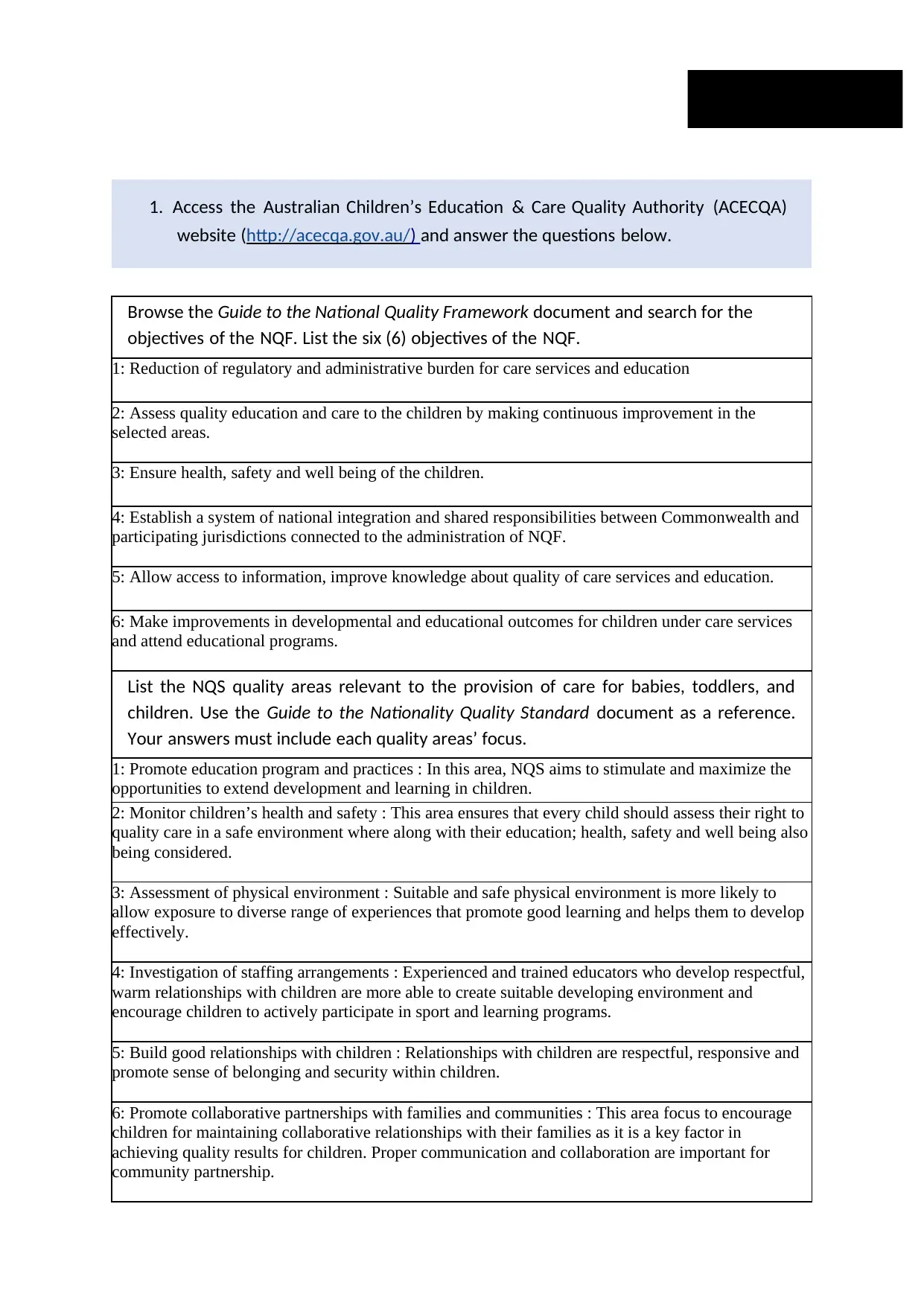
KNOWLEDGE ASSESSMENT
1. Access the Australian Children’s Education & Care Quality Authority (ACECQA)
website (http://acecqa.gov.au/) and answer the questions below.
Browse the Guide to the National Quality Framework document and search for the
objectives of the NQF. List the six (6) objectives of the NQF.
1: Reduction of regulatory and administrative burden for care services and education
2: Assess quality education and care to the children by making continuous improvement in the
selected areas.
3: Ensure health, safety and well being of the children.
4: Establish a system of national integration and shared responsibilities between Commonwealth and
participating jurisdictions connected to the administration of NQF.
5: Allow access to information, improve knowledge about quality of care services and education.
6: Make improvements in developmental and educational outcomes for children under care services
and attend educational programs.
List the NQS quality areas relevant to the provision of care for babies, toddlers, and
children. Use the Guide to the Nationality Quality Standard document as a reference.
Your answers must include each quality areas’ focus.
1: Promote education program and practices : In this area, NQS aims to stimulate and maximize the
opportunities to extend development and learning in children.
2: Monitor children’s health and safety : This area ensures that every child should assess their right to
quality care in a safe environment where along with their education; health, safety and well being also
being considered.
3: Assessment of physical environment : Suitable and safe physical environment is more likely to
allow exposure to diverse range of experiences that promote good learning and helps them to develop
effectively.
4: Investigation of staffing arrangements : Experienced and trained educators who develop respectful,
warm relationships with children are more able to create suitable developing environment and
encourage children to actively participate in sport and learning programs.
5: Build good relationships with children : Relationships with children are respectful, responsive and
promote sense of belonging and security within children.
6: Promote collaborative partnerships with families and communities : This area focus to encourage
children for maintaining collaborative relationships with their families as it is a key factor in
achieving quality results for children. Proper communication and collaboration are important for
community partnership.
1. Access the Australian Children’s Education & Care Quality Authority (ACECQA)
website (http://acecqa.gov.au/) and answer the questions below.
Browse the Guide to the National Quality Framework document and search for the
objectives of the NQF. List the six (6) objectives of the NQF.
1: Reduction of regulatory and administrative burden for care services and education
2: Assess quality education and care to the children by making continuous improvement in the
selected areas.
3: Ensure health, safety and well being of the children.
4: Establish a system of national integration and shared responsibilities between Commonwealth and
participating jurisdictions connected to the administration of NQF.
5: Allow access to information, improve knowledge about quality of care services and education.
6: Make improvements in developmental and educational outcomes for children under care services
and attend educational programs.
List the NQS quality areas relevant to the provision of care for babies, toddlers, and
children. Use the Guide to the Nationality Quality Standard document as a reference.
Your answers must include each quality areas’ focus.
1: Promote education program and practices : In this area, NQS aims to stimulate and maximize the
opportunities to extend development and learning in children.
2: Monitor children’s health and safety : This area ensures that every child should assess their right to
quality care in a safe environment where along with their education; health, safety and well being also
being considered.
3: Assessment of physical environment : Suitable and safe physical environment is more likely to
allow exposure to diverse range of experiences that promote good learning and helps them to develop
effectively.
4: Investigation of staffing arrangements : Experienced and trained educators who develop respectful,
warm relationships with children are more able to create suitable developing environment and
encourage children to actively participate in sport and learning programs.
5: Build good relationships with children : Relationships with children are respectful, responsive and
promote sense of belonging and security within children.
6: Promote collaborative partnerships with families and communities : This area focus to encourage
children for maintaining collaborative relationships with their families as it is a key factor in
achieving quality results for children. Proper communication and collaboration are important for
community partnership.

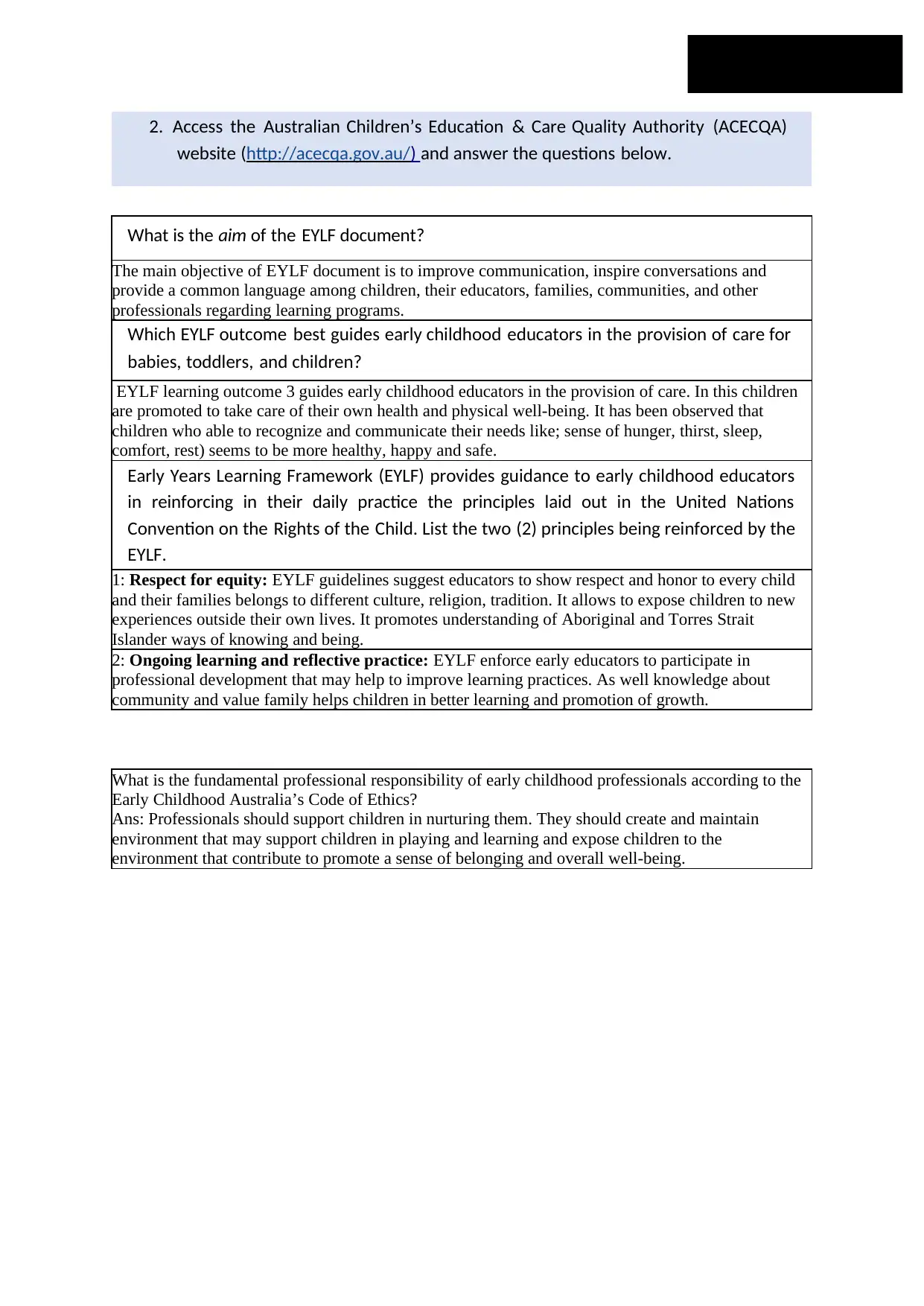
2. Access the Australian Children’s Education & Care Quality Authority (ACECQA)
website (http://acecqa.gov.au/) and answer the questions below.
What is the aim of the EYLF document?
The main objective of EYLF document is to improve communication, inspire conversations and
provide a common language among children, their educators, families, communities, and other
professionals regarding learning programs.
Which EYLF outcome best guides early childhood educators in the provision of care for
babies, toddlers, and children?
EYLF learning outcome 3 guides early childhood educators in the provision of care. In this children
are promoted to take care of their own health and physical well-being. It has been observed that
children who able to recognize and communicate their needs like; sense of hunger, thirst, sleep,
comfort, rest) seems to be more healthy, happy and safe.
Early Years Learning Framework (EYLF) provides guidance to early childhood educators
in reinforcing in their daily practice the principles laid out in the United Nations
Convention on the Rights of the Child. List the two (2) principles being reinforced by the
EYLF.
1: Respect for equity: EYLF guidelines suggest educators to show respect and honor to every child
and their families belongs to different culture, religion, tradition. It allows to expose children to new
experiences outside their own lives. It promotes understanding of Aboriginal and Torres Strait
Islander ways of knowing and being.
2: Ongoing learning and reflective practice: EYLF enforce early educators to participate in
professional development that may help to improve learning practices. As well knowledge about
community and value family helps children in better learning and promotion of growth.
What is the fundamental professional responsibility of early childhood professionals according to the
Early Childhood Australia’s Code of Ethics?
Ans: Professionals should support children in nurturing them. They should create and maintain
environment that may support children in playing and learning and expose children to the
environment that contribute to promote a sense of belonging and overall well-being.
website (http://acecqa.gov.au/) and answer the questions below.
What is the aim of the EYLF document?
The main objective of EYLF document is to improve communication, inspire conversations and
provide a common language among children, their educators, families, communities, and other
professionals regarding learning programs.
Which EYLF outcome best guides early childhood educators in the provision of care for
babies, toddlers, and children?
EYLF learning outcome 3 guides early childhood educators in the provision of care. In this children
are promoted to take care of their own health and physical well-being. It has been observed that
children who able to recognize and communicate their needs like; sense of hunger, thirst, sleep,
comfort, rest) seems to be more healthy, happy and safe.
Early Years Learning Framework (EYLF) provides guidance to early childhood educators
in reinforcing in their daily practice the principles laid out in the United Nations
Convention on the Rights of the Child. List the two (2) principles being reinforced by the
EYLF.
1: Respect for equity: EYLF guidelines suggest educators to show respect and honor to every child
and their families belongs to different culture, religion, tradition. It allows to expose children to new
experiences outside their own lives. It promotes understanding of Aboriginal and Torres Strait
Islander ways of knowing and being.
2: Ongoing learning and reflective practice: EYLF enforce early educators to participate in
professional development that may help to improve learning practices. As well knowledge about
community and value family helps children in better learning and promotion of growth.
What is the fundamental professional responsibility of early childhood professionals according to the
Early Childhood Australia’s Code of Ethics?
Ans: Professionals should support children in nurturing them. They should create and maintain
environment that may support children in playing and learning and expose children to the
environment that contribute to promote a sense of belonging and overall well-being.
Paraphrase This Document
Need a fresh take? Get an instant paraphrase of this document with our AI Paraphraser
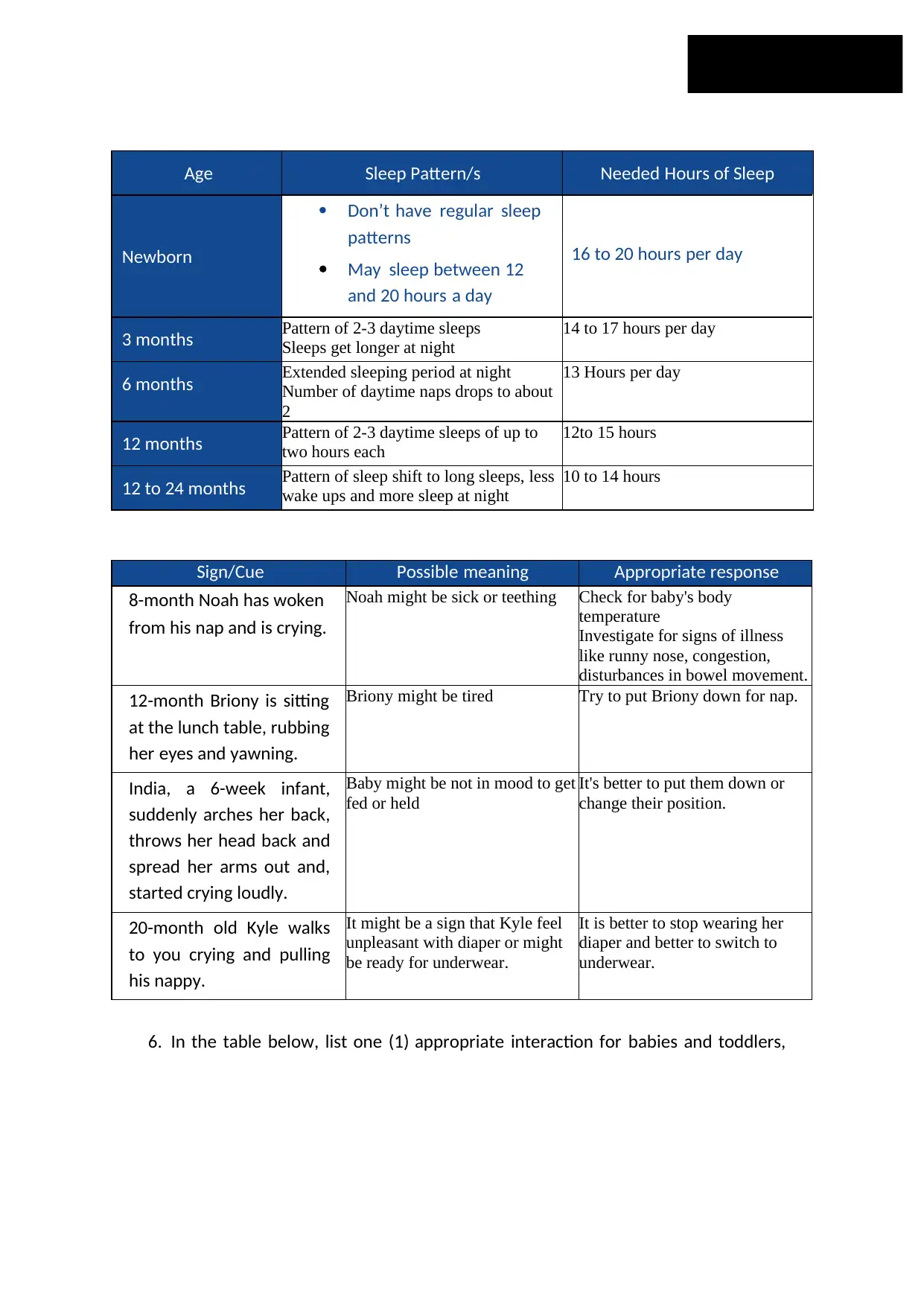
Age Sleep Pattern/s Needed Hours of Sleep
Newborn
Don’t have regular sleep
patterns
May sleep between 12
and 20 hours a day
16 to 20 hours per day
3 months Pattern of 2-3 daytime sleeps
Sleeps get longer at night
14 to 17 hours per day
6 months Extended sleeping period at night
Number of daytime naps drops to about
2
13 Hours per day
12 months Pattern of 2-3 daytime sleeps of up to
two hours each
12to 15 hours
12 to 24 months Pattern of sleep shift to long sleeps, less
wake ups and more sleep at night
10 to 14 hours
Sign/Cue Possible meaning Appropriate response
8-month Noah has woken
from his nap and is crying.
Noah might be sick or teething Check for baby's body
temperature
Investigate for signs of illness
like runny nose, congestion,
disturbances in bowel movement.
12-month Briony is sitting
at the lunch table, rubbing
her eyes and yawning.
Briony might be tired Try to put Briony down for nap.
India, a 6-week infant,
suddenly arches her back,
throws her head back and
spread her arms out and,
started crying loudly.
Baby might be not in mood to get
fed or held
It's better to put them down or
change their position.
20-month old Kyle walks
to you crying and pulling
his nappy.
It might be a sign that Kyle feel
unpleasant with diaper or might
be ready for underwear.
It is better to stop wearing her
diaper and better to switch to
underwear.
6. In the table below, list one (1) appropriate interaction for babies and toddlers,
Newborn
Don’t have regular sleep
patterns
May sleep between 12
and 20 hours a day
16 to 20 hours per day
3 months Pattern of 2-3 daytime sleeps
Sleeps get longer at night
14 to 17 hours per day
6 months Extended sleeping period at night
Number of daytime naps drops to about
2
13 Hours per day
12 months Pattern of 2-3 daytime sleeps of up to
two hours each
12to 15 hours
12 to 24 months Pattern of sleep shift to long sleeps, less
wake ups and more sleep at night
10 to 14 hours
Sign/Cue Possible meaning Appropriate response
8-month Noah has woken
from his nap and is crying.
Noah might be sick or teething Check for baby's body
temperature
Investigate for signs of illness
like runny nose, congestion,
disturbances in bowel movement.
12-month Briony is sitting
at the lunch table, rubbing
her eyes and yawning.
Briony might be tired Try to put Briony down for nap.
India, a 6-week infant,
suddenly arches her back,
throws her head back and
spread her arms out and,
started crying loudly.
Baby might be not in mood to get
fed or held
It's better to put them down or
change their position.
20-month old Kyle walks
to you crying and pulling
his nappy.
It might be a sign that Kyle feel
unpleasant with diaper or might
be ready for underwear.
It is better to stop wearing her
diaper and better to switch to
underwear.
6. In the table below, list one (1) appropriate interaction for babies and toddlers,
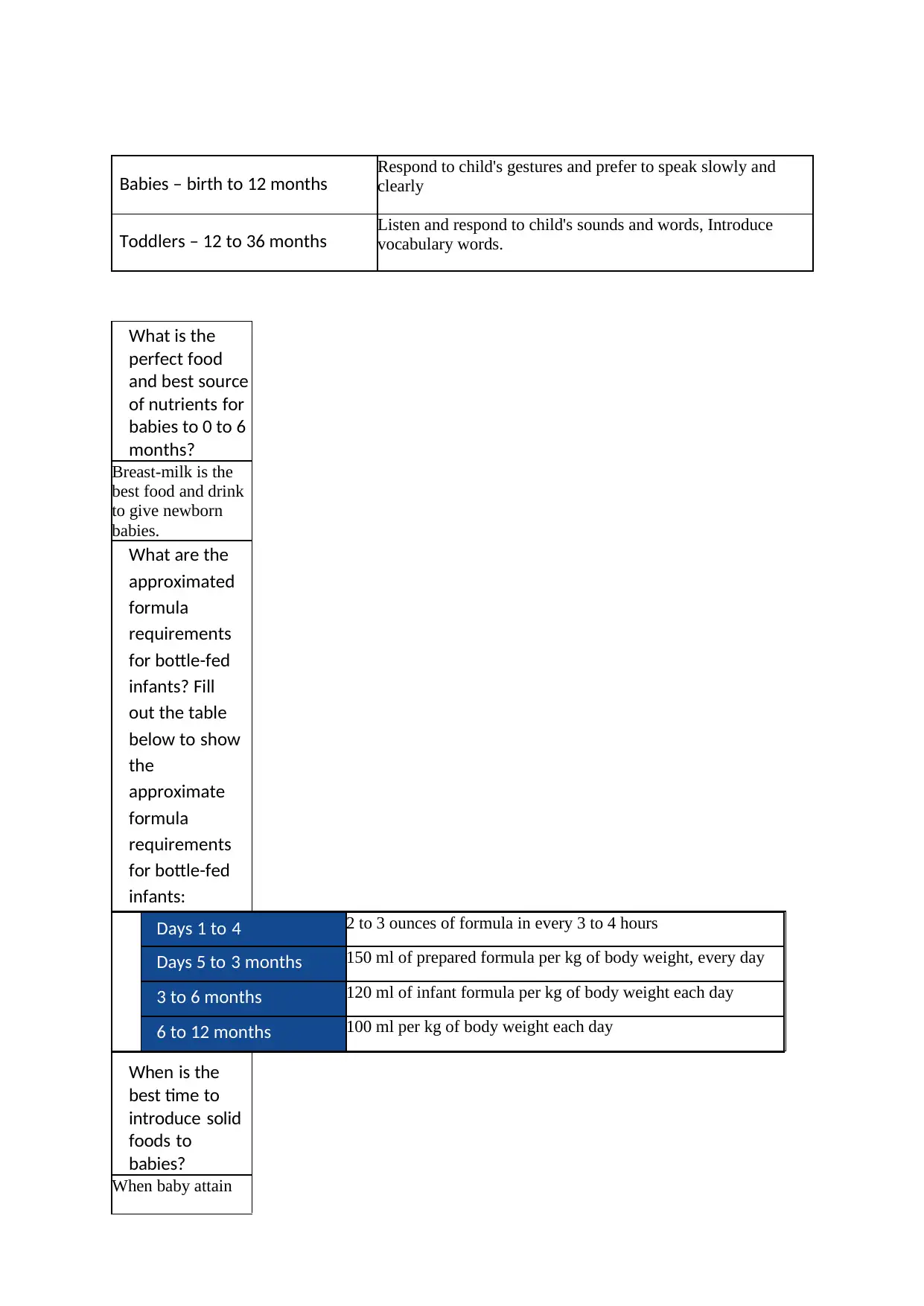
Babies – birth to 12 months Respond to child's gestures and prefer to speak slowly and
clearly
Toddlers – 12 to 36 months Listen and respond to child's sounds and words, Introduce
vocabulary words.
What is the
perfect food
and best source
of nutrients for
babies to 0 to 6
months?
Breast-milk is the
best food and drink
to give newborn
babies.
What are the
approximated
formula
requirements
for bottle-fed
infants? Fill
out the table
below to show
the
approximate
formula
requirements
for bottle-fed
infants:
Days 1 to 4 2 to 3 ounces of formula in every 3 to 4 hours
Days 5 to 3 months 150 ml of prepared formula per kg of body weight, every day
3 to 6 months 120 ml of infant formula per kg of body weight each day
6 to 12 months 100 ml per kg of body weight each day
When is the
best time to
introduce solid
foods to
babies?
When baby attain
clearly
Toddlers – 12 to 36 months Listen and respond to child's sounds and words, Introduce
vocabulary words.
What is the
perfect food
and best source
of nutrients for
babies to 0 to 6
months?
Breast-milk is the
best food and drink
to give newborn
babies.
What are the
approximated
formula
requirements
for bottle-fed
infants? Fill
out the table
below to show
the
approximate
formula
requirements
for bottle-fed
infants:
Days 1 to 4 2 to 3 ounces of formula in every 3 to 4 hours
Days 5 to 3 months 150 ml of prepared formula per kg of body weight, every day
3 to 6 months 120 ml of infant formula per kg of body weight each day
6 to 12 months 100 ml per kg of body weight each day
When is the
best time to
introduce solid
foods to
babies?
When baby attain
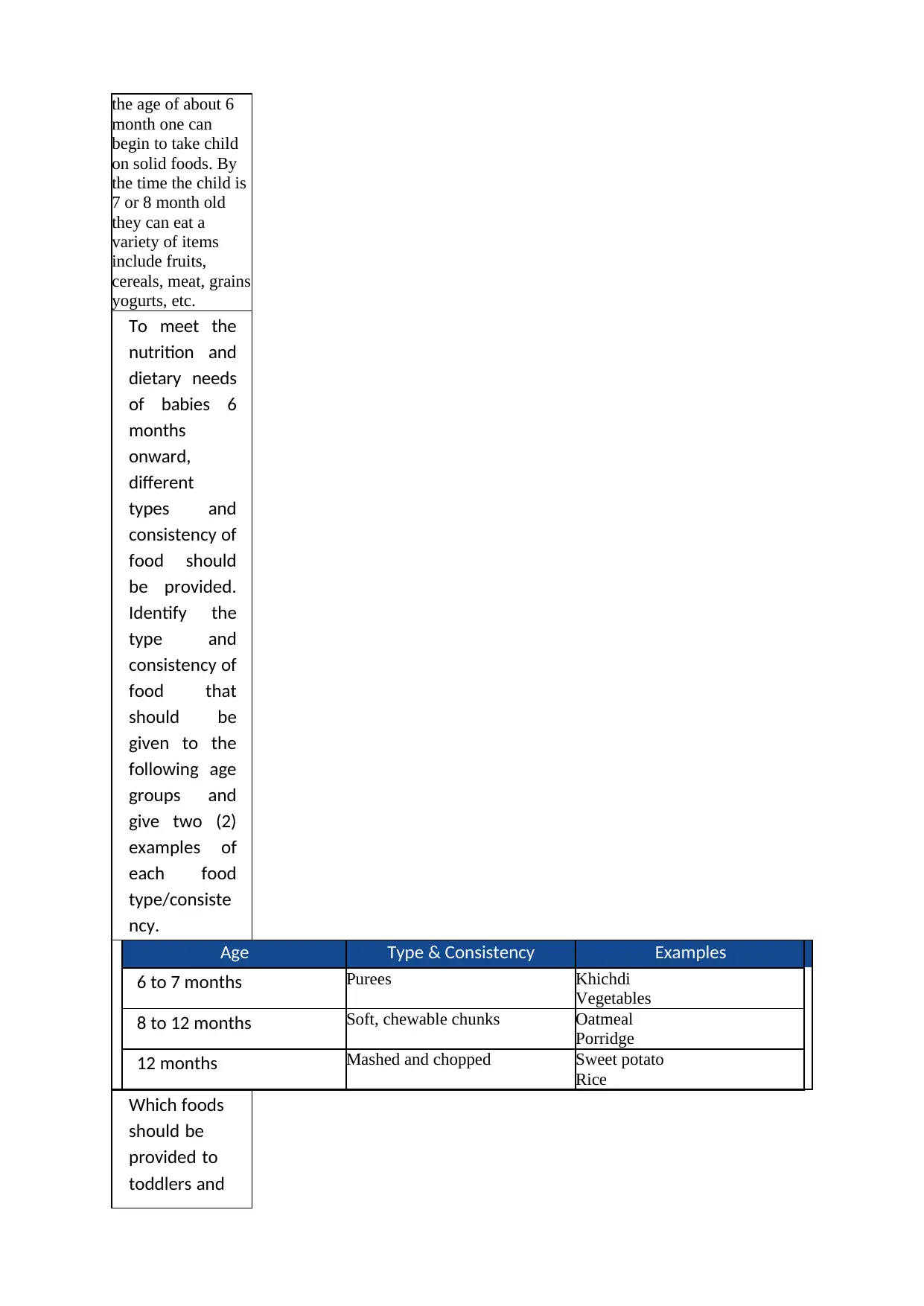
the age of about 6
month one can
begin to take child
on solid foods. By
the time the child is
7 or 8 month old
they can eat a
variety of items
include fruits,
cereals, meat, grains
yogurts, etc.
To meet the
nutrition and
dietary needs
of babies 6
months
onward,
different
types and
consistency of
food should
be provided.
Identify the
type and
consistency of
food that
should be
given to the
following age
groups and
give two (2)
examples of
each food
type/consiste
ncy.
Age Type & Consistency Examples
6 to 7 months Purees Khichdi
Vegetables
8 to 12 months Soft, chewable chunks Oatmeal
Porridge
12 months Mashed and chopped Sweet potato
Rice
Which foods
should be
provided to
toddlers and
month one can
begin to take child
on solid foods. By
the time the child is
7 or 8 month old
they can eat a
variety of items
include fruits,
cereals, meat, grains
yogurts, etc.
To meet the
nutrition and
dietary needs
of babies 6
months
onward,
different
types and
consistency of
food should
be provided.
Identify the
type and
consistency of
food that
should be
given to the
following age
groups and
give two (2)
examples of
each food
type/consiste
ncy.
Age Type & Consistency Examples
6 to 7 months Purees Khichdi
Vegetables
8 to 12 months Soft, chewable chunks Oatmeal
Porridge
12 months Mashed and chopped Sweet potato
Rice
Which foods
should be
provided to
toddlers and
Secure Best Marks with AI Grader
Need help grading? Try our AI Grader for instant feedback on your assignments.

which foods
should be given
in limited
amounts?
Guidance: Use
the following
resource to
answer the
questions
below: Healthy
eating for
children
should be given
in limited
amounts?
Guidance: Use
the following
resource to
answer the
questions
below: Healthy
eating for
children
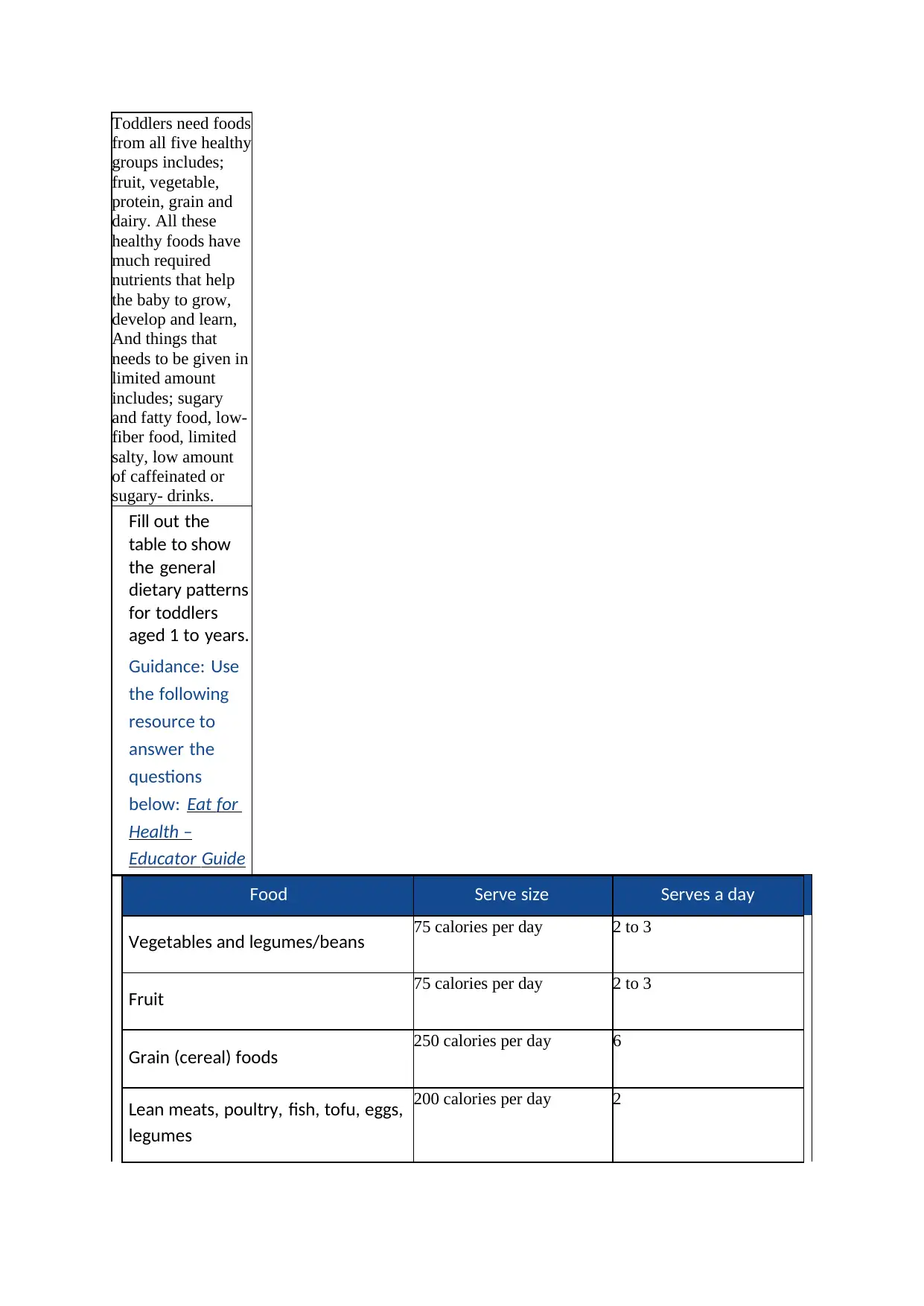
Toddlers need foods
from all five healthy
groups includes;
fruit, vegetable,
protein, grain and
dairy. All these
healthy foods have
much required
nutrients that help
the baby to grow,
develop and learn,
And things that
needs to be given in
limited amount
includes; sugary
and fatty food, low-
fiber food, limited
salty, low amount
of caffeinated or
sugary- drinks.
Fill out the
table to show
the general
dietary patterns
for toddlers
aged 1 to years.
Guidance: Use
the following
resource to
answer the
questions
below: Eat for
Health –
Educator Guide
Food Serve size Serves a day
Vegetables and legumes/beans 75 calories per day 2 to 3
Fruit 75 calories per day 2 to 3
Grain (cereal) foods 250 calories per day 6
Lean meats, poultry, fish, tofu, eggs,
legumes
200 calories per day 2
from all five healthy
groups includes;
fruit, vegetable,
protein, grain and
dairy. All these
healthy foods have
much required
nutrients that help
the baby to grow,
develop and learn,
And things that
needs to be given in
limited amount
includes; sugary
and fatty food, low-
fiber food, limited
salty, low amount
of caffeinated or
sugary- drinks.
Fill out the
table to show
the general
dietary patterns
for toddlers
aged 1 to years.
Guidance: Use
the following
resource to
answer the
questions
below: Eat for
Health –
Educator Guide
Food Serve size Serves a day
Vegetables and legumes/beans 75 calories per day 2 to 3
Fruit 75 calories per day 2 to 3
Grain (cereal) foods 250 calories per day 6
Lean meats, poultry, fish, tofu, eggs,
legumes
200 calories per day 2

Milk, yoghurt, cheese and/or
alternatives
300 to 450 calories per day 2 to 3
alternatives
300 to 450 calories per day 2 to 3
Paraphrase This Document
Need a fresh take? Get an instant paraphrase of this document with our AI Paraphraser
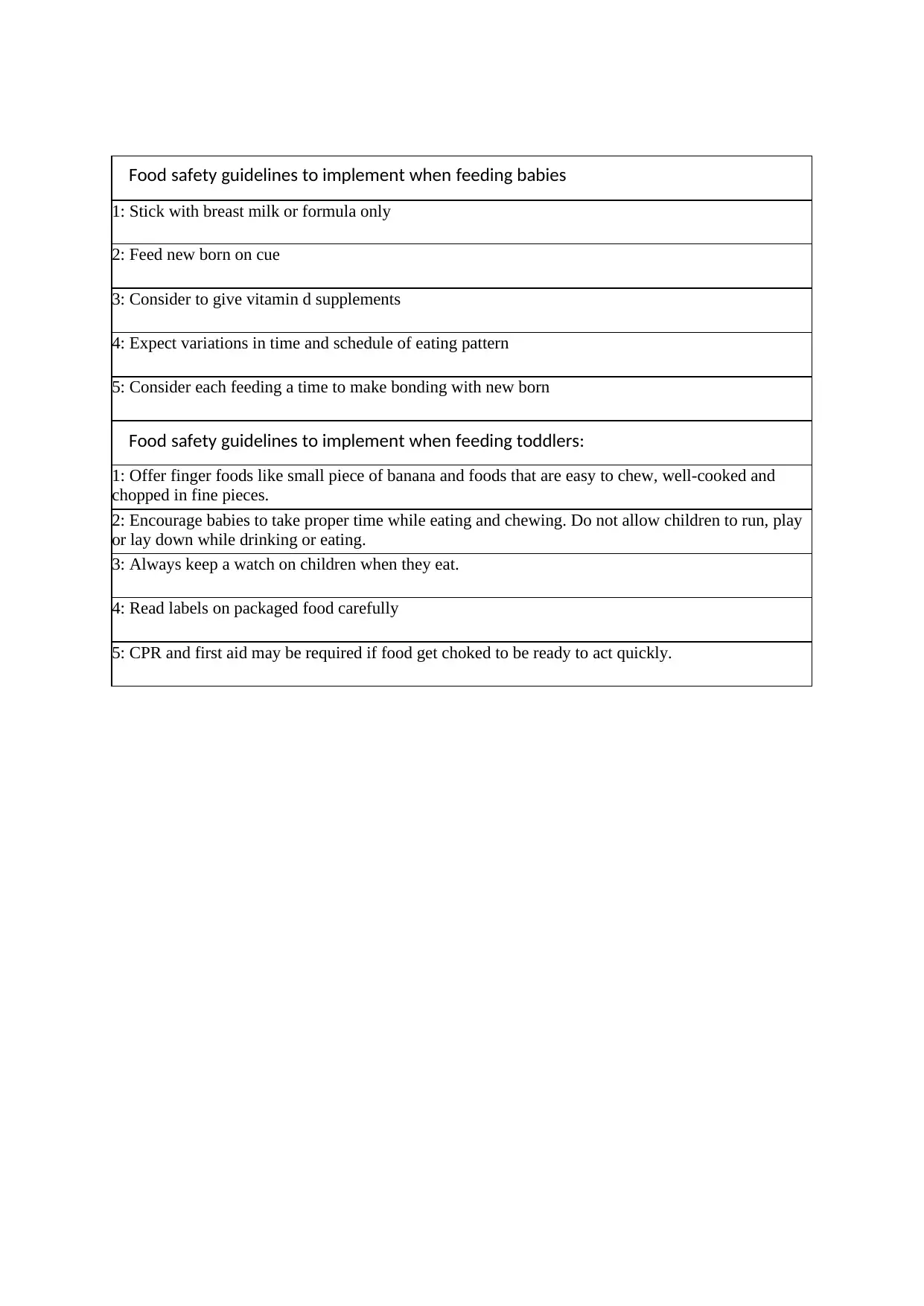
Food safety guidelines to implement when feeding babies
1: Stick with breast milk or formula only
2: Feed new born on cue
3: Consider to give vitamin d supplements
4: Expect variations in time and schedule of eating pattern
5: Consider each feeding a time to make bonding with new born
Food safety guidelines to implement when feeding toddlers:
1: Offer finger foods like small piece of banana and foods that are easy to chew, well-cooked and
chopped in fine pieces.
2: Encourage babies to take proper time while eating and chewing. Do not allow children to run, play
or lay down while drinking or eating.
3: Always keep a watch on children when they eat.
4: Read labels on packaged food carefully
5: CPR and first aid may be required if food get choked to be ready to act quickly.
1: Stick with breast milk or formula only
2: Feed new born on cue
3: Consider to give vitamin d supplements
4: Expect variations in time and schedule of eating pattern
5: Consider each feeding a time to make bonding with new born
Food safety guidelines to implement when feeding toddlers:
1: Offer finger foods like small piece of banana and foods that are easy to chew, well-cooked and
chopped in fine pieces.
2: Encourage babies to take proper time while eating and chewing. Do not allow children to run, play
or lay down while drinking or eating.
3: Always keep a watch on children when they eat.
4: Read labels on packaged food carefully
5: CPR and first aid may be required if food get choked to be ready to act quickly.
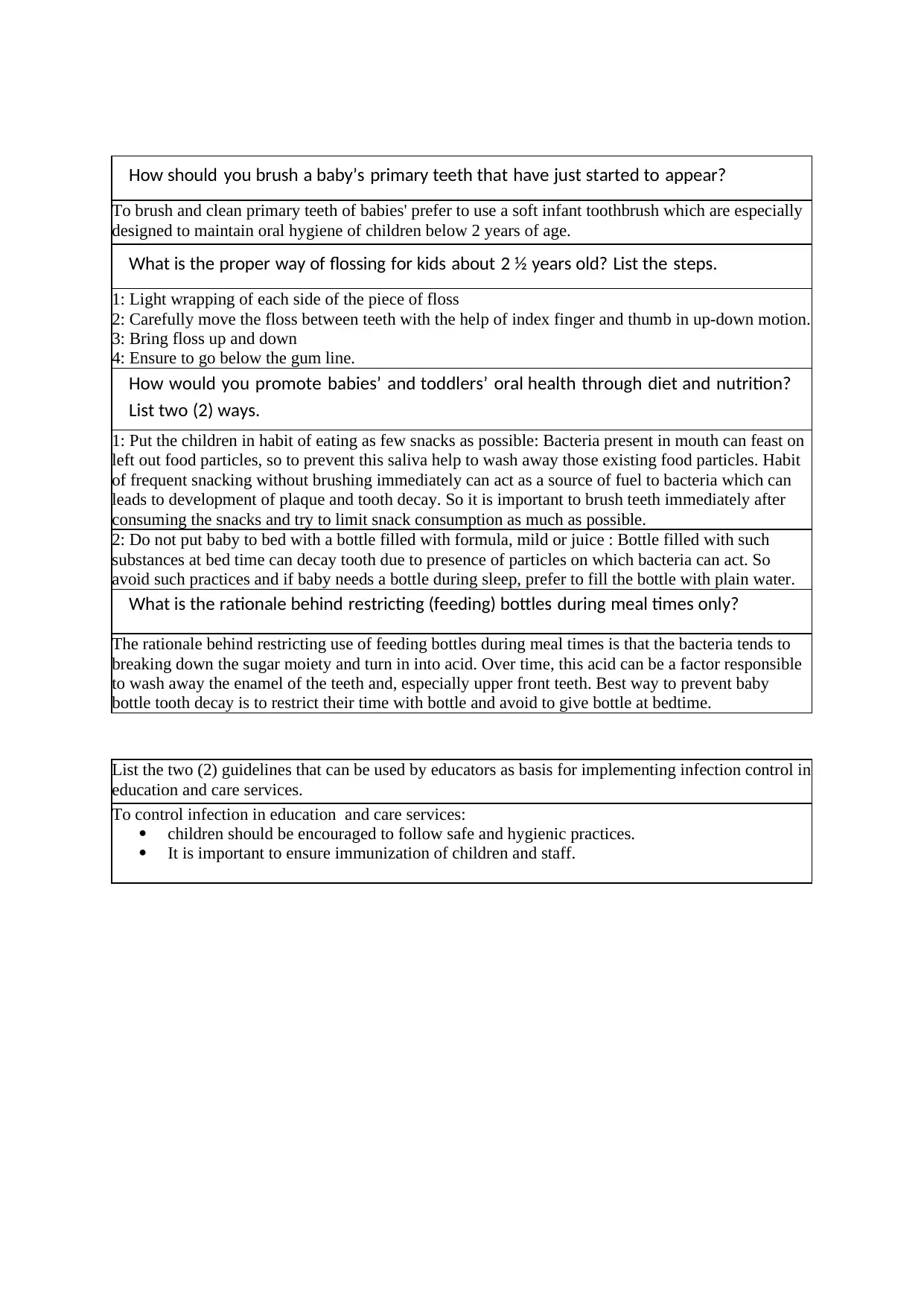
How should you brush a baby’s primary teeth that have just started to appear?
To brush and clean primary teeth of babies' prefer to use a soft infant toothbrush which are especially
designed to maintain oral hygiene of children below 2 years of age.
What is the proper way of flossing for kids about 2 ½ years old? List the steps.
1: Light wrapping of each side of the piece of floss
2: Carefully move the floss between teeth with the help of index finger and thumb in up-down motion.
3: Bring floss up and down
4: Ensure to go below the gum line.
How would you promote babies’ and toddlers’ oral health through diet and nutrition?
List two (2) ways.
1: Put the children in habit of eating as few snacks as possible: Bacteria present in mouth can feast on
left out food particles, so to prevent this saliva help to wash away those existing food particles. Habit
of frequent snacking without brushing immediately can act as a source of fuel to bacteria which can
leads to development of plaque and tooth decay. So it is important to brush teeth immediately after
consuming the snacks and try to limit snack consumption as much as possible.
2: Do not put baby to bed with a bottle filled with formula, mild or juice : Bottle filled with such
substances at bed time can decay tooth due to presence of particles on which bacteria can act. So
avoid such practices and if baby needs a bottle during sleep, prefer to fill the bottle with plain water.
What is the rationale behind restricting (feeding) bottles during meal times only?
The rationale behind restricting use of feeding bottles during meal times is that the bacteria tends to
breaking down the sugar moiety and turn in into acid. Over time, this acid can be a factor responsible
to wash away the enamel of the teeth and, especially upper front teeth. Best way to prevent baby
bottle tooth decay is to restrict their time with bottle and avoid to give bottle at bedtime.
List the two (2) guidelines that can be used by educators as basis for implementing infection control in
education and care services.
To control infection in education and care services:
children should be encouraged to follow safe and hygienic practices.
It is important to ensure immunization of children and staff.
To brush and clean primary teeth of babies' prefer to use a soft infant toothbrush which are especially
designed to maintain oral hygiene of children below 2 years of age.
What is the proper way of flossing for kids about 2 ½ years old? List the steps.
1: Light wrapping of each side of the piece of floss
2: Carefully move the floss between teeth with the help of index finger and thumb in up-down motion.
3: Bring floss up and down
4: Ensure to go below the gum line.
How would you promote babies’ and toddlers’ oral health through diet and nutrition?
List two (2) ways.
1: Put the children in habit of eating as few snacks as possible: Bacteria present in mouth can feast on
left out food particles, so to prevent this saliva help to wash away those existing food particles. Habit
of frequent snacking without brushing immediately can act as a source of fuel to bacteria which can
leads to development of plaque and tooth decay. So it is important to brush teeth immediately after
consuming the snacks and try to limit snack consumption as much as possible.
2: Do not put baby to bed with a bottle filled with formula, mild or juice : Bottle filled with such
substances at bed time can decay tooth due to presence of particles on which bacteria can act. So
avoid such practices and if baby needs a bottle during sleep, prefer to fill the bottle with plain water.
What is the rationale behind restricting (feeding) bottles during meal times only?
The rationale behind restricting use of feeding bottles during meal times is that the bacteria tends to
breaking down the sugar moiety and turn in into acid. Over time, this acid can be a factor responsible
to wash away the enamel of the teeth and, especially upper front teeth. Best way to prevent baby
bottle tooth decay is to restrict their time with bottle and avoid to give bottle at bedtime.
List the two (2) guidelines that can be used by educators as basis for implementing infection control in
education and care services.
To control infection in education and care services:
children should be encouraged to follow safe and hygienic practices.
It is important to ensure immunization of children and staff.
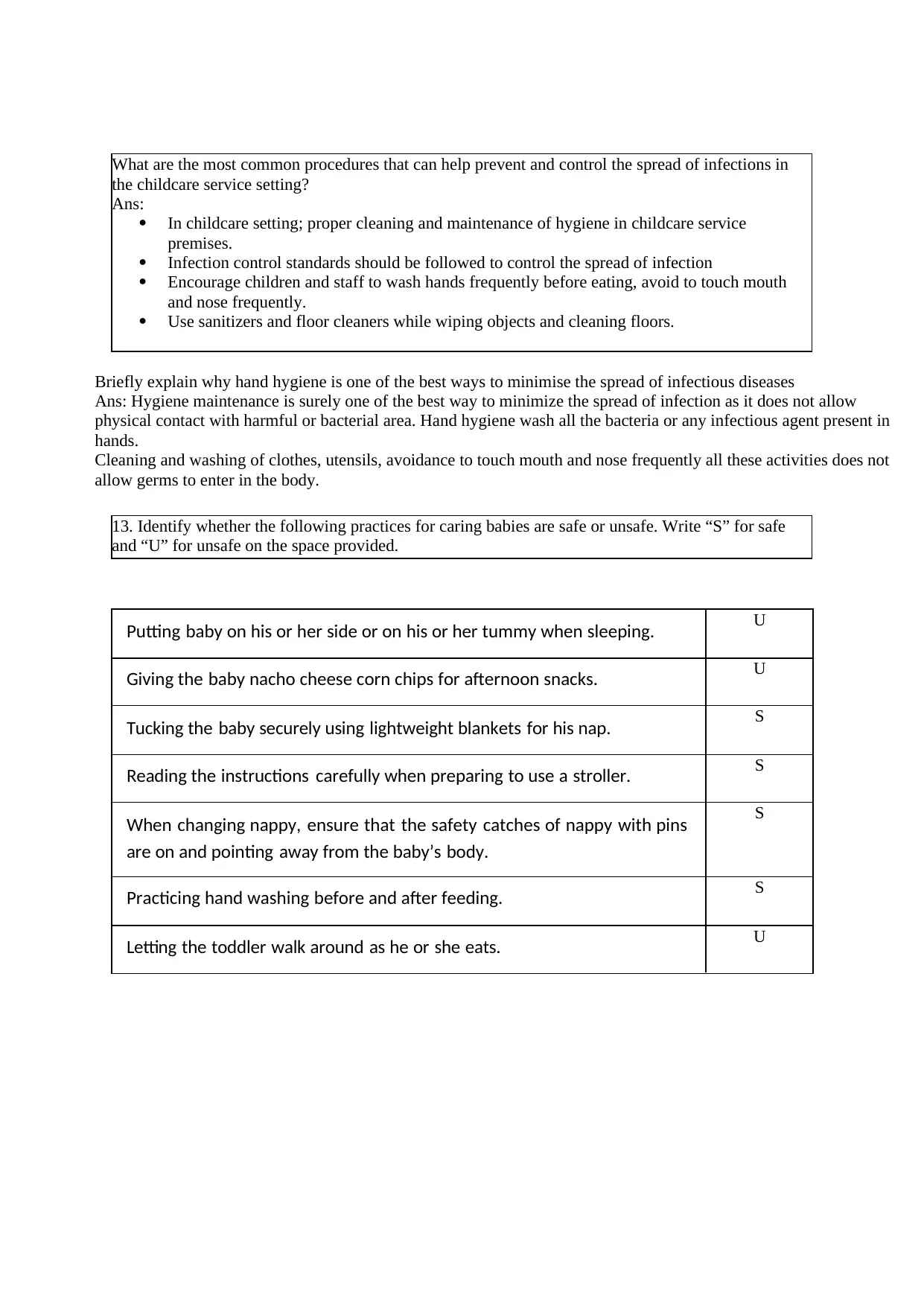
What are the most common procedures that can help prevent and control the spread of infections in
the childcare service setting?
Ans:
In childcare setting; proper cleaning and maintenance of hygiene in childcare service
premises.
Infection control standards should be followed to control the spread of infection
Encourage children and staff to wash hands frequently before eating, avoid to touch mouth
and nose frequently.
Use sanitizers and floor cleaners while wiping objects and cleaning floors.
Briefly explain why hand hygiene is one of the best ways to minimise the spread of infectious diseases
Ans: Hygiene maintenance is surely one of the best way to minimize the spread of infection as it does not allow
physical contact with harmful or bacterial area. Hand hygiene wash all the bacteria or any infectious agent present in
hands.
Cleaning and washing of clothes, utensils, avoidance to touch mouth and nose frequently all these activities does not
allow germs to enter in the body.
13. Identify whether the following practices for caring babies are safe or unsafe. Write “S” for safe
and “U” for unsafe on the space provided.
Putting baby on his or her side or on his or her tummy when sleeping. U
Giving the baby nacho cheese corn chips for afternoon snacks. U
Tucking the baby securely using lightweight blankets for his nap. S
Reading the instructions carefully when preparing to use a stroller. S
When changing nappy, ensure that the safety catches of nappy with pins
are on and pointing away from the baby’s body.
S
Practicing hand washing before and after feeding. S
Letting the toddler walk around as he or she eats. U
the childcare service setting?
Ans:
In childcare setting; proper cleaning and maintenance of hygiene in childcare service
premises.
Infection control standards should be followed to control the spread of infection
Encourage children and staff to wash hands frequently before eating, avoid to touch mouth
and nose frequently.
Use sanitizers and floor cleaners while wiping objects and cleaning floors.
Briefly explain why hand hygiene is one of the best ways to minimise the spread of infectious diseases
Ans: Hygiene maintenance is surely one of the best way to minimize the spread of infection as it does not allow
physical contact with harmful or bacterial area. Hand hygiene wash all the bacteria or any infectious agent present in
hands.
Cleaning and washing of clothes, utensils, avoidance to touch mouth and nose frequently all these activities does not
allow germs to enter in the body.
13. Identify whether the following practices for caring babies are safe or unsafe. Write “S” for safe
and “U” for unsafe on the space provided.
Putting baby on his or her side or on his or her tummy when sleeping. U
Giving the baby nacho cheese corn chips for afternoon snacks. U
Tucking the baby securely using lightweight blankets for his nap. S
Reading the instructions carefully when preparing to use a stroller. S
When changing nappy, ensure that the safety catches of nappy with pins
are on and pointing away from the baby’s body.
S
Practicing hand washing before and after feeding. S
Letting the toddler walk around as he or she eats. U
Secure Best Marks with AI Grader
Need help grading? Try our AI Grader for instant feedback on your assignments.
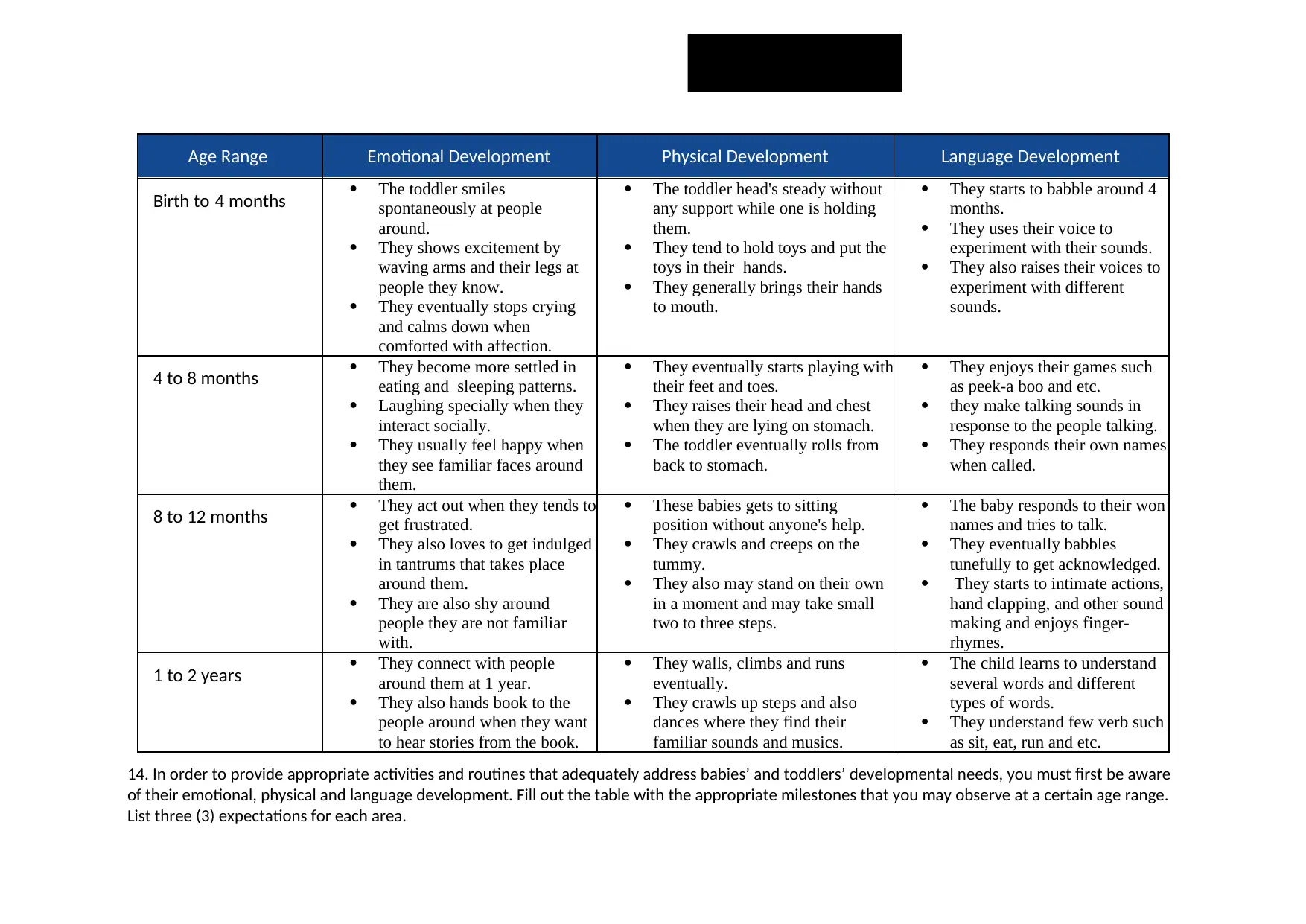
Age Range Emotional Development Physical Development Language Development
Birth to 4 months The toddler smiles
spontaneously at people
around.
They shows excitement by
waving arms and their legs at
people they know.
They eventually stops crying
and calms down when
comforted with affection.
The toddler head's steady without
any support while one is holding
them.
They tend to hold toys and put the
toys in their hands.
They generally brings their hands
to mouth.
They starts to babble around 4
months.
They uses their voice to
experiment with their sounds.
They also raises their voices to
experiment with different
sounds.
4 to 8 months They become more settled in
eating and sleeping patterns.
Laughing specially when they
interact socially.
They usually feel happy when
they see familiar faces around
them.
They eventually starts playing with
their feet and toes.
They raises their head and chest
when they are lying on stomach.
The toddler eventually rolls from
back to stomach.
They enjoys their games such
as peek-a boo and etc.
they make talking sounds in
response to the people talking.
They responds their own names
when called.
8 to 12 months They act out when they tends to
get frustrated.
They also loves to get indulged
in tantrums that takes place
around them.
They are also shy around
people they are not familiar
with.
These babies gets to sitting
position without anyone's help.
They crawls and creeps on the
tummy.
They also may stand on their own
in a moment and may take small
two to three steps.
The baby responds to their won
names and tries to talk.
They eventually babbles
tunefully to get acknowledged.
They starts to intimate actions,
hand clapping, and other sound
making and enjoys finger-
rhymes.
1 to 2 years They connect with people
around them at 1 year.
They also hands book to the
people around when they want
to hear stories from the book.
They walls, climbs and runs
eventually.
They crawls up steps and also
dances where they find their
familiar sounds and musics.
The child learns to understand
several words and different
types of words.
They understand few verb such
as sit, eat, run and etc.
14. In order to provide appropriate activities and routines that adequately address babies’ and toddlers’ developmental needs, you must first be aware
of their emotional, physical and language development. Fill out the table with the appropriate milestones that you may observe at a certain age range.
List three (3) expectations for each area.
Birth to 4 months The toddler smiles
spontaneously at people
around.
They shows excitement by
waving arms and their legs at
people they know.
They eventually stops crying
and calms down when
comforted with affection.
The toddler head's steady without
any support while one is holding
them.
They tend to hold toys and put the
toys in their hands.
They generally brings their hands
to mouth.
They starts to babble around 4
months.
They uses their voice to
experiment with their sounds.
They also raises their voices to
experiment with different
sounds.
4 to 8 months They become more settled in
eating and sleeping patterns.
Laughing specially when they
interact socially.
They usually feel happy when
they see familiar faces around
them.
They eventually starts playing with
their feet and toes.
They raises their head and chest
when they are lying on stomach.
The toddler eventually rolls from
back to stomach.
They enjoys their games such
as peek-a boo and etc.
they make talking sounds in
response to the people talking.
They responds their own names
when called.
8 to 12 months They act out when they tends to
get frustrated.
They also loves to get indulged
in tantrums that takes place
around them.
They are also shy around
people they are not familiar
with.
These babies gets to sitting
position without anyone's help.
They crawls and creeps on the
tummy.
They also may stand on their own
in a moment and may take small
two to three steps.
The baby responds to their won
names and tries to talk.
They eventually babbles
tunefully to get acknowledged.
They starts to intimate actions,
hand clapping, and other sound
making and enjoys finger-
rhymes.
1 to 2 years They connect with people
around them at 1 year.
They also hands book to the
people around when they want
to hear stories from the book.
They walls, climbs and runs
eventually.
They crawls up steps and also
dances where they find their
familiar sounds and musics.
The child learns to understand
several words and different
types of words.
They understand few verb such
as sit, eat, run and etc.
14. In order to provide appropriate activities and routines that adequately address babies’ and toddlers’ developmental needs, you must first be aware
of their emotional, physical and language development. Fill out the table with the appropriate milestones that you may observe at a certain age range.
List three (3) expectations for each area.
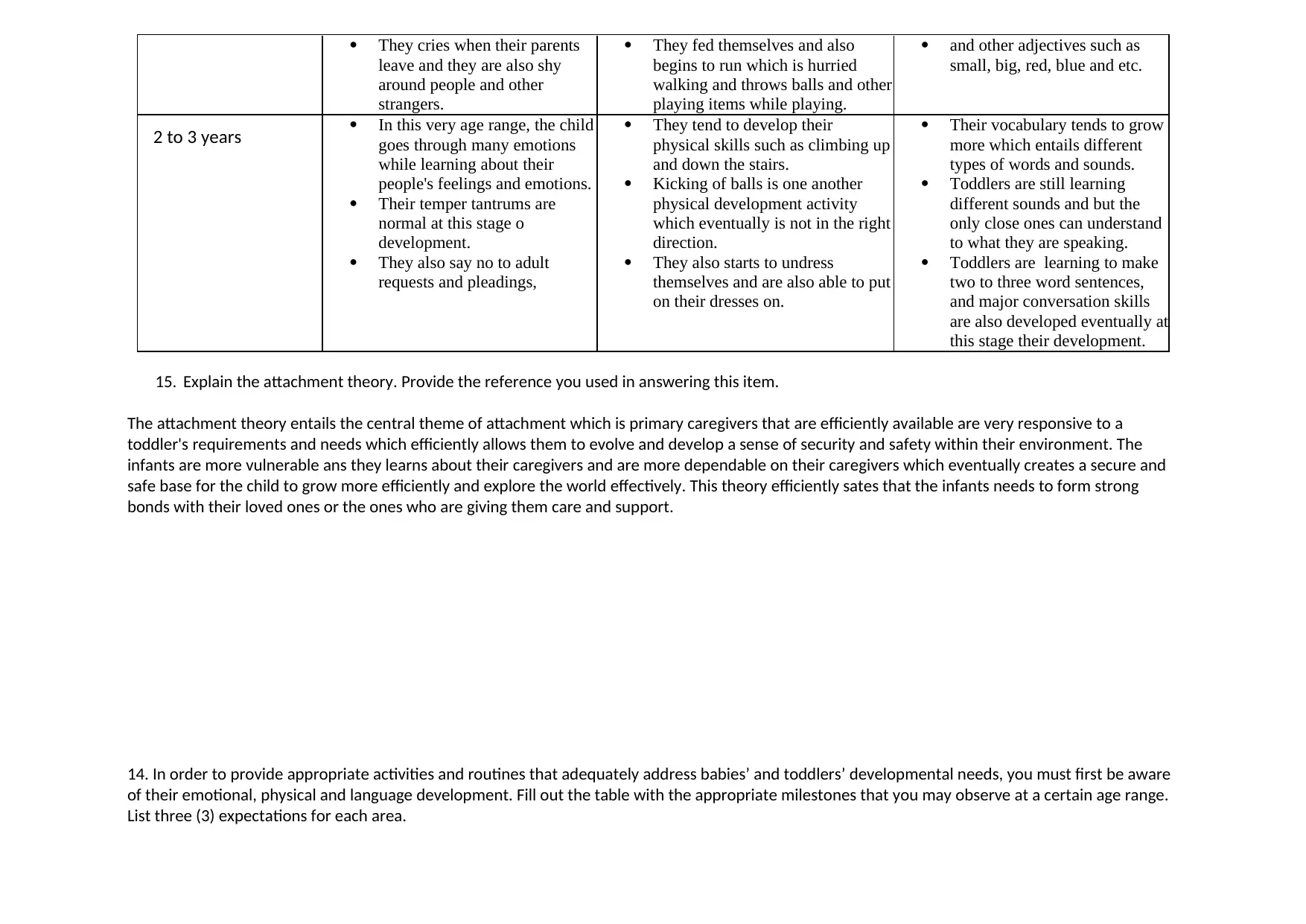
They cries when their parents
leave and they are also shy
around people and other
strangers.
They fed themselves and also
begins to run which is hurried
walking and throws balls and other
playing items while playing.
and other adjectives such as
small, big, red, blue and etc.
2 to 3 years In this very age range, the child
goes through many emotions
while learning about their
people's feelings and emotions.
Their temper tantrums are
normal at this stage o
development.
They also say no to adult
requests and pleadings,
They tend to develop their
physical skills such as climbing up
and down the stairs.
Kicking of balls is one another
physical development activity
which eventually is not in the right
direction.
They also starts to undress
themselves and are also able to put
on their dresses on.
Their vocabulary tends to grow
more which entails different
types of words and sounds.
Toddlers are still learning
different sounds and but the
only close ones can understand
to what they are speaking.
Toddlers are learning to make
two to three word sentences,
and major conversation skills
are also developed eventually at
this stage their development.
15. Explain the attachment theory. Provide the reference you used in answering this item.
The attachment theory entails the central theme of attachment which is primary caregivers that are efficiently available are very responsive to a
toddler's requirements and needs which efficiently allows them to evolve and develop a sense of security and safety within their environment. The
infants are more vulnerable ans they learns about their caregivers and are more dependable on their caregivers which eventually creates a secure and
safe base for the child to grow more efficiently and explore the world effectively. This theory efficiently sates that the infants needs to form strong
bonds with their loved ones or the ones who are giving them care and support.
14. In order to provide appropriate activities and routines that adequately address babies’ and toddlers’ developmental needs, you must first be aware
of their emotional, physical and language development. Fill out the table with the appropriate milestones that you may observe at a certain age range.
List three (3) expectations for each area.
leave and they are also shy
around people and other
strangers.
They fed themselves and also
begins to run which is hurried
walking and throws balls and other
playing items while playing.
and other adjectives such as
small, big, red, blue and etc.
2 to 3 years In this very age range, the child
goes through many emotions
while learning about their
people's feelings and emotions.
Their temper tantrums are
normal at this stage o
development.
They also say no to adult
requests and pleadings,
They tend to develop their
physical skills such as climbing up
and down the stairs.
Kicking of balls is one another
physical development activity
which eventually is not in the right
direction.
They also starts to undress
themselves and are also able to put
on their dresses on.
Their vocabulary tends to grow
more which entails different
types of words and sounds.
Toddlers are still learning
different sounds and but the
only close ones can understand
to what they are speaking.
Toddlers are learning to make
two to three word sentences,
and major conversation skills
are also developed eventually at
this stage their development.
15. Explain the attachment theory. Provide the reference you used in answering this item.
The attachment theory entails the central theme of attachment which is primary caregivers that are efficiently available are very responsive to a
toddler's requirements and needs which efficiently allows them to evolve and develop a sense of security and safety within their environment. The
infants are more vulnerable ans they learns about their caregivers and are more dependable on their caregivers which eventually creates a secure and
safe base for the child to grow more efficiently and explore the world effectively. This theory efficiently sates that the infants needs to form strong
bonds with their loved ones or the ones who are giving them care and support.
14. In order to provide appropriate activities and routines that adequately address babies’ and toddlers’ developmental needs, you must first be aware
of their emotional, physical and language development. Fill out the table with the appropriate milestones that you may observe at a certain age range.
List three (3) expectations for each area.
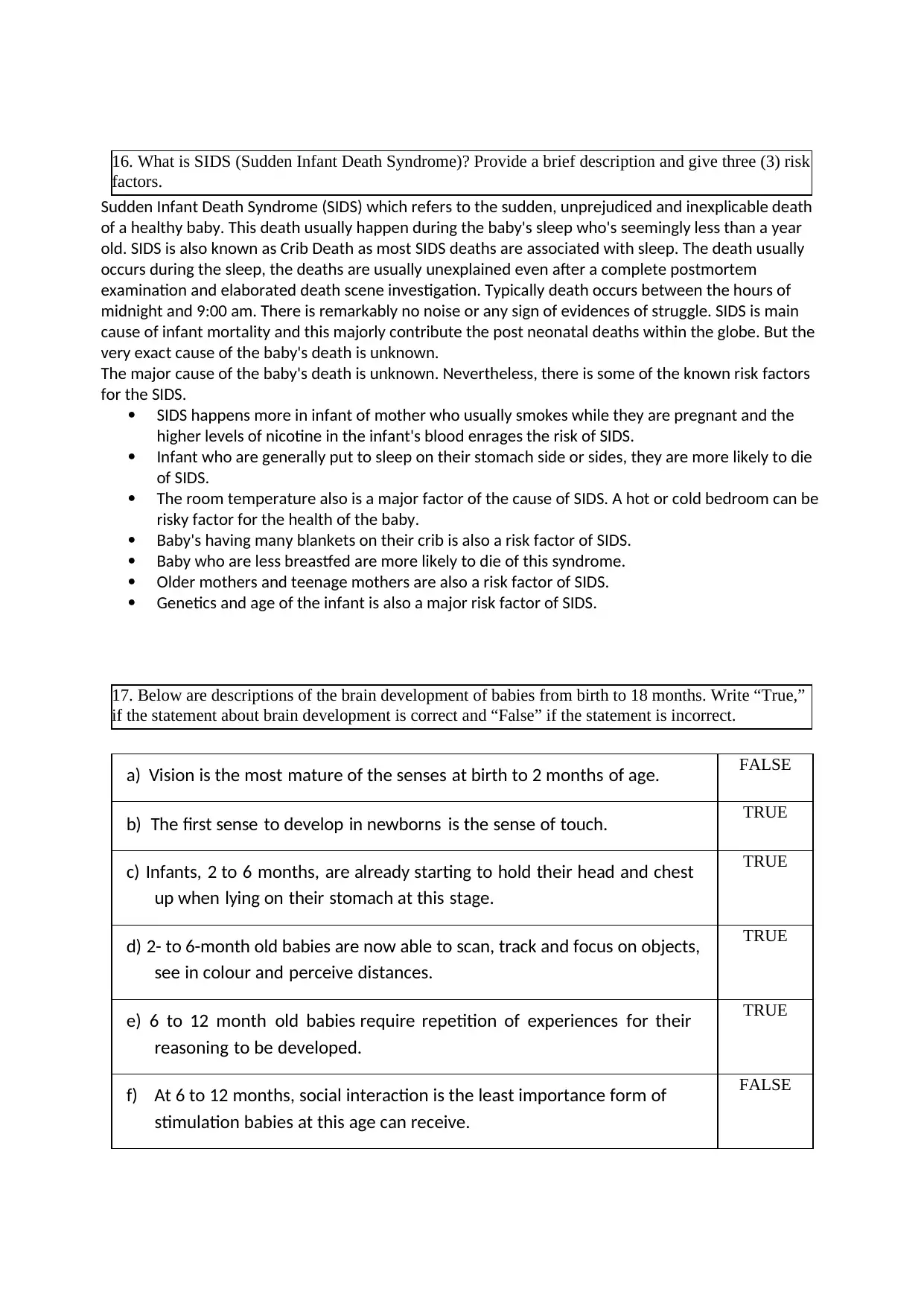
16. What is SIDS (Sudden Infant Death Syndrome)? Provide a brief description and give three (3) risk
factors.
Sudden Infant Death Syndrome (SIDS) which refers to the sudden, unprejudiced and inexplicable death
of a healthy baby. This death usually happen during the baby's sleep who's seemingly less than a year
old. SIDS is also known as Crib Death as most SIDS deaths are associated with sleep. The death usually
occurs during the sleep, the deaths are usually unexplained even after a complete postmortem
examination and elaborated death scene investigation. Typically death occurs between the hours of
midnight and 9:00 am. There is remarkably no noise or any sign of evidences of struggle. SIDS is main
cause of infant mortality and this majorly contribute the post neonatal deaths within the globe. But the
very exact cause of the baby's death is unknown.
The major cause of the baby's death is unknown. Nevertheless, there is some of the known risk factors
for the SIDS.
SIDS happens more in infant of mother who usually smokes while they are pregnant and the
higher levels of nicotine in the infant's blood enrages the risk of SIDS.
Infant who are generally put to sleep on their stomach side or sides, they are more likely to die
of SIDS.
The room temperature also is a major factor of the cause of SIDS. A hot or cold bedroom can be
risky factor for the health of the baby.
Baby's having many blankets on their crib is also a risk factor of SIDS.
Baby who are less breastfed are more likely to die of this syndrome.
Older mothers and teenage mothers are also a risk factor of SIDS.
Genetics and age of the infant is also a major risk factor of SIDS.
17. Below are descriptions of the brain development of babies from birth to 18 months. Write “True,”
if the statement about brain development is correct and “False” if the statement is incorrect.
a) Vision is the most mature of the senses at birth to 2 months of age. FALSE
b) The first sense to develop in newborns is the sense of touch. TRUE
c) Infants, 2 to 6 months, are already starting to hold their head and chest
up when lying on their stomach at this stage.
TRUE
d) 2- to 6-month old babies are now able to scan, track and focus on objects,
see in colour and perceive distances.
TRUE
e) 6 to 12 month old babies require repetition of experiences for their
reasoning to be developed.
TRUE
f) At 6 to 12 months, social interaction is the least importance form of
stimulation babies at this age can receive.
FALSE
factors.
Sudden Infant Death Syndrome (SIDS) which refers to the sudden, unprejudiced and inexplicable death
of a healthy baby. This death usually happen during the baby's sleep who's seemingly less than a year
old. SIDS is also known as Crib Death as most SIDS deaths are associated with sleep. The death usually
occurs during the sleep, the deaths are usually unexplained even after a complete postmortem
examination and elaborated death scene investigation. Typically death occurs between the hours of
midnight and 9:00 am. There is remarkably no noise or any sign of evidences of struggle. SIDS is main
cause of infant mortality and this majorly contribute the post neonatal deaths within the globe. But the
very exact cause of the baby's death is unknown.
The major cause of the baby's death is unknown. Nevertheless, there is some of the known risk factors
for the SIDS.
SIDS happens more in infant of mother who usually smokes while they are pregnant and the
higher levels of nicotine in the infant's blood enrages the risk of SIDS.
Infant who are generally put to sleep on their stomach side or sides, they are more likely to die
of SIDS.
The room temperature also is a major factor of the cause of SIDS. A hot or cold bedroom can be
risky factor for the health of the baby.
Baby's having many blankets on their crib is also a risk factor of SIDS.
Baby who are less breastfed are more likely to die of this syndrome.
Older mothers and teenage mothers are also a risk factor of SIDS.
Genetics and age of the infant is also a major risk factor of SIDS.
17. Below are descriptions of the brain development of babies from birth to 18 months. Write “True,”
if the statement about brain development is correct and “False” if the statement is incorrect.
a) Vision is the most mature of the senses at birth to 2 months of age. FALSE
b) The first sense to develop in newborns is the sense of touch. TRUE
c) Infants, 2 to 6 months, are already starting to hold their head and chest
up when lying on their stomach at this stage.
TRUE
d) 2- to 6-month old babies are now able to scan, track and focus on objects,
see in colour and perceive distances.
TRUE
e) 6 to 12 month old babies require repetition of experiences for their
reasoning to be developed.
TRUE
f) At 6 to 12 months, social interaction is the least importance form of
stimulation babies at this age can receive.
FALSE
Paraphrase This Document
Need a fresh take? Get an instant paraphrase of this document with our AI Paraphraser
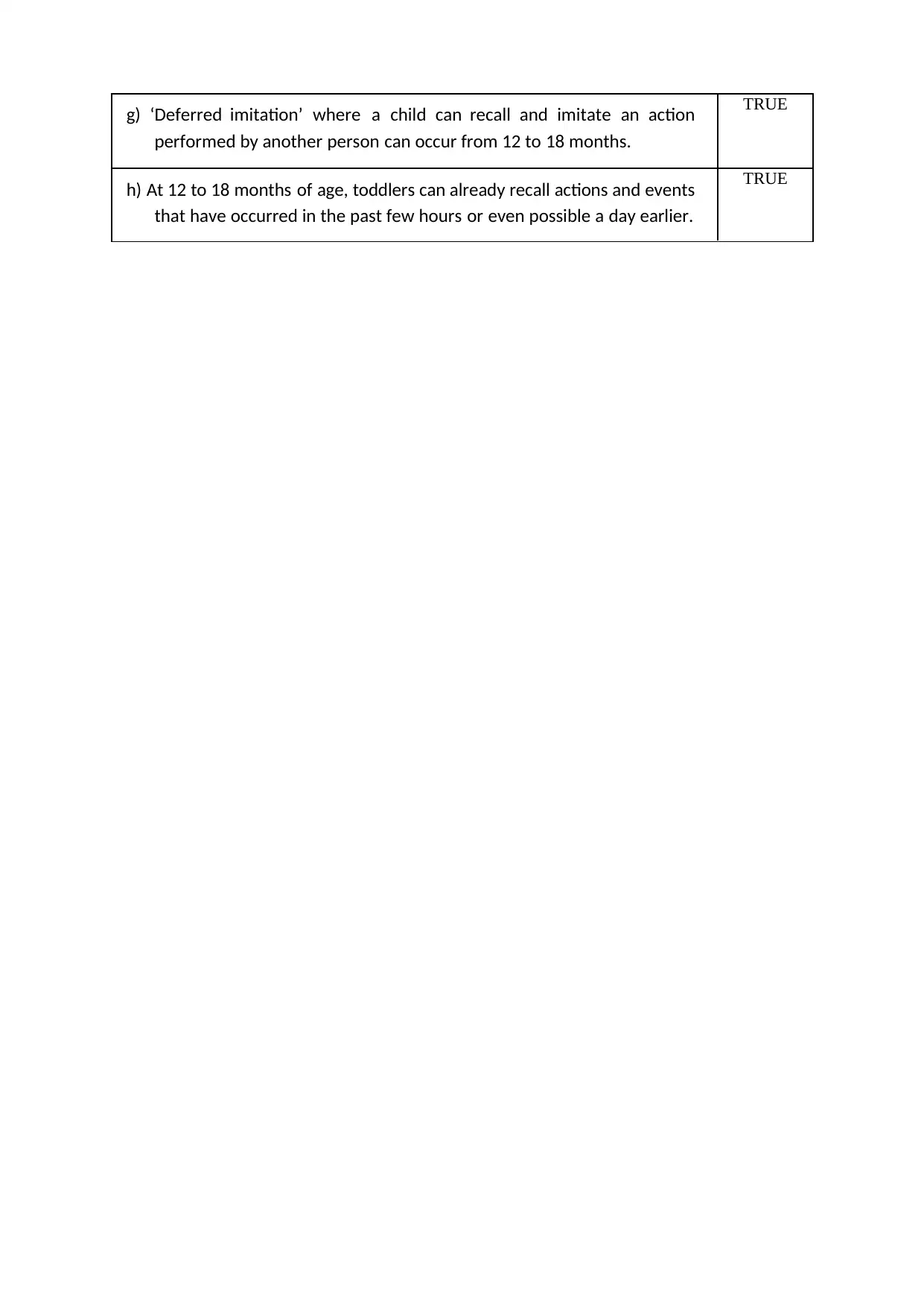
g) ‘Deferred imitation’ where a child can recall and imitate an action
performed by another person can occur from 12 to 18 months.
TRUE
h) At 12 to 18 months of age, toddlers can already recall actions and events
that have occurred in the past few hours or even possible a day earlier.
TRUE
performed by another person can occur from 12 to 18 months.
TRUE
h) At 12 to 18 months of age, toddlers can already recall actions and events
that have occurred in the past few hours or even possible a day earlier.
TRUE
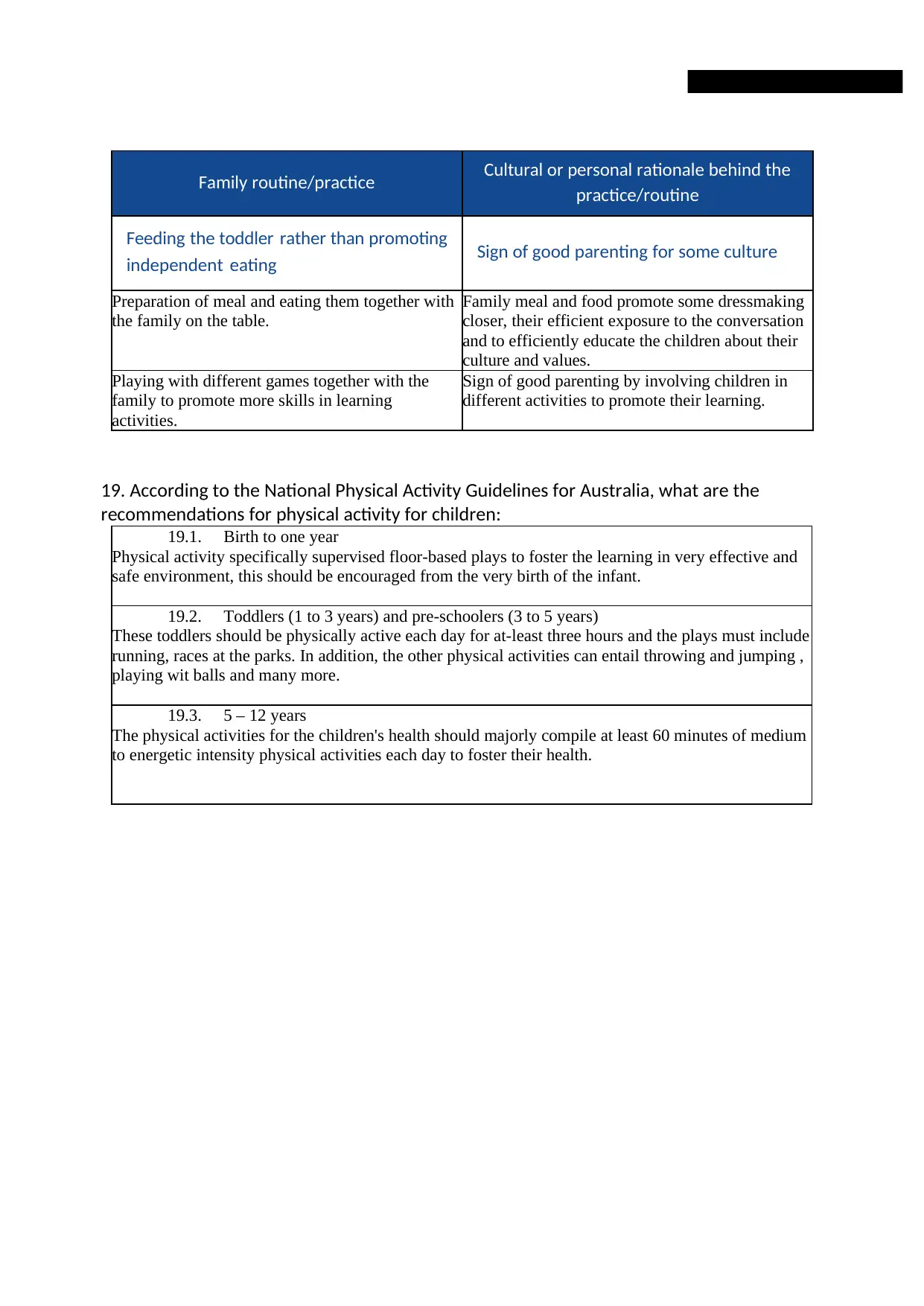
Family routine/practice Cultural or personal rationale behind the
practice/routine
Feeding the toddler rather than promoting
independent eating Sign of good parenting for some culture
Preparation of meal and eating them together with
the family on the table.
Family meal and food promote some dressmaking
closer, their efficient exposure to the conversation
and to efficiently educate the children about their
culture and values.
Playing with different games together with the
family to promote more skills in learning
activities.
Sign of good parenting by involving children in
different activities to promote their learning.
19. According to the National Physical Activity Guidelines for Australia, what are the
recommendations for physical activity for children:
19.1. Birth to one year
Physical activity specifically supervised floor-based plays to foster the learning in very effective and
safe environment, this should be encouraged from the very birth of the infant.
19.2. Toddlers (1 to 3 years) and pre-schoolers (3 to 5 years)
These toddlers should be physically active each day for at-least three hours and the plays must include
running, races at the parks. In addition, the other physical activities can entail throwing and jumping ,
playing wit balls and many more.
19.3. 5 – 12 years
The physical activities for the children's health should majorly compile at least 60 minutes of medium
to energetic intensity physical activities each day to foster their health.
practice/routine
Feeding the toddler rather than promoting
independent eating Sign of good parenting for some culture
Preparation of meal and eating them together with
the family on the table.
Family meal and food promote some dressmaking
closer, their efficient exposure to the conversation
and to efficiently educate the children about their
culture and values.
Playing with different games together with the
family to promote more skills in learning
activities.
Sign of good parenting by involving children in
different activities to promote their learning.
19. According to the National Physical Activity Guidelines for Australia, what are the
recommendations for physical activity for children:
19.1. Birth to one year
Physical activity specifically supervised floor-based plays to foster the learning in very effective and
safe environment, this should be encouraged from the very birth of the infant.
19.2. Toddlers (1 to 3 years) and pre-schoolers (3 to 5 years)
These toddlers should be physically active each day for at-least three hours and the plays must include
running, races at the parks. In addition, the other physical activities can entail throwing and jumping ,
playing wit balls and many more.
19.3. 5 – 12 years
The physical activities for the children's health should majorly compile at least 60 minutes of medium
to energetic intensity physical activities each day to foster their health.
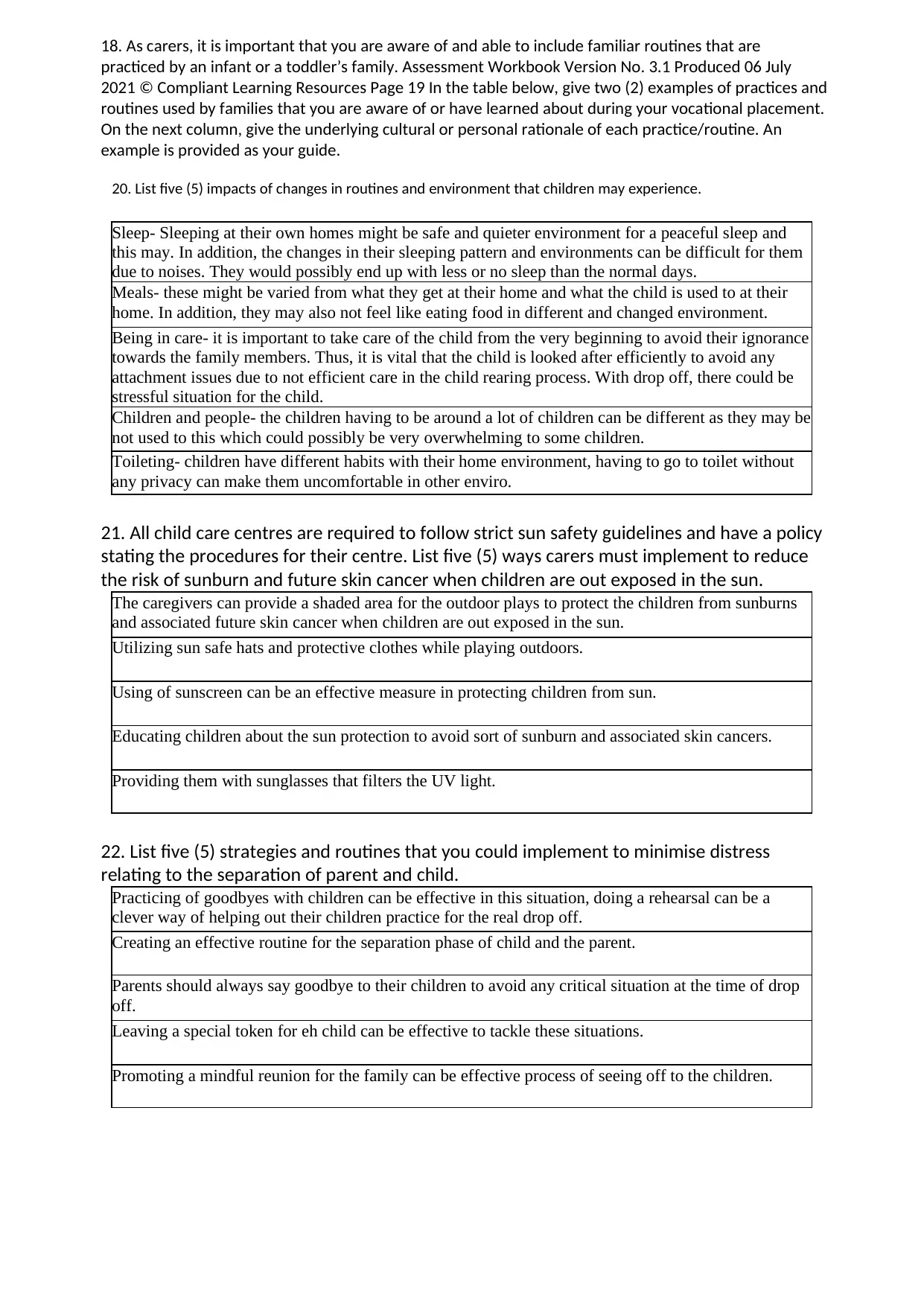
18. As carers, it is important that you are aware of and able to include familiar routines that are
practiced by an infant or a toddler’s family. Assessment Workbook Version No. 3.1 Produced 06 July
2021 © Compliant Learning Resources Page 19 In the table below, give two (2) examples of practices and
routines used by families that you are aware of or have learned about during your vocational placement.
On the next column, give the underlying cultural or personal rationale of each practice/routine. An
example is provided as your guide.
20. List five (5) impacts of changes in routines and environment that children may experience.
Sleep- Sleeping at their own homes might be safe and quieter environment for a peaceful sleep and
this may. In addition, the changes in their sleeping pattern and environments can be difficult for them
due to noises. They would possibly end up with less or no sleep than the normal days.
Meals- these might be varied from what they get at their home and what the child is used to at their
home. In addition, they may also not feel like eating food in different and changed environment.
Being in care- it is important to take care of the child from the very beginning to avoid their ignorance
towards the family members. Thus, it is vital that the child is looked after efficiently to avoid any
attachment issues due to not efficient care in the child rearing process. With drop off, there could be
stressful situation for the child.
Children and people- the children having to be around a lot of children can be different as they may be
not used to this which could possibly be very overwhelming to some children.
Toileting- children have different habits with their home environment, having to go to toilet without
any privacy can make them uncomfortable in other enviro.
21. All child care centres are required to follow strict sun safety guidelines and have a policy
stating the procedures for their centre. List five (5) ways carers must implement to reduce
the risk of sunburn and future skin cancer when children are out exposed in the sun.
The caregivers can provide a shaded area for the outdoor plays to protect the children from sunburns
and associated future skin cancer when children are out exposed in the sun.
Utilizing sun safe hats and protective clothes while playing outdoors.
Using of sunscreen can be an effective measure in protecting children from sun.
Educating children about the sun protection to avoid sort of sunburn and associated skin cancers.
Providing them with sunglasses that filters the UV light.
22. List five (5) strategies and routines that you could implement to minimise distress
relating to the separation of parent and child.
Practicing of goodbyes with children can be effective in this situation, doing a rehearsal can be a
clever way of helping out their children practice for the real drop off.
Creating an effective routine for the separation phase of child and the parent.
Parents should always say goodbye to their children to avoid any critical situation at the time of drop
off.
Leaving a special token for eh child can be effective to tackle these situations.
Promoting a mindful reunion for the family can be effective process of seeing off to the children.
practiced by an infant or a toddler’s family. Assessment Workbook Version No. 3.1 Produced 06 July
2021 © Compliant Learning Resources Page 19 In the table below, give two (2) examples of practices and
routines used by families that you are aware of or have learned about during your vocational placement.
On the next column, give the underlying cultural or personal rationale of each practice/routine. An
example is provided as your guide.
20. List five (5) impacts of changes in routines and environment that children may experience.
Sleep- Sleeping at their own homes might be safe and quieter environment for a peaceful sleep and
this may. In addition, the changes in their sleeping pattern and environments can be difficult for them
due to noises. They would possibly end up with less or no sleep than the normal days.
Meals- these might be varied from what they get at their home and what the child is used to at their
home. In addition, they may also not feel like eating food in different and changed environment.
Being in care- it is important to take care of the child from the very beginning to avoid their ignorance
towards the family members. Thus, it is vital that the child is looked after efficiently to avoid any
attachment issues due to not efficient care in the child rearing process. With drop off, there could be
stressful situation for the child.
Children and people- the children having to be around a lot of children can be different as they may be
not used to this which could possibly be very overwhelming to some children.
Toileting- children have different habits with their home environment, having to go to toilet without
any privacy can make them uncomfortable in other enviro.
21. All child care centres are required to follow strict sun safety guidelines and have a policy
stating the procedures for their centre. List five (5) ways carers must implement to reduce
the risk of sunburn and future skin cancer when children are out exposed in the sun.
The caregivers can provide a shaded area for the outdoor plays to protect the children from sunburns
and associated future skin cancer when children are out exposed in the sun.
Utilizing sun safe hats and protective clothes while playing outdoors.
Using of sunscreen can be an effective measure in protecting children from sun.
Educating children about the sun protection to avoid sort of sunburn and associated skin cancers.
Providing them with sunglasses that filters the UV light.
22. List five (5) strategies and routines that you could implement to minimise distress
relating to the separation of parent and child.
Practicing of goodbyes with children can be effective in this situation, doing a rehearsal can be a
clever way of helping out their children practice for the real drop off.
Creating an effective routine for the separation phase of child and the parent.
Parents should always say goodbye to their children to avoid any critical situation at the time of drop
off.
Leaving a special token for eh child can be effective to tackle these situations.
Promoting a mindful reunion for the family can be effective process of seeing off to the children.
Secure Best Marks with AI Grader
Need help grading? Try our AI Grader for instant feedback on your assignments.
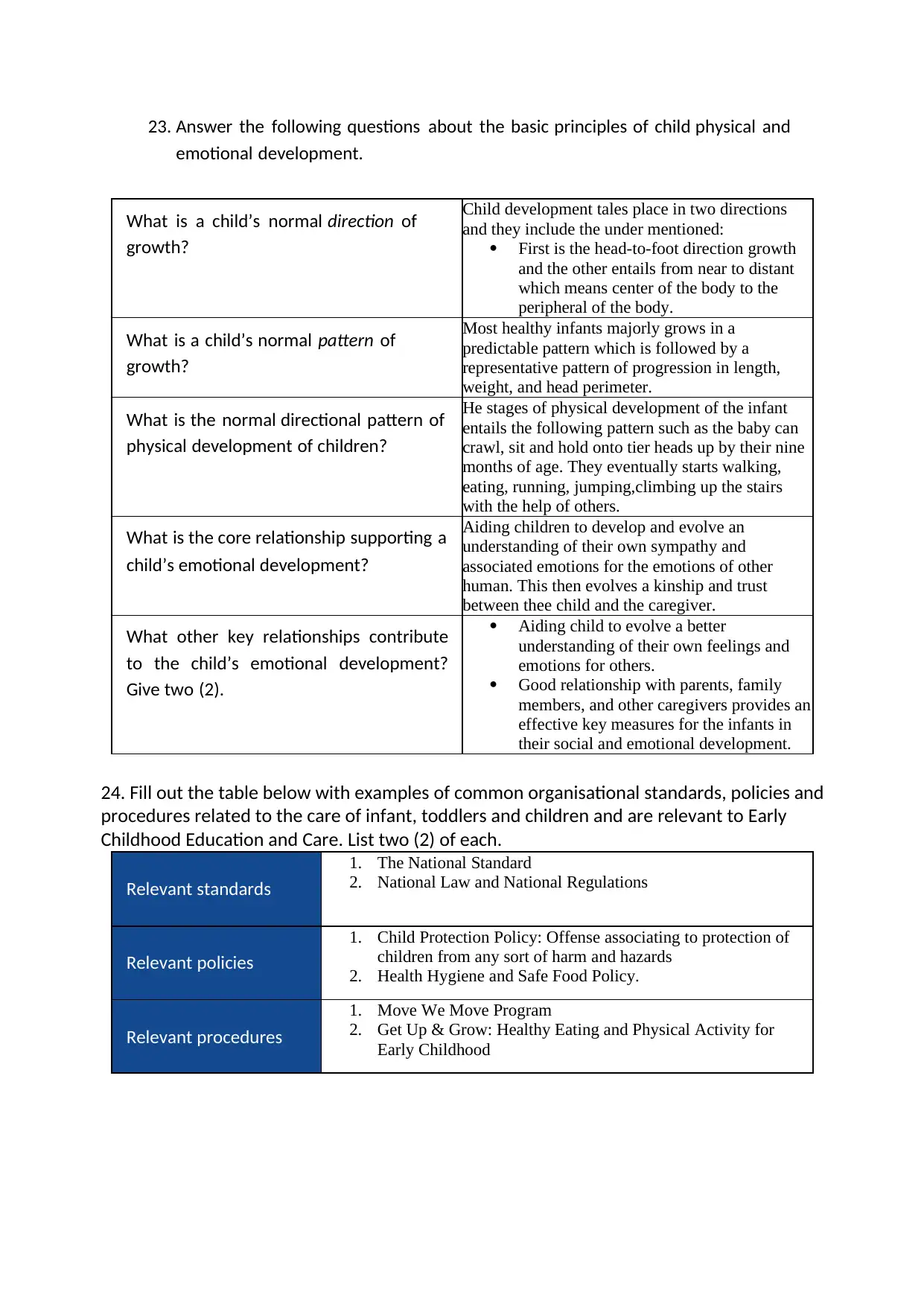
23. Answer the following questions about the basic principles of child physical and
emotional development.
What is a child’s normal direction of
growth?
Child development tales place in two directions
and they include the under mentioned:
First is the head-to-foot direction growth
and the other entails from near to distant
which means center of the body to the
peripheral of the body.
What is a child’s normal pattern of
growth?
Most healthy infants majorly grows in a
predictable pattern which is followed by a
representative pattern of progression in length,
weight, and head perimeter.
What is the normal directional pattern of
physical development of children?
He stages of physical development of the infant
entails the following pattern such as the baby can
crawl, sit and hold onto tier heads up by their nine
months of age. They eventually starts walking,
eating, running, jumping,climbing up the stairs
with the help of others.
What is the core relationship supporting a
child’s emotional development?
Aiding children to develop and evolve an
understanding of their own sympathy and
associated emotions for the emotions of other
human. This then evolves a kinship and trust
between thee child and the caregiver.
What other key relationships contribute
to the child’s emotional development?
Give two (2).
Aiding child to evolve a better
understanding of their own feelings and
emotions for others.
Good relationship with parents, family
members, and other caregivers provides an
effective key measures for the infants in
their social and emotional development.
24. Fill out the table below with examples of common organisational standards, policies and
procedures related to the care of infant, toddlers and children and are relevant to Early
Childhood Education and Care. List two (2) of each.
Relevant standards
1. The National Standard
2. National Law and National Regulations
Relevant policies
1. Child Protection Policy: Offense associating to protection of
children from any sort of harm and hazards
2. Health Hygiene and Safe Food Policy.
Relevant procedures
1. Move We Move Program
2. Get Up & Grow: Healthy Eating and Physical Activity for
Early Childhood
emotional development.
What is a child’s normal direction of
growth?
Child development tales place in two directions
and they include the under mentioned:
First is the head-to-foot direction growth
and the other entails from near to distant
which means center of the body to the
peripheral of the body.
What is a child’s normal pattern of
growth?
Most healthy infants majorly grows in a
predictable pattern which is followed by a
representative pattern of progression in length,
weight, and head perimeter.
What is the normal directional pattern of
physical development of children?
He stages of physical development of the infant
entails the following pattern such as the baby can
crawl, sit and hold onto tier heads up by their nine
months of age. They eventually starts walking,
eating, running, jumping,climbing up the stairs
with the help of others.
What is the core relationship supporting a
child’s emotional development?
Aiding children to develop and evolve an
understanding of their own sympathy and
associated emotions for the emotions of other
human. This then evolves a kinship and trust
between thee child and the caregiver.
What other key relationships contribute
to the child’s emotional development?
Give two (2).
Aiding child to evolve a better
understanding of their own feelings and
emotions for others.
Good relationship with parents, family
members, and other caregivers provides an
effective key measures for the infants in
their social and emotional development.
24. Fill out the table below with examples of common organisational standards, policies and
procedures related to the care of infant, toddlers and children and are relevant to Early
Childhood Education and Care. List two (2) of each.
Relevant standards
1. The National Standard
2. National Law and National Regulations
Relevant policies
1. Child Protection Policy: Offense associating to protection of
children from any sort of harm and hazards
2. Health Hygiene and Safe Food Policy.
Relevant procedures
1. Move We Move Program
2. Get Up & Grow: Healthy Eating and Physical Activity for
Early Childhood
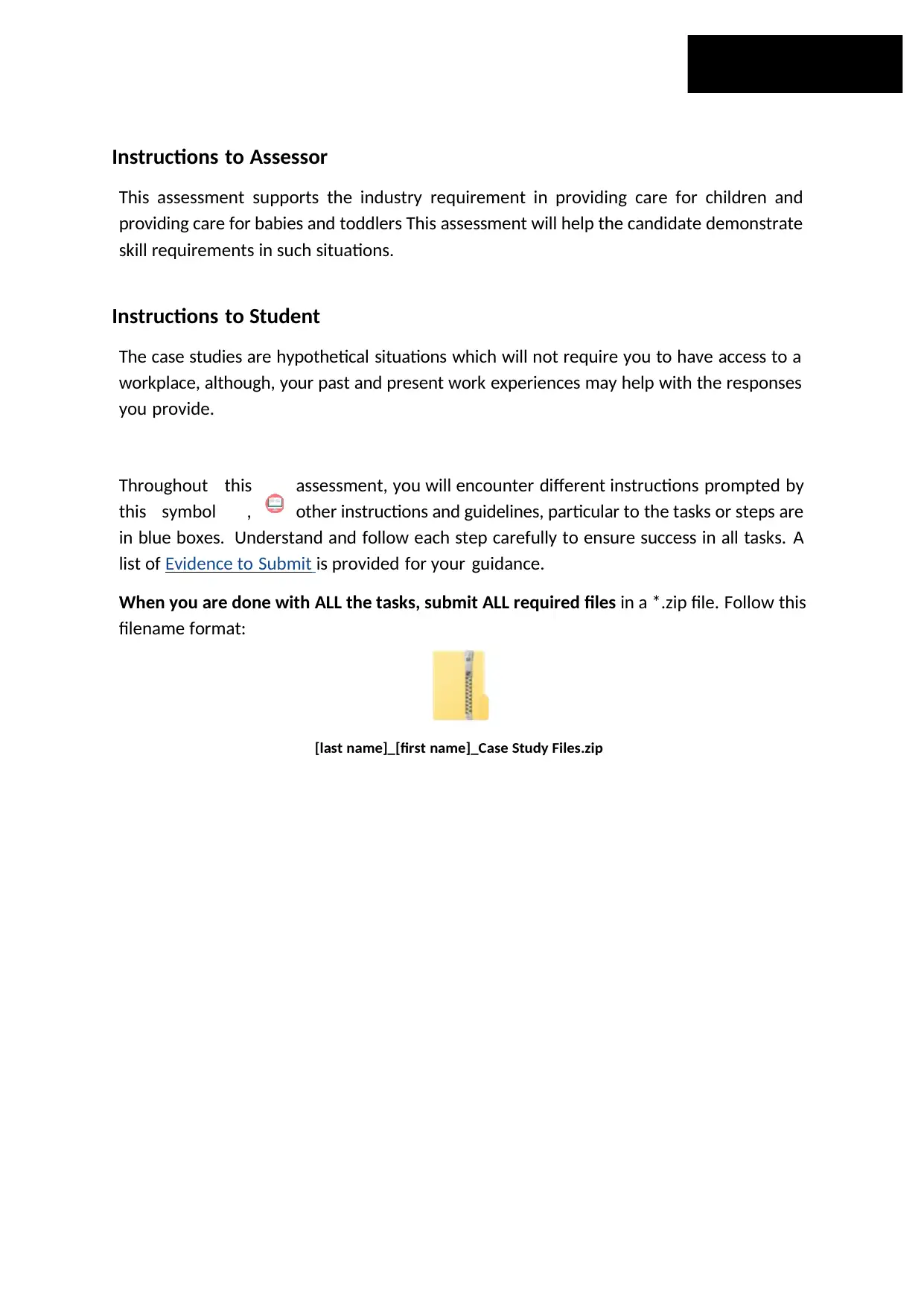
Instructions to Assessor
This assessment supports the industry requirement in providing care for children and
providing care for babies and toddlers This assessment will help the candidate demonstrate
skill requirements in such situations.
Instructions to Student
The case studies are hypothetical situations which will not require you to have access to a
workplace, although, your past and present work experiences may help with the responses
you provide.
Throughout this assessment, you will encounter different instructions prompted by
this symbol , other instructions and guidelines, particular to the tasks or steps are
in blue boxes. Understand and follow each step carefully to ensure success in all tasks. A
list of Evidence to Submit is provided for your guidance.
When you are done with ALL the tasks, submit ALL required files in a *.zip file. Follow this
filename format:
[last name]_[first name]_Case Study Files.zip
This assessment supports the industry requirement in providing care for children and
providing care for babies and toddlers This assessment will help the candidate demonstrate
skill requirements in such situations.
Instructions to Student
The case studies are hypothetical situations which will not require you to have access to a
workplace, although, your past and present work experiences may help with the responses
you provide.
Throughout this assessment, you will encounter different instructions prompted by
this symbol , other instructions and guidelines, particular to the tasks or steps are
in blue boxes. Understand and follow each step carefully to ensure success in all tasks. A
list of Evidence to Submit is provided for your guidance.
When you are done with ALL the tasks, submit ALL required files in a *.zip file. Follow this
filename format:
[last name]_[first name]_Case Study Files.zip
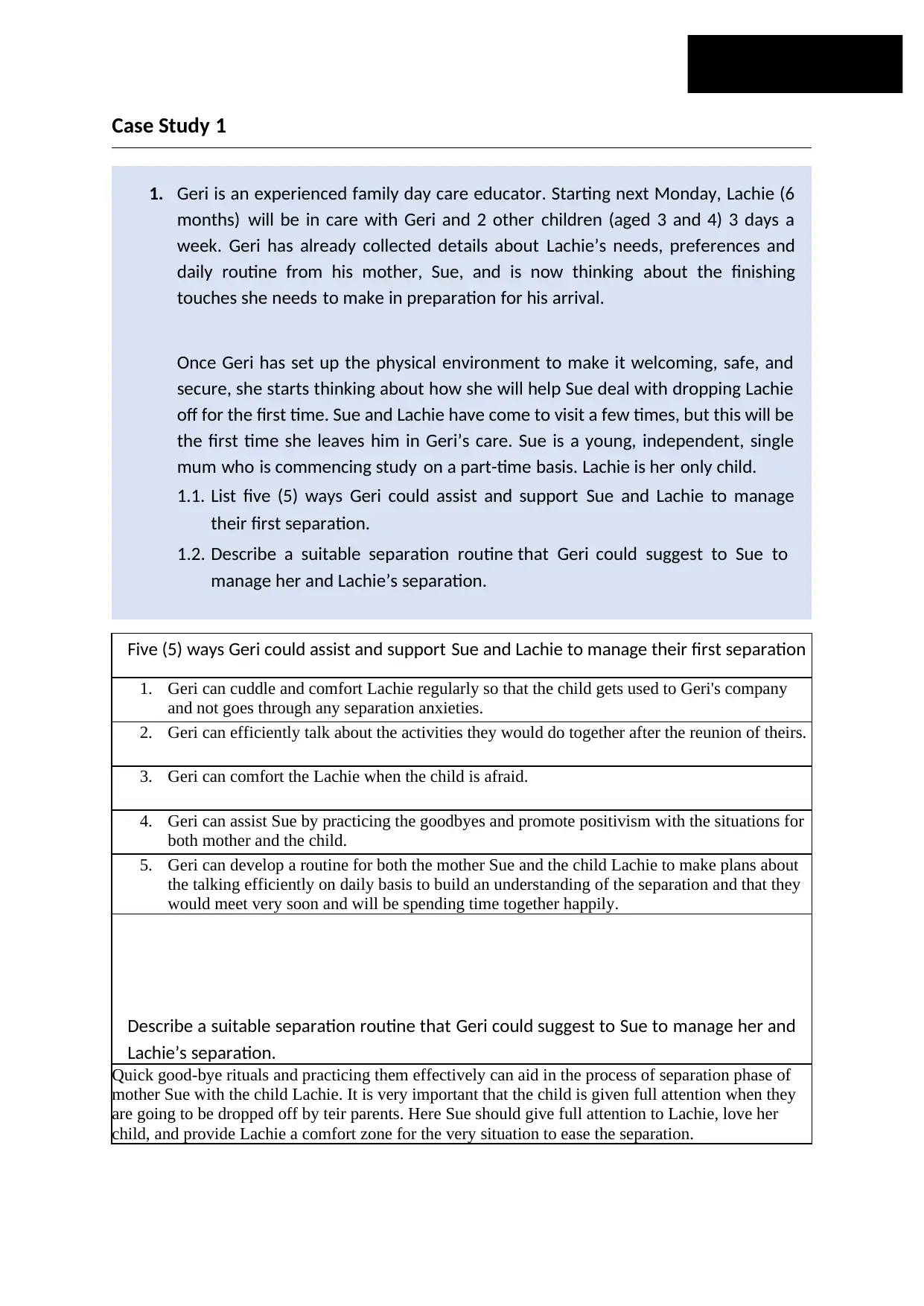
Case Study 1
1. Geri is an experienced family day care educator. Starting next Monday, Lachie (6
months) will be in care with Geri and 2 other children (aged 3 and 4) 3 days a
week. Geri has already collected details about Lachie’s needs, preferences and
daily routine from his mother, Sue, and is now thinking about the finishing
touches she needs to make in preparation for his arrival.
Once Geri has set up the physical environment to make it welcoming, safe, and
secure, she starts thinking about how she will help Sue deal with dropping Lachie
off for the first time. Sue and Lachie have come to visit a few times, but this will be
the first time she leaves him in Geri’s care. Sue is a young, independent, single
mum who is commencing study on a part-time basis. Lachie is her only child.
1.1. List five (5) ways Geri could assist and support Sue and Lachie to manage
their first separation.
1.2. Describe a suitable separation routine that Geri could suggest to Sue to
manage her and Lachie’s separation.
Five (5) ways Geri could assist and support Sue and Lachie to manage their first separation
1. Geri can cuddle and comfort Lachie regularly so that the child gets used to Geri's company
and not goes through any separation anxieties.
2. Geri can efficiently talk about the activities they would do together after the reunion of theirs.
3. Geri can comfort the Lachie when the child is afraid.
4. Geri can assist Sue by practicing the goodbyes and promote positivism with the situations for
both mother and the child.
5. Geri can develop a routine for both the mother Sue and the child Lachie to make plans about
the talking efficiently on daily basis to build an understanding of the separation and that they
would meet very soon and will be spending time together happily.
Describe a suitable separation routine that Geri could suggest to Sue to manage her and
Lachie’s separation.
Quick good-bye rituals and practicing them effectively can aid in the process of separation phase of
mother Sue with the child Lachie. It is very important that the child is given full attention when they
are going to be dropped off by teir parents. Here Sue should give full attention to Lachie, love her
child, and provide Lachie a comfort zone for the very situation to ease the separation.
1. Geri is an experienced family day care educator. Starting next Monday, Lachie (6
months) will be in care with Geri and 2 other children (aged 3 and 4) 3 days a
week. Geri has already collected details about Lachie’s needs, preferences and
daily routine from his mother, Sue, and is now thinking about the finishing
touches she needs to make in preparation for his arrival.
Once Geri has set up the physical environment to make it welcoming, safe, and
secure, she starts thinking about how she will help Sue deal with dropping Lachie
off for the first time. Sue and Lachie have come to visit a few times, but this will be
the first time she leaves him in Geri’s care. Sue is a young, independent, single
mum who is commencing study on a part-time basis. Lachie is her only child.
1.1. List five (5) ways Geri could assist and support Sue and Lachie to manage
their first separation.
1.2. Describe a suitable separation routine that Geri could suggest to Sue to
manage her and Lachie’s separation.
Five (5) ways Geri could assist and support Sue and Lachie to manage their first separation
1. Geri can cuddle and comfort Lachie regularly so that the child gets used to Geri's company
and not goes through any separation anxieties.
2. Geri can efficiently talk about the activities they would do together after the reunion of theirs.
3. Geri can comfort the Lachie when the child is afraid.
4. Geri can assist Sue by practicing the goodbyes and promote positivism with the situations for
both mother and the child.
5. Geri can develop a routine for both the mother Sue and the child Lachie to make plans about
the talking efficiently on daily basis to build an understanding of the separation and that they
would meet very soon and will be spending time together happily.
Describe a suitable separation routine that Geri could suggest to Sue to manage her and
Lachie’s separation.
Quick good-bye rituals and practicing them effectively can aid in the process of separation phase of
mother Sue with the child Lachie. It is very important that the child is given full attention when they
are going to be dropped off by teir parents. Here Sue should give full attention to Lachie, love her
child, and provide Lachie a comfort zone for the very situation to ease the separation.
Paraphrase This Document
Need a fresh take? Get an instant paraphrase of this document with our AI Paraphraser
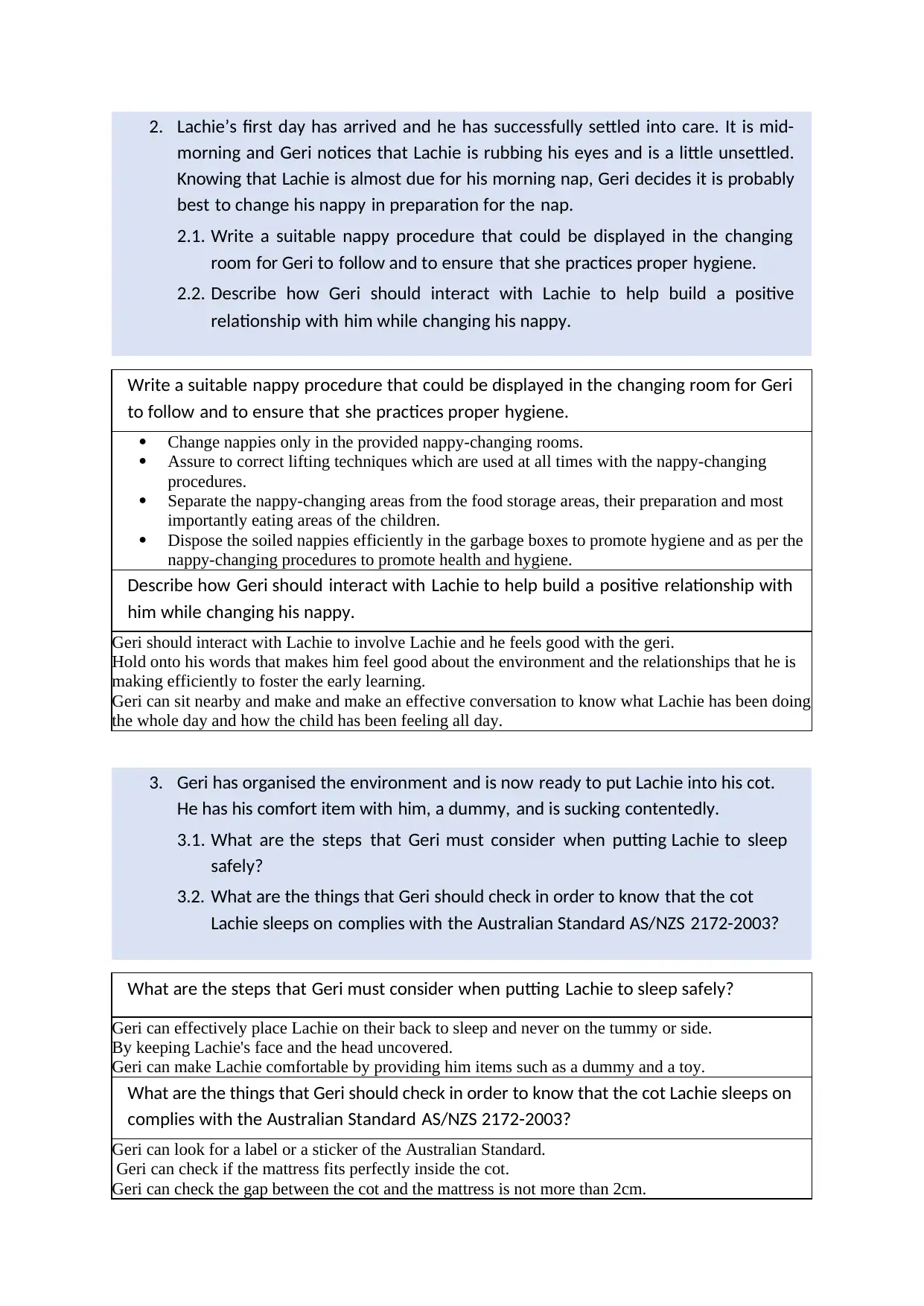
2. Lachie’s first day has arrived and he has successfully settled into care. It is mid-
morning and Geri notices that Lachie is rubbing his eyes and is a little unsettled.
Knowing that Lachie is almost due for his morning nap, Geri decides it is probably
best to change his nappy in preparation for the nap.
2.1. Write a suitable nappy procedure that could be displayed in the changing
room for Geri to follow and to ensure that she practices proper hygiene.
2.2. Describe how Geri should interact with Lachie to help build a positive
relationship with him while changing his nappy.
Write a suitable nappy procedure that could be displayed in the changing room for Geri
to follow and to ensure that she practices proper hygiene.
Change nappies only in the provided nappy-changing rooms.
Assure to correct lifting techniques which are used at all times with the nappy-changing
procedures.
Separate the nappy-changing areas from the food storage areas, their preparation and most
importantly eating areas of the children.
Dispose the soiled nappies efficiently in the garbage boxes to promote hygiene and as per the
nappy-changing procedures to promote health and hygiene.
Describe how Geri should interact with Lachie to help build a positive relationship with
him while changing his nappy.
Geri should interact with Lachie to involve Lachie and he feels good with the geri.
Hold onto his words that makes him feel good about the environment and the relationships that he is
making efficiently to foster the early learning.
Geri can sit nearby and make and make an effective conversation to know what Lachie has been doing
the whole day and how the child has been feeling all day.
3. Geri has organised the environment and is now ready to put Lachie into his cot.
He has his comfort item with him, a dummy, and is sucking contentedly.
3.1. What are the steps that Geri must consider when putting Lachie to sleep
safely?
3.2. What are the things that Geri should check in order to know that the cot
Lachie sleeps on complies with the Australian Standard AS/NZS 2172-2003?
What are the steps that Geri must consider when putting Lachie to sleep safely?
Geri can effectively place Lachie on their back to sleep and never on the tummy or side.
By keeping Lachie's face and the head uncovered.
Geri can make Lachie comfortable by providing him items such as a dummy and a toy.
What are the things that Geri should check in order to know that the cot Lachie sleeps on
complies with the Australian Standard AS/NZS 2172-2003?
Geri can look for a label or a sticker of the Australian Standard.
Geri can check if the mattress fits perfectly inside the cot.
Geri can check the gap between the cot and the mattress is not more than 2cm.
morning and Geri notices that Lachie is rubbing his eyes and is a little unsettled.
Knowing that Lachie is almost due for his morning nap, Geri decides it is probably
best to change his nappy in preparation for the nap.
2.1. Write a suitable nappy procedure that could be displayed in the changing
room for Geri to follow and to ensure that she practices proper hygiene.
2.2. Describe how Geri should interact with Lachie to help build a positive
relationship with him while changing his nappy.
Write a suitable nappy procedure that could be displayed in the changing room for Geri
to follow and to ensure that she practices proper hygiene.
Change nappies only in the provided nappy-changing rooms.
Assure to correct lifting techniques which are used at all times with the nappy-changing
procedures.
Separate the nappy-changing areas from the food storage areas, their preparation and most
importantly eating areas of the children.
Dispose the soiled nappies efficiently in the garbage boxes to promote hygiene and as per the
nappy-changing procedures to promote health and hygiene.
Describe how Geri should interact with Lachie to help build a positive relationship with
him while changing his nappy.
Geri should interact with Lachie to involve Lachie and he feels good with the geri.
Hold onto his words that makes him feel good about the environment and the relationships that he is
making efficiently to foster the early learning.
Geri can sit nearby and make and make an effective conversation to know what Lachie has been doing
the whole day and how the child has been feeling all day.
3. Geri has organised the environment and is now ready to put Lachie into his cot.
He has his comfort item with him, a dummy, and is sucking contentedly.
3.1. What are the steps that Geri must consider when putting Lachie to sleep
safely?
3.2. What are the things that Geri should check in order to know that the cot
Lachie sleeps on complies with the Australian Standard AS/NZS 2172-2003?
What are the steps that Geri must consider when putting Lachie to sleep safely?
Geri can effectively place Lachie on their back to sleep and never on the tummy or side.
By keeping Lachie's face and the head uncovered.
Geri can make Lachie comfortable by providing him items such as a dummy and a toy.
What are the things that Geri should check in order to know that the cot Lachie sleeps on
complies with the Australian Standard AS/NZS 2172-2003?
Geri can look for a label or a sticker of the Australian Standard.
Geri can check if the mattress fits perfectly inside the cot.
Geri can check the gap between the cot and the mattress is not more than 2cm.
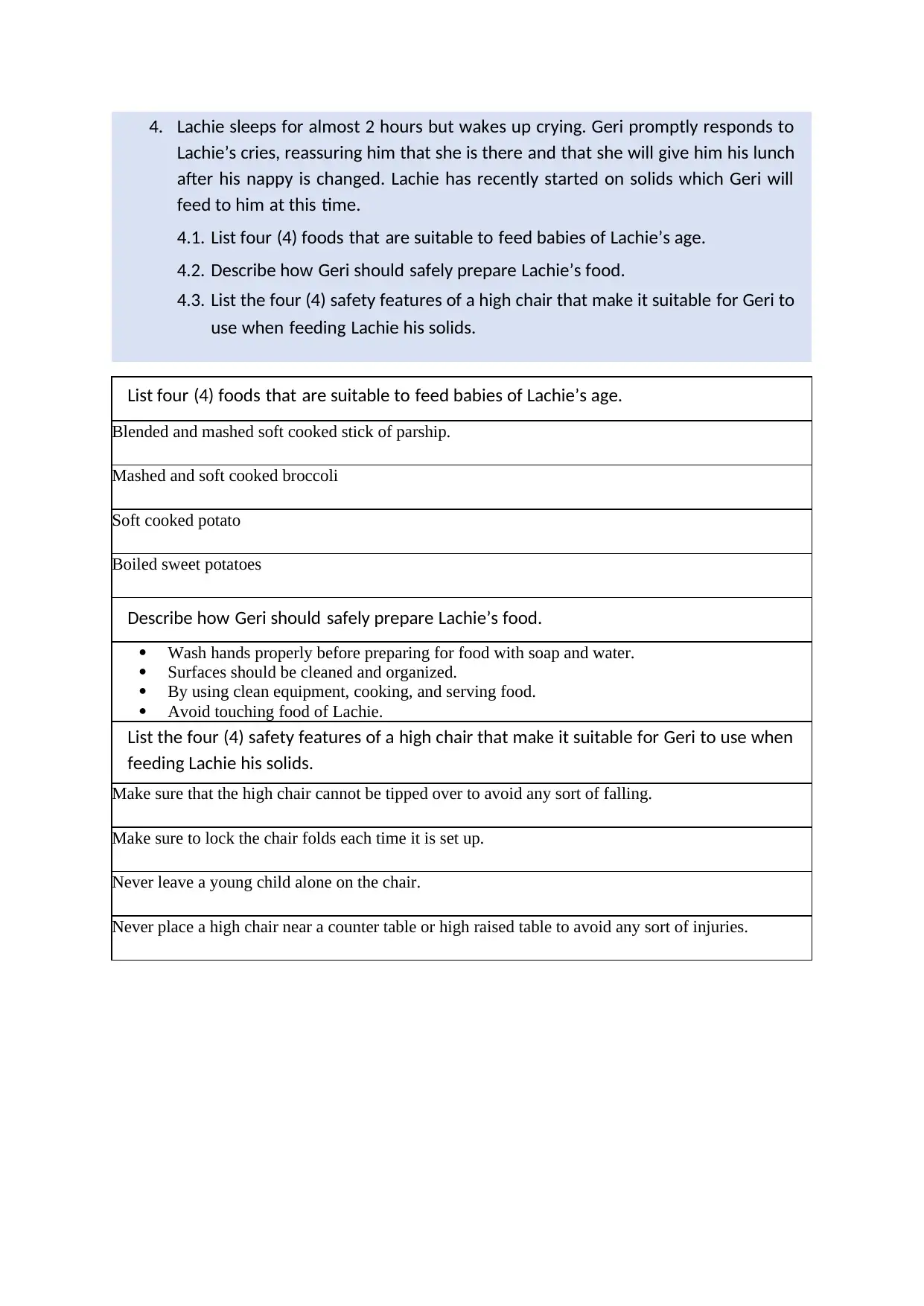
4. Lachie sleeps for almost 2 hours but wakes up crying. Geri promptly responds to
Lachie’s cries, reassuring him that she is there and that she will give him his lunch
after his nappy is changed. Lachie has recently started on solids which Geri will
feed to him at this time.
4.1. List four (4) foods that are suitable to feed babies of Lachie’s age.
4.2. Describe how Geri should safely prepare Lachie’s food.
4.3. List the four (4) safety features of a high chair that make it suitable for Geri to
use when feeding Lachie his solids.
List four (4) foods that are suitable to feed babies of Lachie’s age.
Blended and mashed soft cooked stick of parship.
Mashed and soft cooked broccoli
Soft cooked potato
Boiled sweet potatoes
Describe how Geri should safely prepare Lachie’s food.
Wash hands properly before preparing for food with soap and water.
Surfaces should be cleaned and organized.
By using clean equipment, cooking, and serving food.
Avoid touching food of Lachie.
List the four (4) safety features of a high chair that make it suitable for Geri to use when
feeding Lachie his solids.
Make sure that the high chair cannot be tipped over to avoid any sort of falling.
Make sure to lock the chair folds each time it is set up.
Never leave a young child alone on the chair.
Never place a high chair near a counter table or high raised table to avoid any sort of injuries.
Lachie’s cries, reassuring him that she is there and that she will give him his lunch
after his nappy is changed. Lachie has recently started on solids which Geri will
feed to him at this time.
4.1. List four (4) foods that are suitable to feed babies of Lachie’s age.
4.2. Describe how Geri should safely prepare Lachie’s food.
4.3. List the four (4) safety features of a high chair that make it suitable for Geri to
use when feeding Lachie his solids.
List four (4) foods that are suitable to feed babies of Lachie’s age.
Blended and mashed soft cooked stick of parship.
Mashed and soft cooked broccoli
Soft cooked potato
Boiled sweet potatoes
Describe how Geri should safely prepare Lachie’s food.
Wash hands properly before preparing for food with soap and water.
Surfaces should be cleaned and organized.
By using clean equipment, cooking, and serving food.
Avoid touching food of Lachie.
List the four (4) safety features of a high chair that make it suitable for Geri to use when
feeding Lachie his solids.
Make sure that the high chair cannot be tipped over to avoid any sort of falling.
Make sure to lock the chair folds each time it is set up.
Never leave a young child alone on the chair.
Never place a high chair near a counter table or high raised table to avoid any sort of injuries.
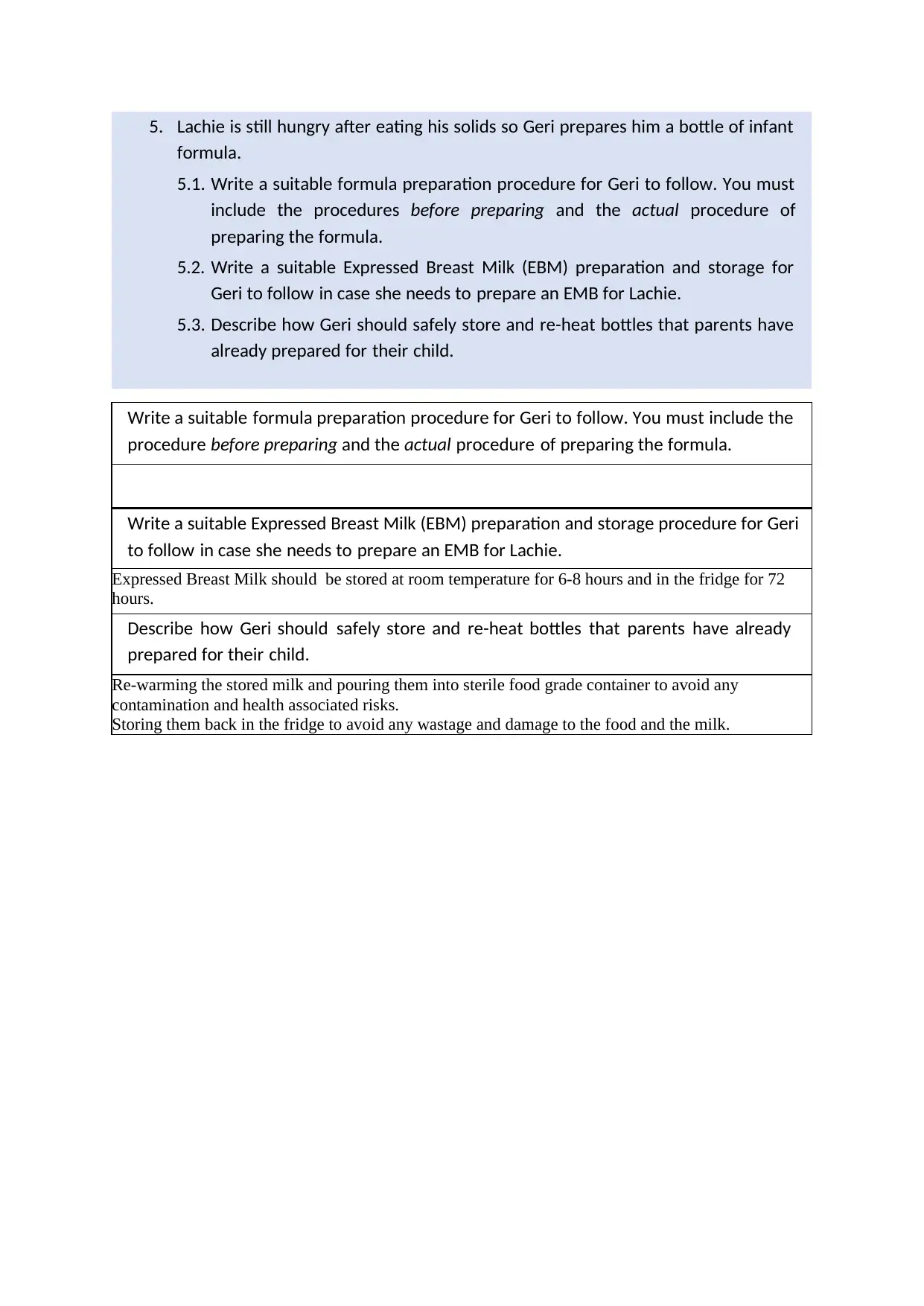
5. Lachie is still hungry after eating his solids so Geri prepares him a bottle of infant
formula.
5.1. Write a suitable formula preparation procedure for Geri to follow. You must
include the procedures before preparing and the actual procedure of
preparing the formula.
5.2. Write a suitable Expressed Breast Milk (EBM) preparation and storage for
Geri to follow in case she needs to prepare an EMB for Lachie.
5.3. Describe how Geri should safely store and re-heat bottles that parents have
already prepared for their child.
Write a suitable formula preparation procedure for Geri to follow. You must include the
procedure before preparing and the actual procedure of preparing the formula.
Write a suitable Expressed Breast Milk (EBM) preparation and storage procedure for Geri
to follow in case she needs to prepare an EMB for Lachie.
Expressed Breast Milk should be stored at room temperature for 6-8 hours and in the fridge for 72
hours.
Describe how Geri should safely store and re-heat bottles that parents have already
prepared for their child.
Re-warming the stored milk and pouring them into sterile food grade container to avoid any
contamination and health associated risks.
Storing them back in the fridge to avoid any wastage and damage to the food and the milk.
formula.
5.1. Write a suitable formula preparation procedure for Geri to follow. You must
include the procedures before preparing and the actual procedure of
preparing the formula.
5.2. Write a suitable Expressed Breast Milk (EBM) preparation and storage for
Geri to follow in case she needs to prepare an EMB for Lachie.
5.3. Describe how Geri should safely store and re-heat bottles that parents have
already prepared for their child.
Write a suitable formula preparation procedure for Geri to follow. You must include the
procedure before preparing and the actual procedure of preparing the formula.
Write a suitable Expressed Breast Milk (EBM) preparation and storage procedure for Geri
to follow in case she needs to prepare an EMB for Lachie.
Expressed Breast Milk should be stored at room temperature for 6-8 hours and in the fridge for 72
hours.
Describe how Geri should safely store and re-heat bottles that parents have already
prepared for their child.
Re-warming the stored milk and pouring them into sterile food grade container to avoid any
contamination and health associated risks.
Storing them back in the fridge to avoid any wastage and damage to the food and the milk.
Secure Best Marks with AI Grader
Need help grading? Try our AI Grader for instant feedback on your assignments.

Checkpoint
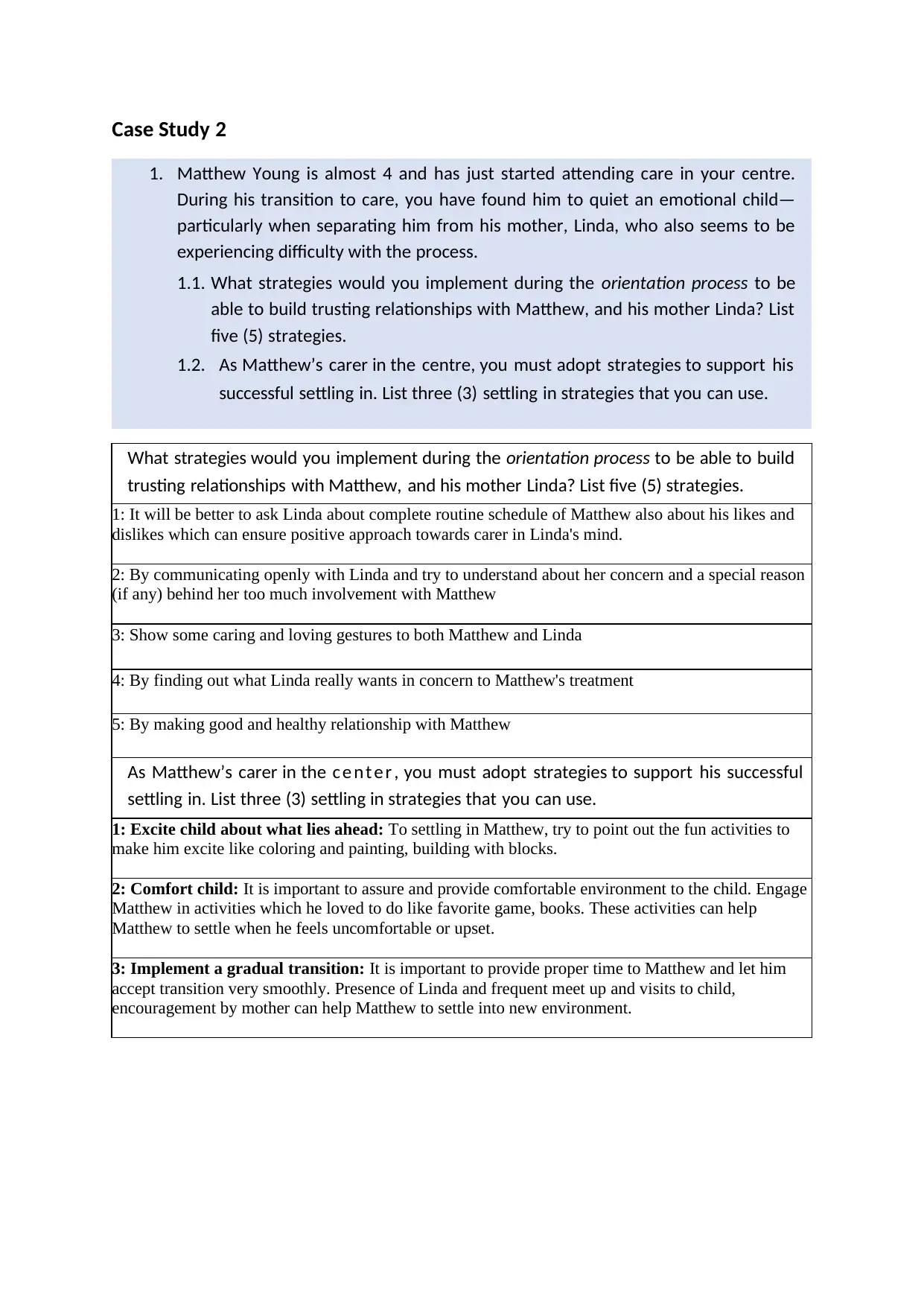
Case Study 2
1. Matthew Young is almost 4 and has just started attending care in your centre.
During his transition to care, you have found him to quiet an emotional child—
particularly when separating him from his mother, Linda, who also seems to be
experiencing difficulty with the process.
1.1. What strategies would you implement during the orientation process to be
able to build trusting relationships with Matthew, and his mother Linda? List
five (5) strategies.
1.2. As Matthew’s carer in the centre, you must adopt strategies to support his
successful settling in. List three (3) settling in strategies that you can use.
What strategies would you implement during the orientation process to be able to build
trusting relationships with Matthew, and his mother Linda? List five (5) strategies.
1: It will be better to ask Linda about complete routine schedule of Matthew also about his likes and
dislikes which can ensure positive approach towards carer in Linda's mind.
2: By communicating openly with Linda and try to understand about her concern and a special reason
(if any) behind her too much involvement with Matthew
3: Show some caring and loving gestures to both Matthew and Linda
4: By finding out what Linda really wants in concern to Matthew's treatment
5: By making good and healthy relationship with Matthew
As Matthew’s carer in the c e n t e r , you must adopt strategies to support his successful
settling in. List three (3) settling in strategies that you can use.
1: Excite child about what lies ahead: To settling in Matthew, try to point out the fun activities to
make him excite like coloring and painting, building with blocks.
2: Comfort child: It is important to assure and provide comfortable environment to the child. Engage
Matthew in activities which he loved to do like favorite game, books. These activities can help
Matthew to settle when he feels uncomfortable or upset.
3: Implement a gradual transition: It is important to provide proper time to Matthew and let him
accept transition very smoothly. Presence of Linda and frequent meet up and visits to child,
encouragement by mother can help Matthew to settle into new environment.
1. Matthew Young is almost 4 and has just started attending care in your centre.
During his transition to care, you have found him to quiet an emotional child—
particularly when separating him from his mother, Linda, who also seems to be
experiencing difficulty with the process.
1.1. What strategies would you implement during the orientation process to be
able to build trusting relationships with Matthew, and his mother Linda? List
five (5) strategies.
1.2. As Matthew’s carer in the centre, you must adopt strategies to support his
successful settling in. List three (3) settling in strategies that you can use.
What strategies would you implement during the orientation process to be able to build
trusting relationships with Matthew, and his mother Linda? List five (5) strategies.
1: It will be better to ask Linda about complete routine schedule of Matthew also about his likes and
dislikes which can ensure positive approach towards carer in Linda's mind.
2: By communicating openly with Linda and try to understand about her concern and a special reason
(if any) behind her too much involvement with Matthew
3: Show some caring and loving gestures to both Matthew and Linda
4: By finding out what Linda really wants in concern to Matthew's treatment
5: By making good and healthy relationship with Matthew
As Matthew’s carer in the c e n t e r , you must adopt strategies to support his successful
settling in. List three (3) settling in strategies that you can use.
1: Excite child about what lies ahead: To settling in Matthew, try to point out the fun activities to
make him excite like coloring and painting, building with blocks.
2: Comfort child: It is important to assure and provide comfortable environment to the child. Engage
Matthew in activities which he loved to do like favorite game, books. These activities can help
Matthew to settle when he feels uncomfortable or upset.
3: Implement a gradual transition: It is important to provide proper time to Matthew and let him
accept transition very smoothly. Presence of Linda and frequent meet up and visits to child,
encouragement by mother can help Matthew to settle into new environment.
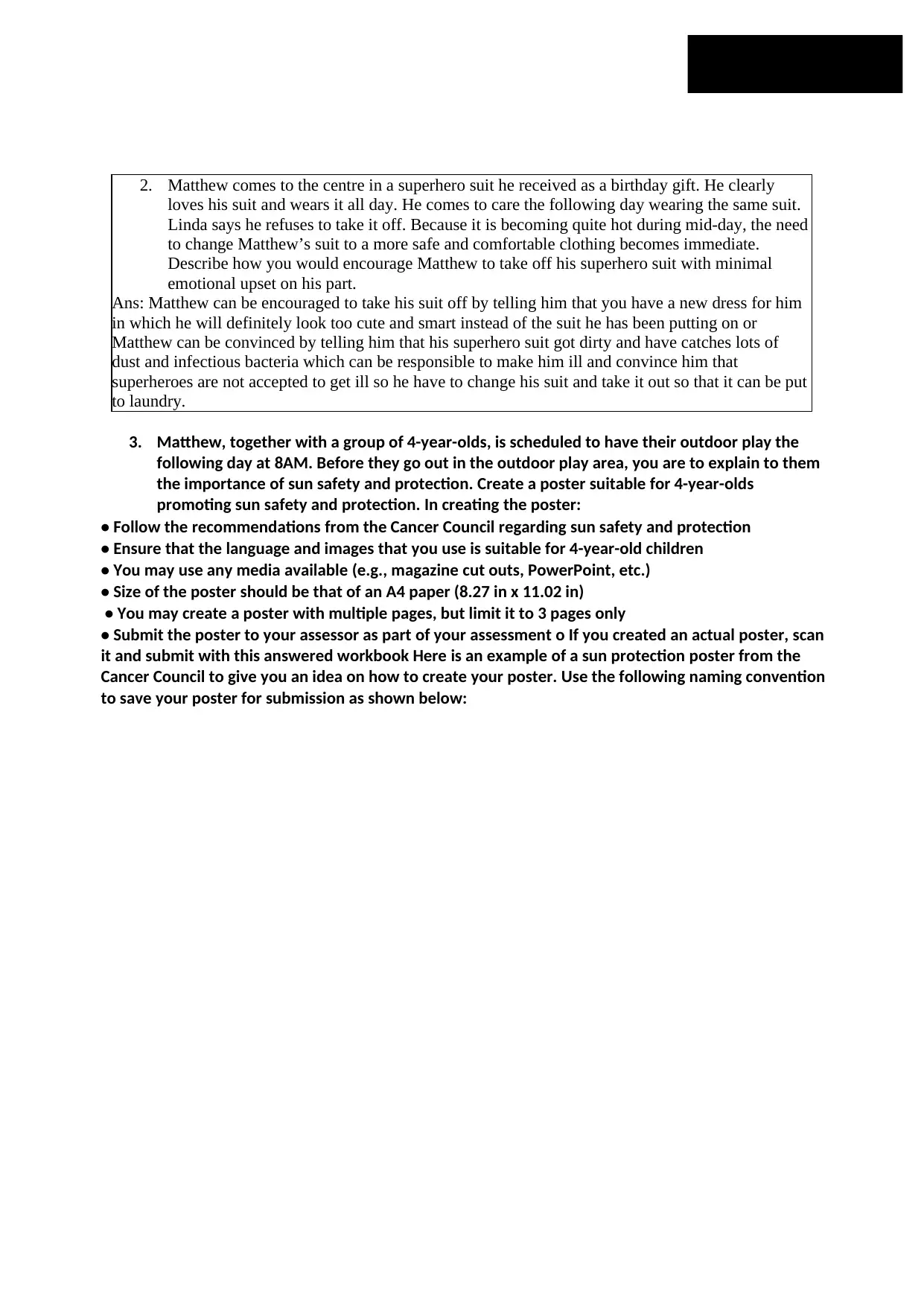
2. Matthew comes to the centre in a superhero suit he received as a birthday gift. He clearly
loves his suit and wears it all day. He comes to care the following day wearing the same suit.
Linda says he refuses to take it off. Because it is becoming quite hot during mid-day, the need
to change Matthew’s suit to a more safe and comfortable clothing becomes immediate.
Describe how you would encourage Matthew to take off his superhero suit with minimal
emotional upset on his part.
Ans: Matthew can be encouraged to take his suit off by telling him that you have a new dress for him
in which he will definitely look too cute and smart instead of the suit he has been putting on or
Matthew can be convinced by telling him that his superhero suit got dirty and have catches lots of
dust and infectious bacteria which can be responsible to make him ill and convince him that
superheroes are not accepted to get ill so he have to change his suit and take it out so that it can be put
to laundry.
3. Matthew, together with a group of 4-year-olds, is scheduled to have their outdoor play the
following day at 8AM. Before they go out in the outdoor play area, you are to explain to them
the importance of sun safety and protection. Create a poster suitable for 4-year-olds
promoting sun safety and protection. In creating the poster:
• Follow the recommendations from the Cancer Council regarding sun safety and protection
• Ensure that the language and images that you use is suitable for 4-year-old children
• You may use any media available (e.g., magazine cut outs, PowerPoint, etc.)
• Size of the poster should be that of an A4 paper (8.27 in x 11.02 in)
• You may create a poster with multiple pages, but limit it to 3 pages only
• Submit the poster to your assessor as part of your assessment o If you created an actual poster, scan
it and submit with this answered workbook Here is an example of a sun protection poster from the
Cancer Council to give you an idea on how to create your poster. Use the following naming convention
to save your poster for submission as shown below:
loves his suit and wears it all day. He comes to care the following day wearing the same suit.
Linda says he refuses to take it off. Because it is becoming quite hot during mid-day, the need
to change Matthew’s suit to a more safe and comfortable clothing becomes immediate.
Describe how you would encourage Matthew to take off his superhero suit with minimal
emotional upset on his part.
Ans: Matthew can be encouraged to take his suit off by telling him that you have a new dress for him
in which he will definitely look too cute and smart instead of the suit he has been putting on or
Matthew can be convinced by telling him that his superhero suit got dirty and have catches lots of
dust and infectious bacteria which can be responsible to make him ill and convince him that
superheroes are not accepted to get ill so he have to change his suit and take it out so that it can be put
to laundry.
3. Matthew, together with a group of 4-year-olds, is scheduled to have their outdoor play the
following day at 8AM. Before they go out in the outdoor play area, you are to explain to them
the importance of sun safety and protection. Create a poster suitable for 4-year-olds
promoting sun safety and protection. In creating the poster:
• Follow the recommendations from the Cancer Council regarding sun safety and protection
• Ensure that the language and images that you use is suitable for 4-year-old children
• You may use any media available (e.g., magazine cut outs, PowerPoint, etc.)
• Size of the poster should be that of an A4 paper (8.27 in x 11.02 in)
• You may create a poster with multiple pages, but limit it to 3 pages only
• Submit the poster to your assessor as part of your assessment o If you created an actual poster, scan
it and submit with this answered workbook Here is an example of a sun protection poster from the
Cancer Council to give you an idea on how to create your poster. Use the following naming convention
to save your poster for submission as shown below:
Paraphrase This Document
Need a fresh take? Get an instant paraphrase of this document with our AI Paraphraser
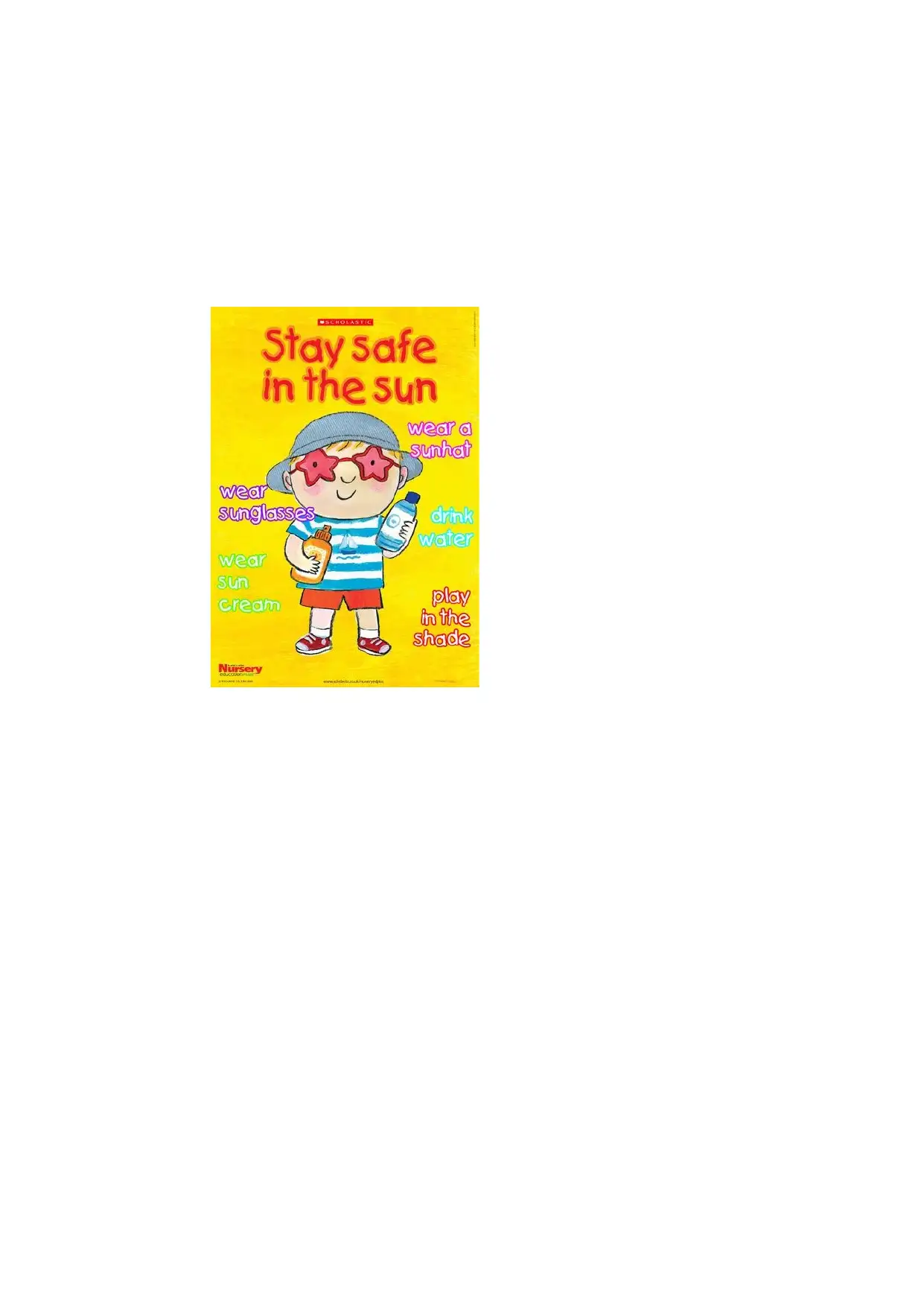

Checkpoint
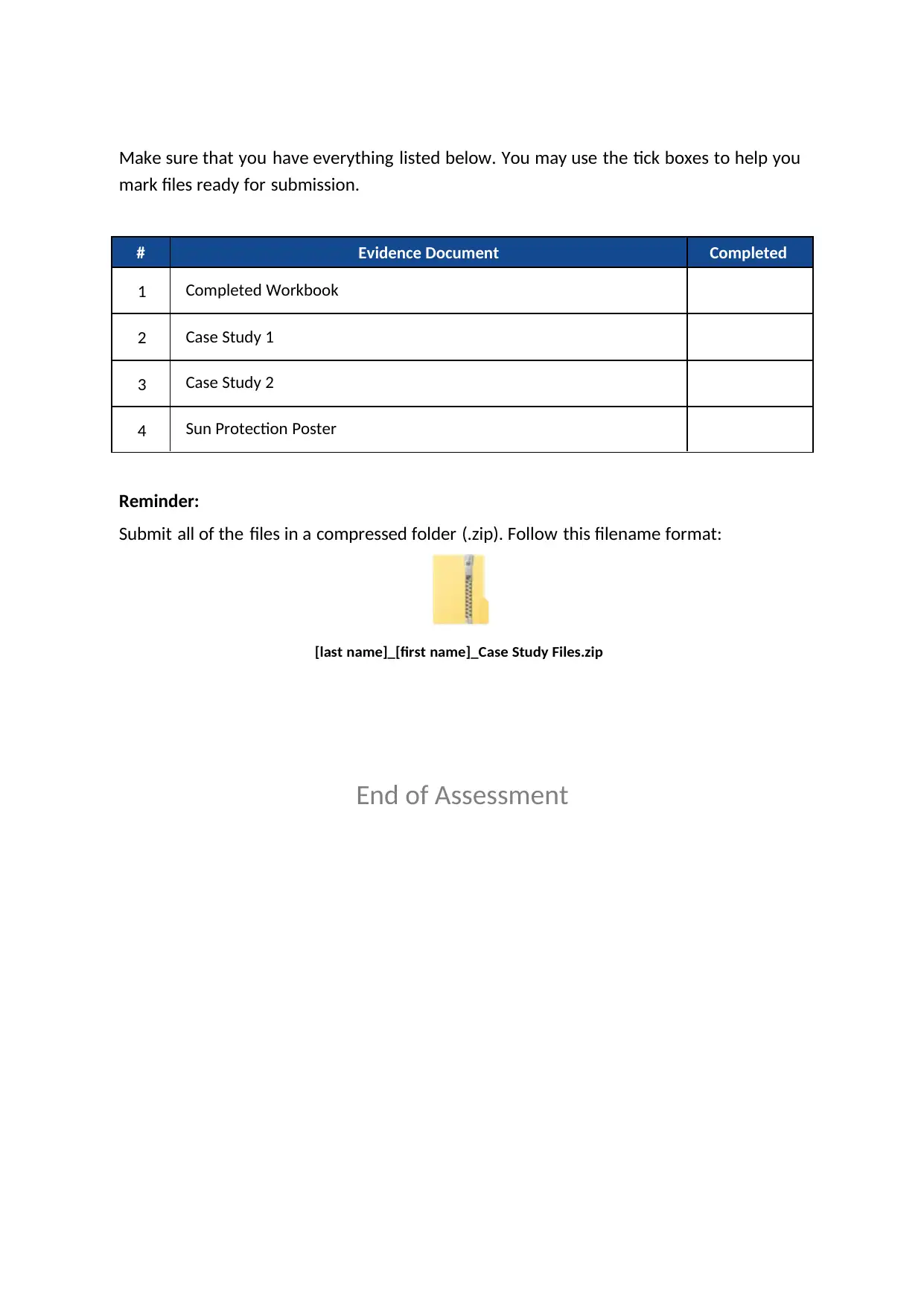
Make sure that you have everything listed below. You may use the tick boxes to help you
mark files ready for submission.
# Evidence Document Completed
1 Completed Workbook
2 Case Study 1
3 Case Study 2
4 Sun Protection Poster
Reminder:
Submit all of the files in a compressed folder (.zip). Follow this filename format:
[last name]_[first name]_Case Study Files.zip
End of Assessment
mark files ready for submission.
# Evidence Document Completed
1 Completed Workbook
2 Case Study 1
3 Case Study 2
4 Sun Protection Poster
Reminder:
Submit all of the files in a compressed folder (.zip). Follow this filename format:
[last name]_[first name]_Case Study Files.zip
End of Assessment
Secure Best Marks with AI Grader
Need help grading? Try our AI Grader for instant feedback on your assignments.
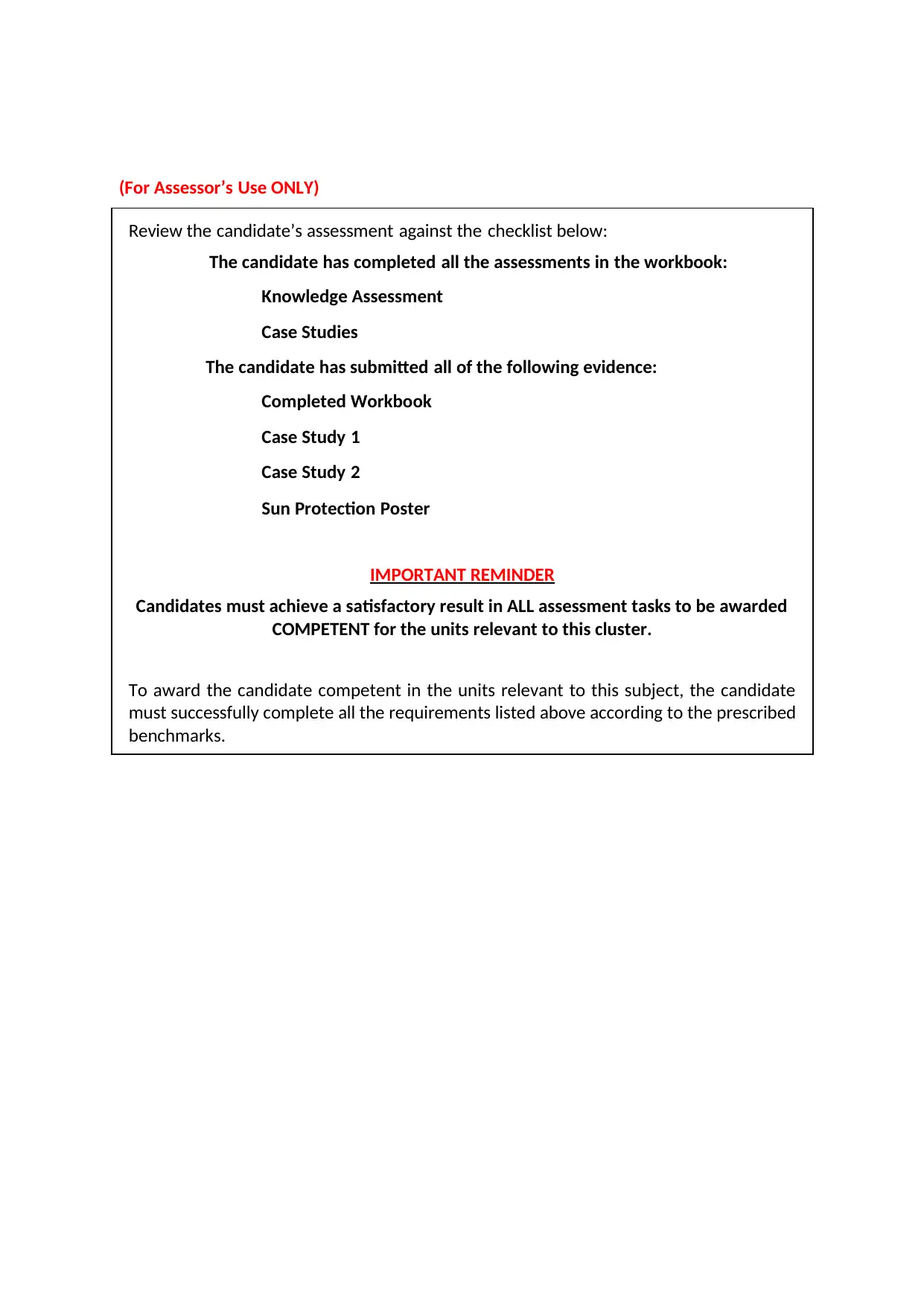
(For Assessor’s Use ONLY)
Review the candidate’s assessment against the checklist below:
The candidate has completed all the assessments in the workbook:
Knowledge Assessment
Case Studies
The candidate has submitted all of the following evidence:
Completed Workbook
Case Study 1
Case Study 2
Sun Protection Poster
IMPORTANT REMINDER
Candidates must achieve a satisfactory result in ALL assessment tasks to be awarded
COMPETENT for the units relevant to this cluster.
To award the candidate competent in the units relevant to this subject, the candidate
must successfully complete all the requirements listed above according to the prescribed
benchmarks.
Review the candidate’s assessment against the checklist below:
The candidate has completed all the assessments in the workbook:
Knowledge Assessment
Case Studies
The candidate has submitted all of the following evidence:
Completed Workbook
Case Study 1
Case Study 2
Sun Protection Poster
IMPORTANT REMINDER
Candidates must achieve a satisfactory result in ALL assessment tasks to be awarded
COMPETENT for the units relevant to this cluster.
To award the candidate competent in the units relevant to this subject, the candidate
must successfully complete all the requirements listed above according to the prescribed
benchmarks.
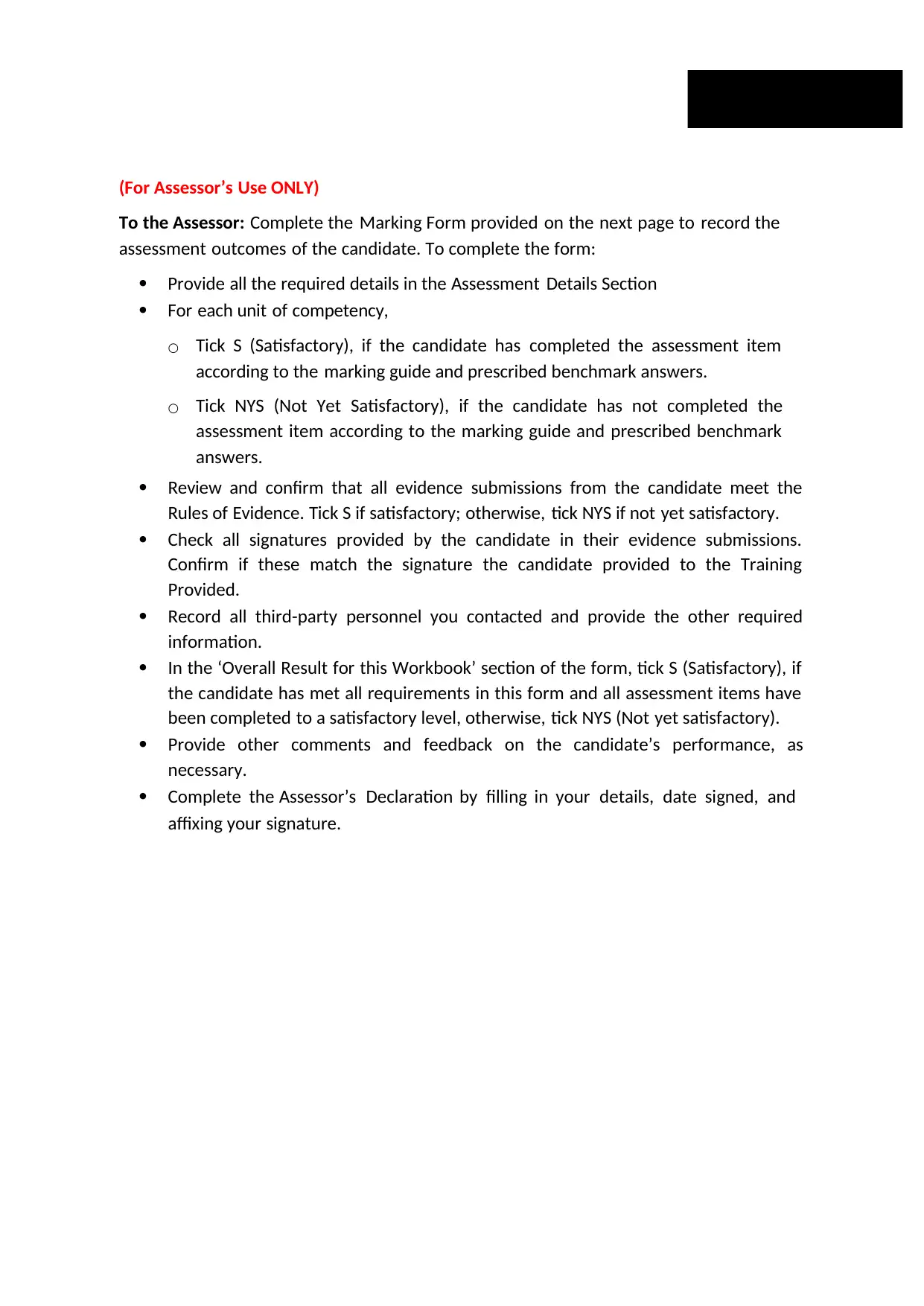
(For Assessor’s Use ONLY)
To the Assessor: Complete the Marking Form provided on the next page to record the
assessment outcomes of the candidate. To complete the form:
Provide all the required details in the Assessment Details Section
For each unit of competency,
○ Tick S (Satisfactory), if the candidate has completed the assessment item
according to the marking guide and prescribed benchmark answers.
○ Tick NYS (Not Yet Satisfactory), if the candidate has not completed the
assessment item according to the marking guide and prescribed benchmark
answers.
Review and confirm that all evidence submissions from the candidate meet the
Rules of Evidence. Tick S if satisfactory; otherwise, tick NYS if not yet satisfactory.
Check all signatures provided by the candidate in their evidence submissions.
Confirm if these match the signature the candidate provided to the Training
Provided.
Record all third-party personnel you contacted and provide the other required
information.
In the ‘Overall Result for this Workbook’ section of the form, tick S (Satisfactory), if
the candidate has met all requirements in this form and all assessment items have
been completed to a satisfactory level, otherwise, tick NYS (Not yet satisfactory).
Provide other comments and feedback on the candidate’s performance, as
necessary.
Complete the Assessor’s Declaration by filling in your details, date signed, and
affixing your signature.
To the Assessor: Complete the Marking Form provided on the next page to record the
assessment outcomes of the candidate. To complete the form:
Provide all the required details in the Assessment Details Section
For each unit of competency,
○ Tick S (Satisfactory), if the candidate has completed the assessment item
according to the marking guide and prescribed benchmark answers.
○ Tick NYS (Not Yet Satisfactory), if the candidate has not completed the
assessment item according to the marking guide and prescribed benchmark
answers.
Review and confirm that all evidence submissions from the candidate meet the
Rules of Evidence. Tick S if satisfactory; otherwise, tick NYS if not yet satisfactory.
Check all signatures provided by the candidate in their evidence submissions.
Confirm if these match the signature the candidate provided to the Training
Provided.
Record all third-party personnel you contacted and provide the other required
information.
In the ‘Overall Result for this Workbook’ section of the form, tick S (Satisfactory), if
the candidate has met all requirements in this form and all assessment items have
been completed to a satisfactory level, otherwise, tick NYS (Not yet satisfactory).
Provide other comments and feedback on the candidate’s performance, as
necessary.
Complete the Assessor’s Declaration by filling in your details, date signed, and
affixing your signature.
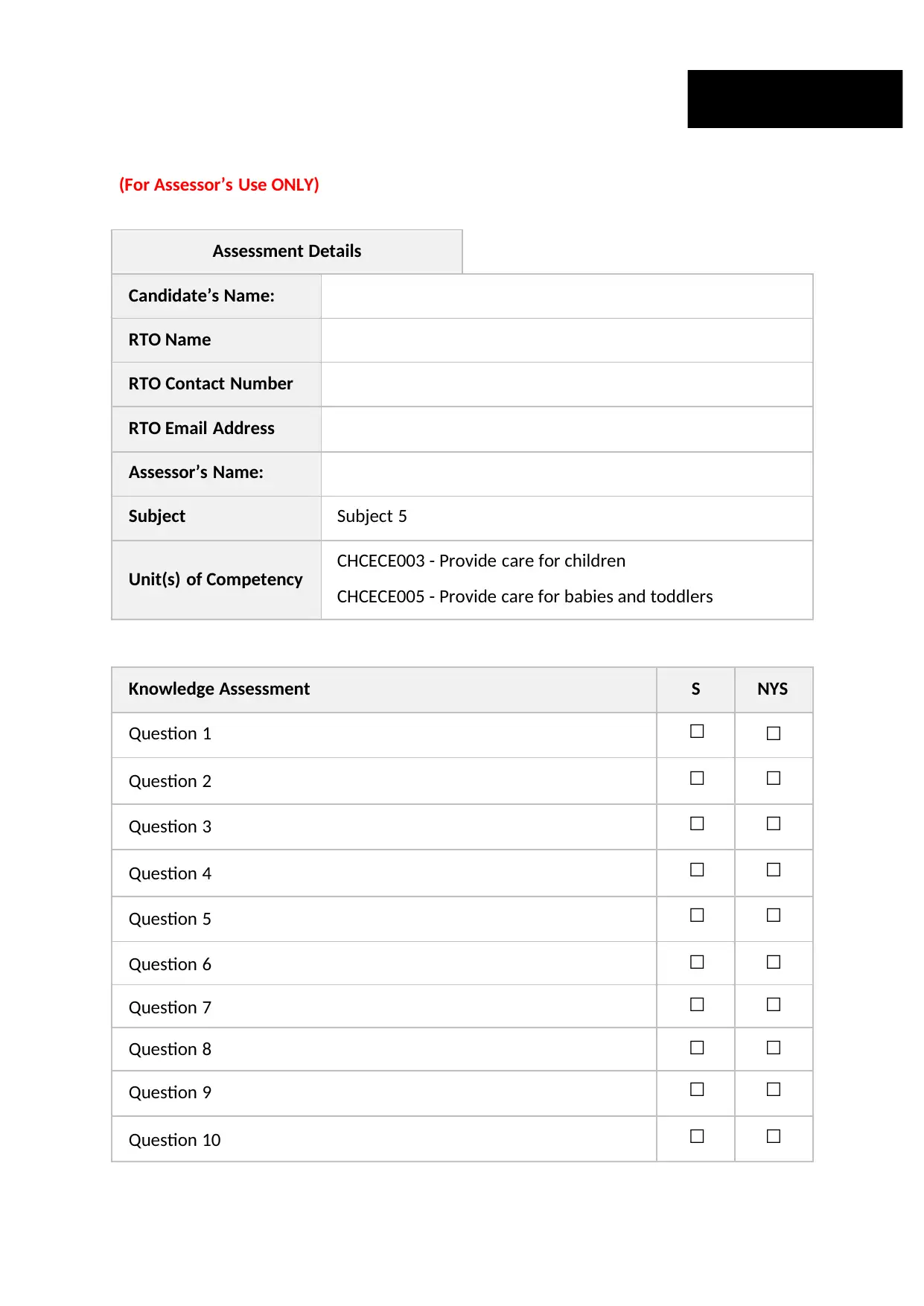
OVERALL MARKING RESULT FORM
(For Assessor’s Use ONLY)
Assessment Details
Candidate’s Name:
RTO Name
RTO Contact Number
RTO Email Address
Assessor’s Name:
Subject Subject 5
Unit(s) of Competency
CHCECE003 - Provide care for children
CHCECE005 - Provide care for babies and toddlers
Knowledge Assessment S NYS
Question 1 ☐ ☐
Question 2 ☐ ☐
Question 3 ☐ ☐
Question 4 ☐ ☐
Question 5 ☐ ☐
Question 6 ☐ ☐
Question 7 ☐ ☐
Question 8 ☐ ☐
Question 9 ☐ ☐
Question 10 ☐ ☐
(For Assessor’s Use ONLY)
Assessment Details
Candidate’s Name:
RTO Name
RTO Contact Number
RTO Email Address
Assessor’s Name:
Subject Subject 5
Unit(s) of Competency
CHCECE003 - Provide care for children
CHCECE005 - Provide care for babies and toddlers
Knowledge Assessment S NYS
Question 1 ☐ ☐
Question 2 ☐ ☐
Question 3 ☐ ☐
Question 4 ☐ ☐
Question 5 ☐ ☐
Question 6 ☐ ☐
Question 7 ☐ ☐
Question 8 ☐ ☐
Question 9 ☐ ☐
Question 10 ☐ ☐
Paraphrase This Document
Need a fresh take? Get an instant paraphrase of this document with our AI Paraphraser
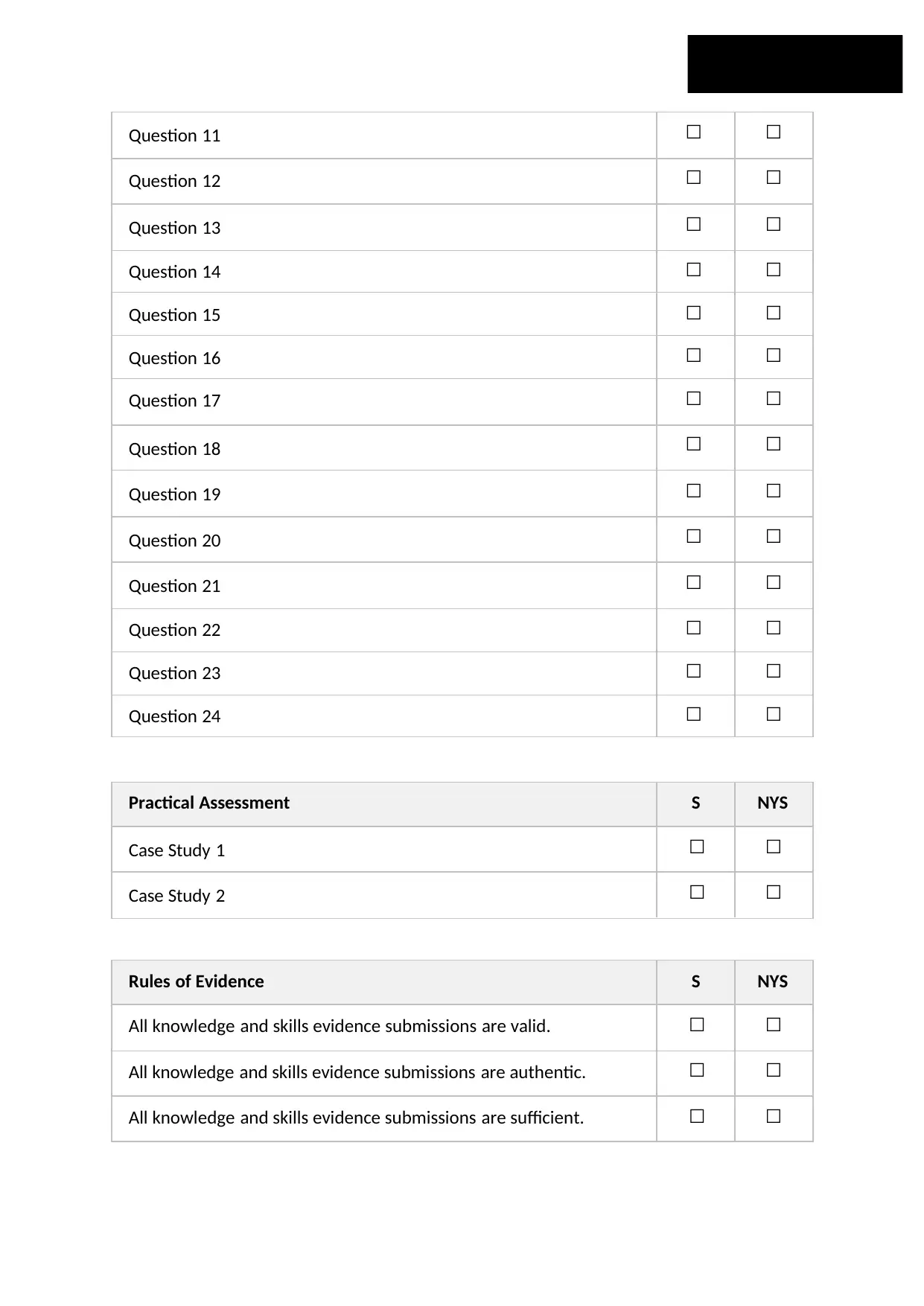
Question 11 ☐ ☐
Question 12 ☐ ☐
Question 13 ☐ ☐
Question 14 ☐ ☐
Question 15 ☐ ☐
Question 16 ☐ ☐
Question 17 ☐ ☐
Question 18 ☐ ☐
Question 19 ☐ ☐
Question 20 ☐ ☐
Question 21 ☐ ☐
Question 22 ☐ ☐
Question 23 ☐ ☐
Question 24 ☐ ☐
Practical Assessment S NYS
Case Study 1 ☐ ☐
Case Study 2 ☐ ☐
Rules of Evidence S NYS
All knowledge and skills evidence submissions are valid. ☐ ☐
All knowledge and skills evidence submissions are authentic. ☐ ☐
All knowledge and skills evidence submissions are sufficient. ☐ ☐
Question 12 ☐ ☐
Question 13 ☐ ☐
Question 14 ☐ ☐
Question 15 ☐ ☐
Question 16 ☐ ☐
Question 17 ☐ ☐
Question 18 ☐ ☐
Question 19 ☐ ☐
Question 20 ☐ ☐
Question 21 ☐ ☐
Question 22 ☐ ☐
Question 23 ☐ ☐
Question 24 ☐ ☐
Practical Assessment S NYS
Case Study 1 ☐ ☐
Case Study 2 ☐ ☐
Rules of Evidence S NYS
All knowledge and skills evidence submissions are valid. ☐ ☐
All knowledge and skills evidence submissions are authentic. ☐ ☐
All knowledge and skills evidence submissions are sufficient. ☐ ☐
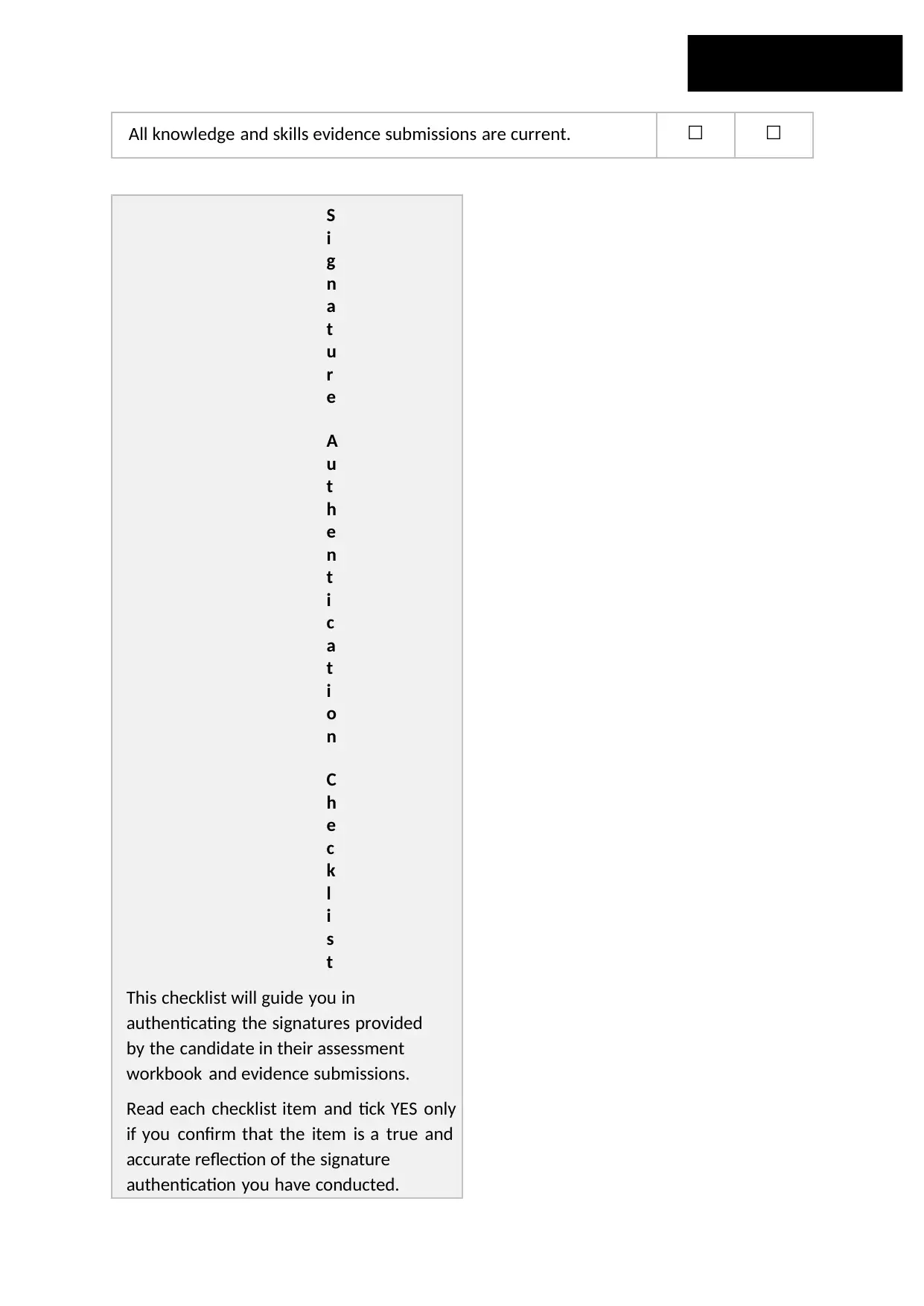
All knowledge and skills evidence submissions are current. ☐ ☐
S
i
g
n
a
t
u
r
e
A
u
t
h
e
n
t
i
c
a
t
i
o
n
C
h
e
c
k
l
i
s
t
This checklist will guide you in
authenticating the signatures provided
by the candidate in their assessment
workbook and evidence submissions.
Read each checklist item and tick YES only
if you confirm that the item is a true and
accurate reflection of the signature
authentication you have conducted.
S
i
g
n
a
t
u
r
e
A
u
t
h
e
n
t
i
c
a
t
i
o
n
C
h
e
c
k
l
i
s
t
This checklist will guide you in
authenticating the signatures provided
by the candidate in their assessment
workbook and evidence submissions.
Read each checklist item and tick YES only
if you confirm that the item is a true and
accurate reflection of the signature
authentication you have conducted.

Checklist Item Check if
completed
I confirm ALL signatures provided by the candidate in their evidence
submissions match with the signature they provided to the Training
Provider
☐
completed
I confirm ALL signatures provided by the candidate in their evidence
submissions match with the signature they provided to the Training
Provider
☐
Secure Best Marks with AI Grader
Need help grading? Try our AI Grader for instant feedback on your assignments.
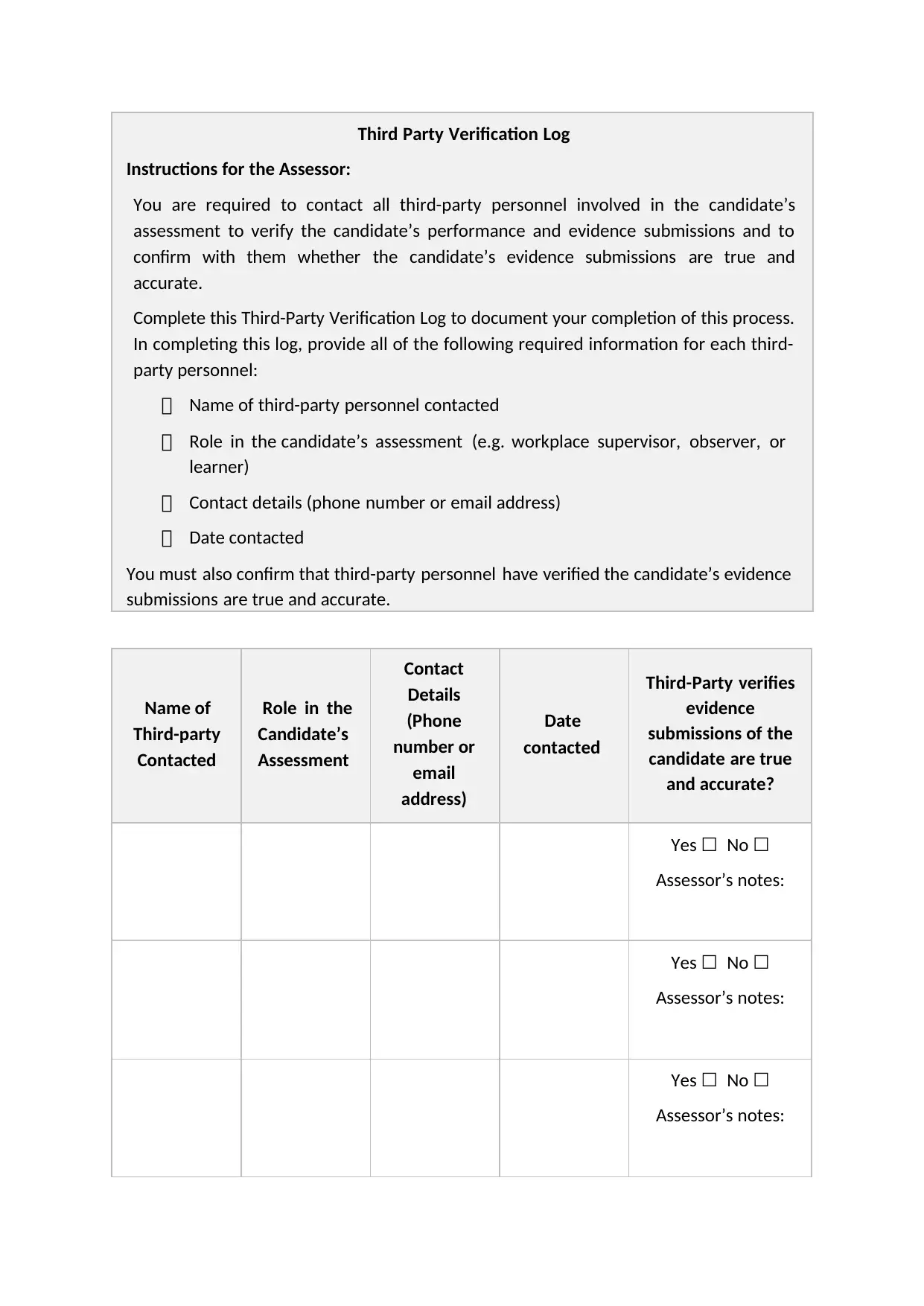
Third Party Verification Log
Instructions for the Assessor:
You are required to contact all third-party personnel involved in the candidate’s
assessment to verify the candidate’s performance and evidence submissions and to
confirm with them whether the candidate’s evidence submissions are true and
accurate.
Complete this Third-Party Verification Log to document your completion of this process.
In completing this log, provide all of the following required information for each third-
party personnel:
Name of third-party personnel contacted
Role in the candidate’s assessment (e.g. workplace supervisor, observer, or
learner)
Contact details (phone number or email address)
Date contacted
You must also confirm that third-party personnel have verified the candidate’s evidence
submissions are true and accurate.
Name of
Third-party
Contacted
Role in the
Candidate’s
Assessment
Contact
Details
(Phone
number or
email
address)
Date
contacted
Third-Party verifies
evidence
submissions of the
candidate are true
and accurate?
Yes ☐ No ☐
Assessor’s notes:
Yes ☐ No ☐
Assessor’s notes:
Yes ☐ No ☐
Assessor’s notes:
Instructions for the Assessor:
You are required to contact all third-party personnel involved in the candidate’s
assessment to verify the candidate’s performance and evidence submissions and to
confirm with them whether the candidate’s evidence submissions are true and
accurate.
Complete this Third-Party Verification Log to document your completion of this process.
In completing this log, provide all of the following required information for each third-
party personnel:
Name of third-party personnel contacted
Role in the candidate’s assessment (e.g. workplace supervisor, observer, or
learner)
Contact details (phone number or email address)
Date contacted
You must also confirm that third-party personnel have verified the candidate’s evidence
submissions are true and accurate.
Name of
Third-party
Contacted
Role in the
Candidate’s
Assessment
Contact
Details
(Phone
number or
address)
Date
contacted
Third-Party verifies
evidence
submissions of the
candidate are true
and accurate?
Yes ☐ No ☐
Assessor’s notes:
Yes ☐ No ☐
Assessor’s notes:
Yes ☐ No ☐
Assessor’s notes:
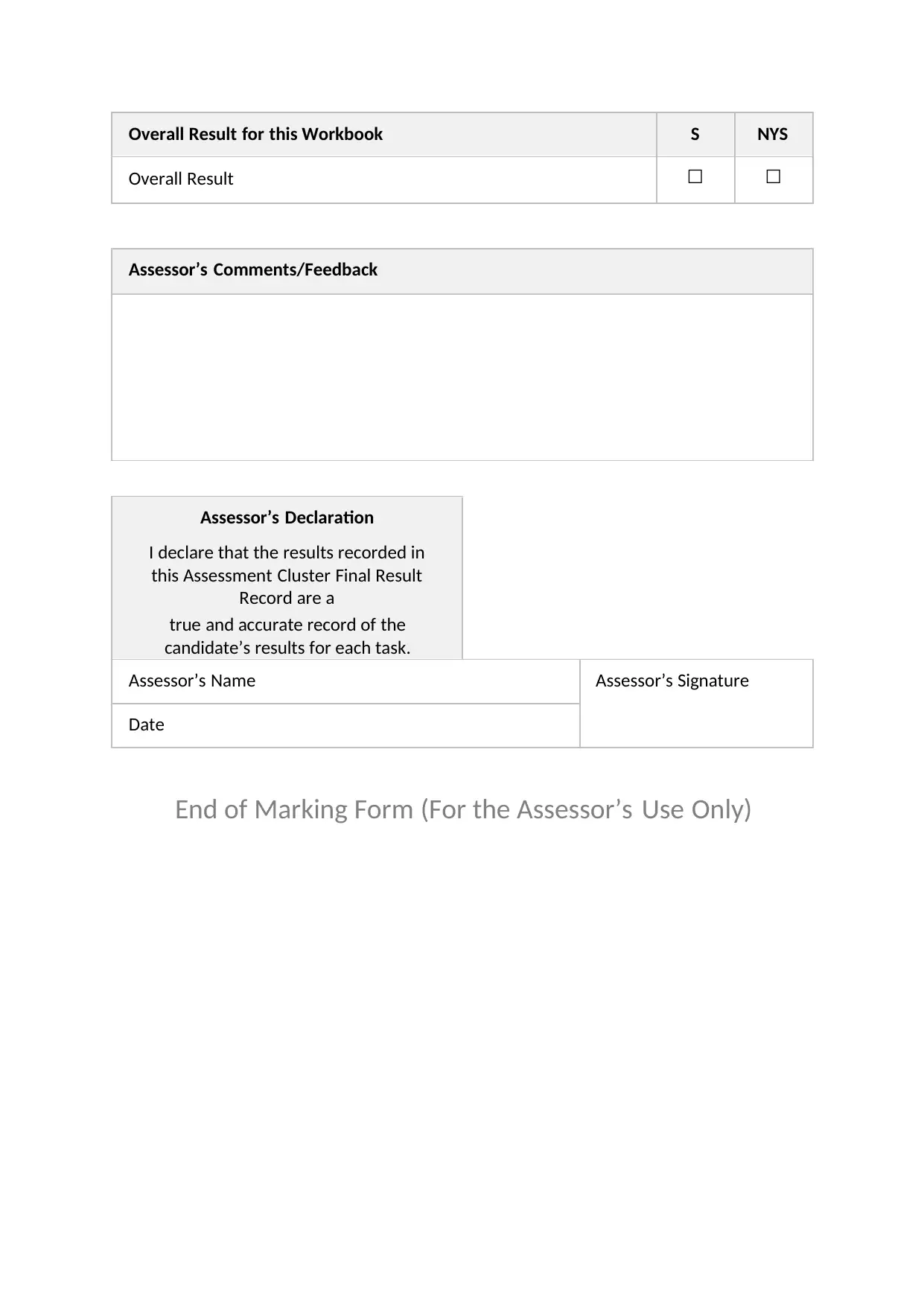
Overall Result for this Workbook S NYS
Overall Result ☐ ☐
Assessor’s Comments/Feedback
Assessor’s Declaration
I declare that the results recorded in
this Assessment Cluster Final Result
Record are a
true and accurate record of the
candidate’s results for each task.
Assessor’s Name Assessor’s Signature
Date
End of Marking Form (For the Assessor’s Use Only)
Overall Result ☐ ☐
Assessor’s Comments/Feedback
Assessor’s Declaration
I declare that the results recorded in
this Assessment Cluster Final Result
Record are a
true and accurate record of the
candidate’s results for each task.
Assessor’s Name Assessor’s Signature
Date
End of Marking Form (For the Assessor’s Use Only)

Inspire Education is committed to ensuring you get the most out of your student experience
with us. Part of your Learning Journey is the use of our contextualised learning materials
and assessment workbooks. We would love to get your feedback on how this material
worked for you.
End of Document
with us. Part of your Learning Journey is the use of our contextualised learning materials
and assessment workbooks. We would love to get your feedback on how this material
worked for you.
End of Document
1 out of 49
Related Documents
Your All-in-One AI-Powered Toolkit for Academic Success.
+13062052269
info@desklib.com
Available 24*7 on WhatsApp / Email
![[object Object]](/_next/static/media/star-bottom.7253800d.svg)
Unlock your academic potential
© 2024 | Zucol Services PVT LTD | All rights reserved.





